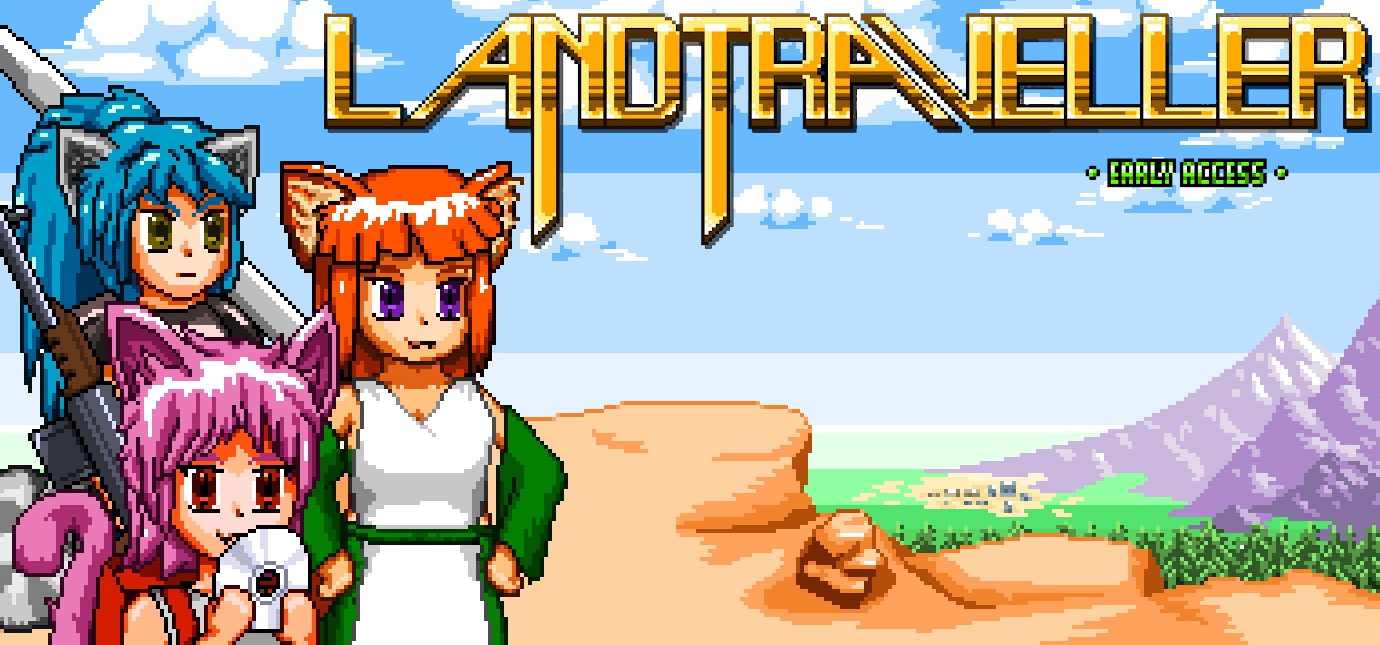Become a catgirl. See the world. Exterminate thousands of fluffy creatures.
Type: Single-player, Multiplayer
Genre: RPG, Action, Open-World Sandbox
Developer: WolfCoder Workshop
Publisher: WOLFCODER WORKSHOP LLC
Release date: 9 June, 2017


Intro
Oftentimes, I have heard Terraria described as a “2d Minecraft”, but that’s not really doing the styles of the games justice. Minecraft is a wide open sandbox that just happens to have combat in it if you want to try to keep the sandbox a little more guided. Terraria is a game about killing monsters and taking their stuff that also has a sandbox as a co-equal gameplay focus. LandTraveller, then, is a game that goes even further, being a 3D Terraria with the top-down perspective of a 2D Legend of Zelda game that puts killing monsters at the front of its game, while also having some aspects of sandbox gameplay still lingering in the background.
LandTraveller winds up being something of a Frankenstein’s Monster of odd genre parts and mechanics that oftentimes fight against one another. Certain major game mechanics that most games would lean into are left almost forgotten, such as the entire base-building aspect of the game being essentially useless in Story Mode. It’s an incongruent game made of random mechanics that appealed to the developer without a cohesive gameplay loop in mind to bring everything together. This is the sort of method many games that are made to follow up on some more popular game use, which usually results in disaster as mechanics are used outside the context of why they existed in those more popular games. (For example, the many awful survival meter games littering Steam rarely understand how to turn a depleting bar into meaningful gameplay, and instead make players drink their own body weight in water each hour or die. Also, they make water never respawn, so there’s a finite amount of it in the game world.) So far, the LandTraveller’s developer seems to be playing it by ear, and at least seems willing to alter the elements that cause the most frustration, but it is still an open question if the game might go off-track or even start blending into entirely new genres as new elements are added to the game.
The Four Horsemen
Probably the first thing worth addressing are those four little tags of doom, “Crafting”, “Open World”, “Survival”, “Early Access”. Well, it’s not one of those, because it’s missing “Survival”, so ha! But to put the technicalities aside, the real issue with CURSE (one of the not-quite acronyms for games with these tags) games is that they are almost always overly ambitious projects from very small teams that inevitably split up after failing to appreciate the amount of time and effort it would take to complete the game they are setting out to make.
Like many Steam indie trends, these became a subgenre in the wake of a few (at least superficially) successful indie games, spawning a wave of people who thought that their own take on that same concept would be something within their reach. Then, the abandoned projects pile up faster than successes do, and the trend cools down after a few years.
Well, with regards to LandTraveller, the developer is a single person (which is good from the point of view of not having a team that can split up over creative or personal differences) who seems stubbornly committed to their vision. This version of the game is made on a self-built engine and has been in development since 2015, with an older version of the game worked on since 2012. The latest stable release was in April of 2020, while as of writing this, the Beta track has two new maps, several new weapons and monsters, the addition of ships, and some serious quality of life improvements. Stable releases are far between, but beta updates are frequent, and it’s obvious the developer is actively working and responses to bug reports are generally prompt, so I have little worries about this becoming abandonware without some major life disruption for the developer.
Land Traveling
LandTraveller is a game based around procedurally-generated terrain. Unlike a game like Minecraft, however, each map is limited in scope. While this may seem like it constrains a player, the fact that there are a set number of landmarks and a completion percentage actually push the player towards… well, traveling over all the land in each game for completion’s sake.
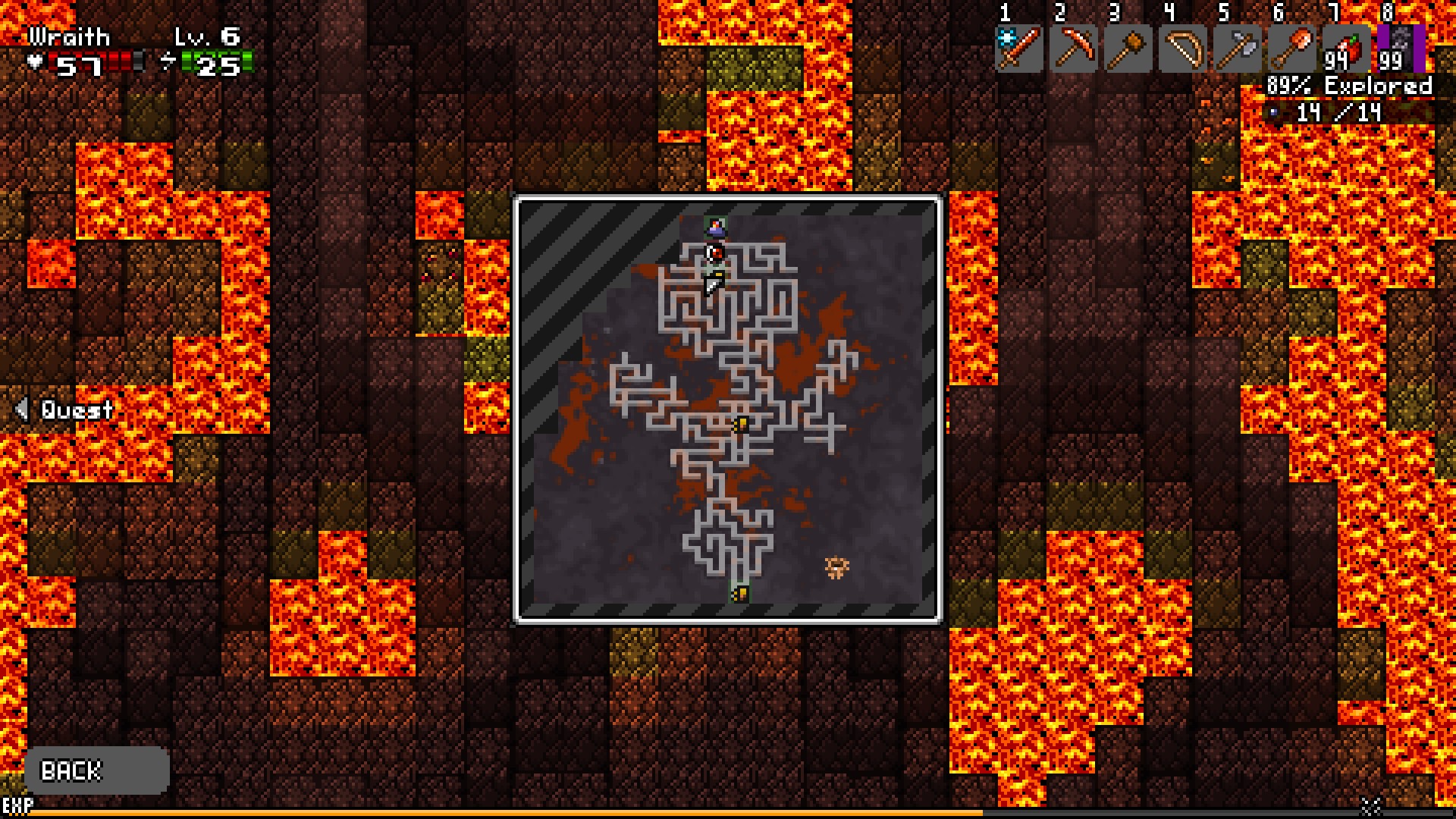
You do this for more than just completionism’s own sake, however. (Or well, other people will, I sure have been bitten by the completionism bug.) The game is also built around crafting, but most of the game’s recipes are locked out until you uncover their secrets in the “knowledge menu”. This is a series of crafting recipes that are unlocked only by using an era-specific form of recording knowledge. (That is, a clay tablet, a scroll, a tome, etc.)
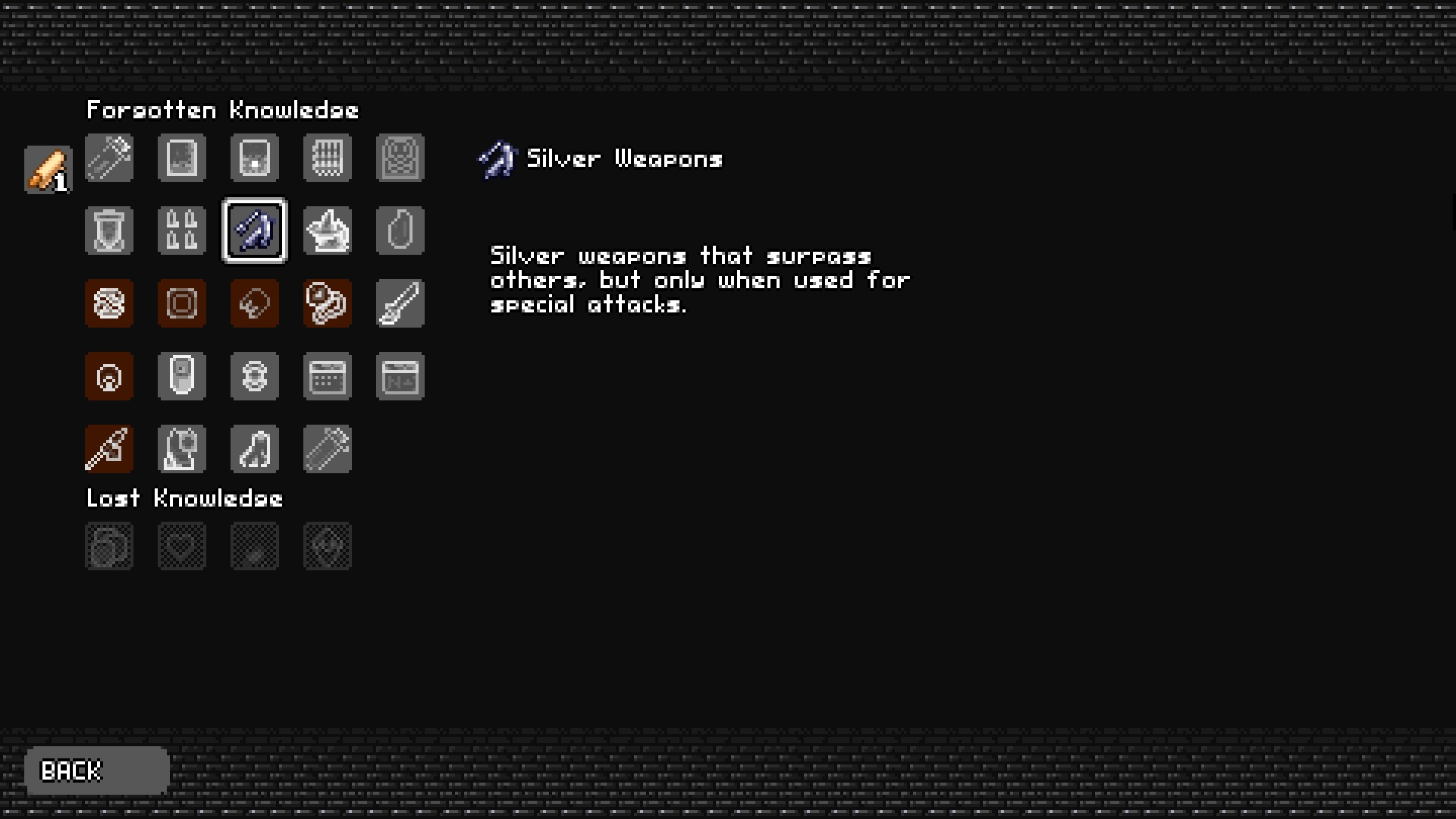
With the exception of clay tablets (whose fragments can be found buried in the ground), these records can only be found in the “landmarks” that are scattered across the map, which directly ties your ability to equip your character to the amount of land you have traveled and scoured for lootable landmarks. “Lost knowledge” are specific unlocks that are “hidden” in unique landmarks, although in practice few of these are more difficult to find than any other landmark. Lost knowledge, however, comes from specific record objects, so failing to find the specific unique landmark means that even if you have plenty of spare records, you cannot unlock them.
Each map tile is similar to a Minecraft “chunk”, 32 by 32 by 32 blocks, and a given map can be as large as 24 by 24 map tiles, although some plot event-related ones are as small as 2 by 2 map tiles. Within a single map, chunks are loaded and saved seamlessly, although portions of the area’s map are revealed in the map menu by the chunk, so you tend to be a little more aware of them.
Each chapter features a “main map” to explore, plus a “boss area map”, as well as a few smaller maps in later chapters. In chapter 3, for example, the boss is atop a mountain, and climbing the mountain requires going through three smaller maps that represent different elevations on the mountain path. Each map tends to have a theme or gimmick, so the chapter 1 boss area map is a volcano filled with lava, while the boss area map in chapter 3 is a snow-covered mountain.
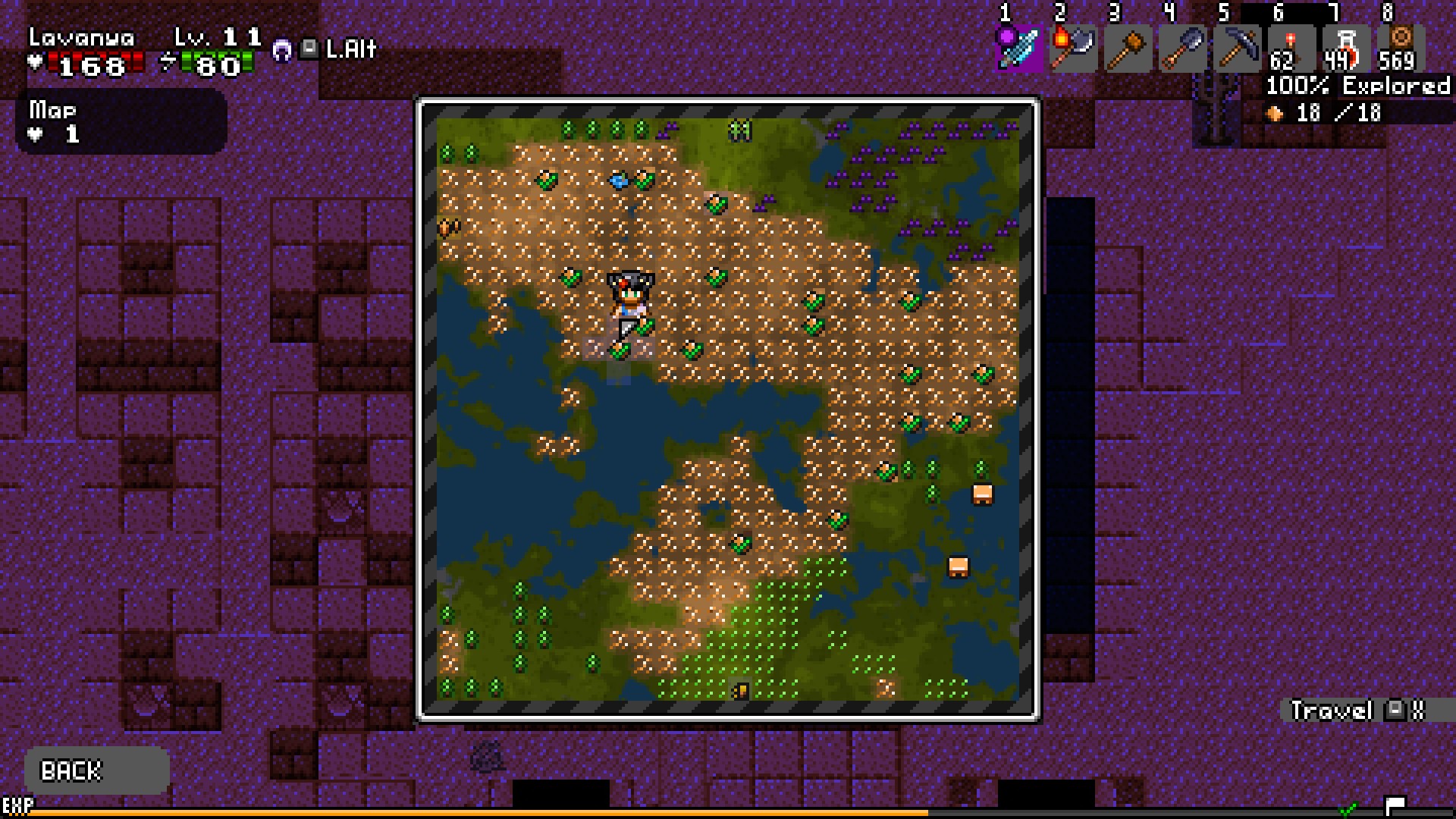
Each chapter also covers a particular “Age” of history, following an epochal categorization of history. Chapter 1 is the “Stone Age” and your main tools are either wood, copper, tin, or obsidian. Killing the boss instantly unveils the next “Age”, so killing the chapter 1 boss allows you to instantly know how to smelt copper and tin into bronze. Obviously, a rather “video-gamey” take on history. (In story mode, advancing to the next chapter’s map is gated by killing the boss, but explore mode will let you advance to an area with harder monsters and no more advanced tools to fight them. Also, in story mode, you can’t bring any technology back with you. The Stone Age Wolf Tribe that is barely surviving the weakest monsters in the game has no interest in your steel armor and weaponry.)
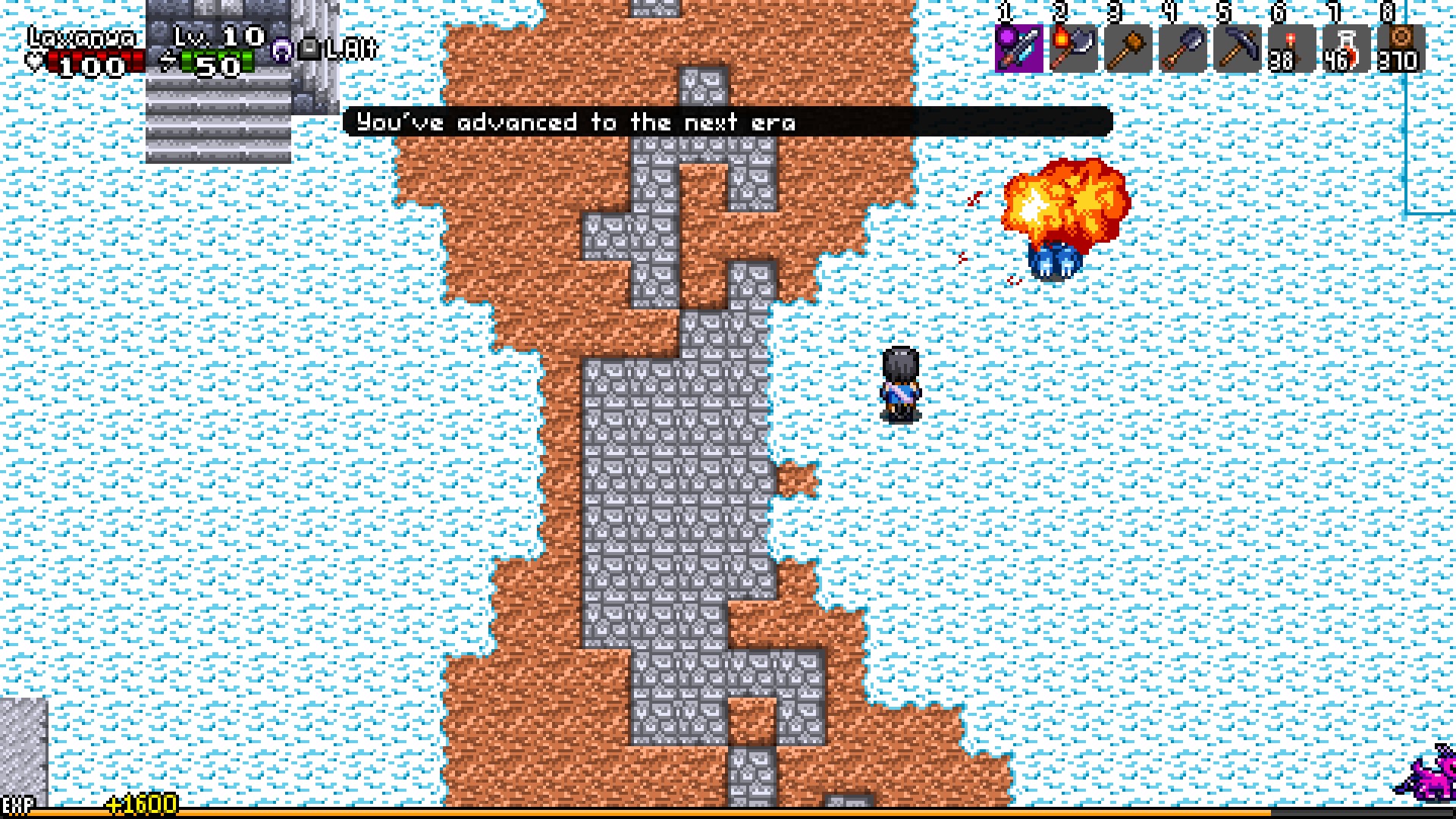
This effectively is the rhythm of LandTraveller – you enter a new chapter, explore the area for landmarks for technology unlocks (as well as fast travel points to make the travel slog less tedious), unlock technologies and craft new gear to counter new enemies, fill in the map and perform any side-tasks, then go into the boss area (clearing that map’s landmarks, as well), kill the boss, and keep on trucking. Due to the sheer amount of land to travel, this is much faster said than done.
“Setpiece” Landmarks
One thing to note is that while most of the game is procedural, landmarks are not. Some of the most common ones, like caves, come in sets of a half dozen varieties (and the stone in caves can have ore deposits that are procedurally added to all stone) so that you aren’t entering from the northwest side of every cave, but most are seemingly deliberately as close to identical as possible, with pyramids even having traps in the exact same spot, making them less than exactly surprising.
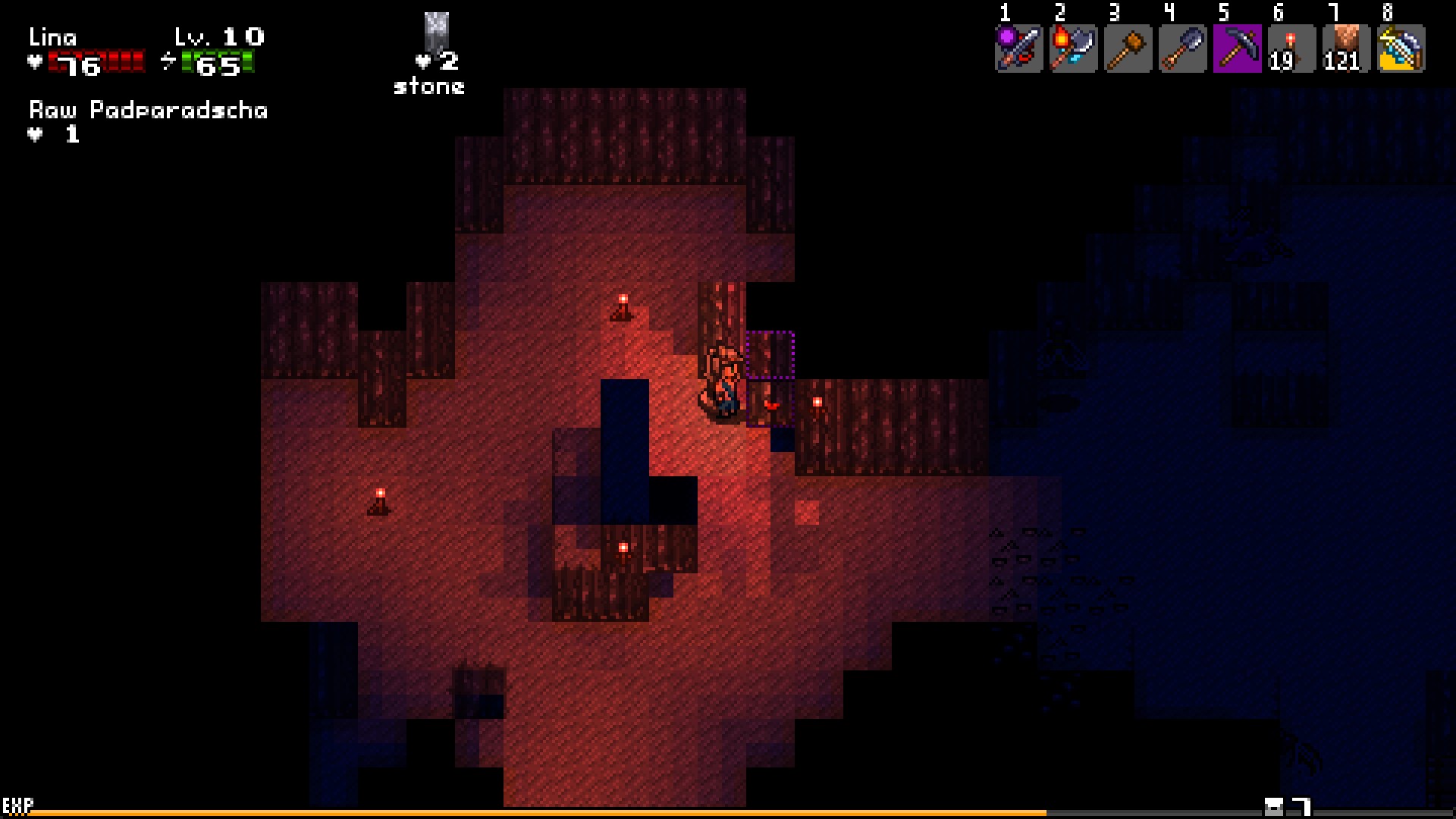
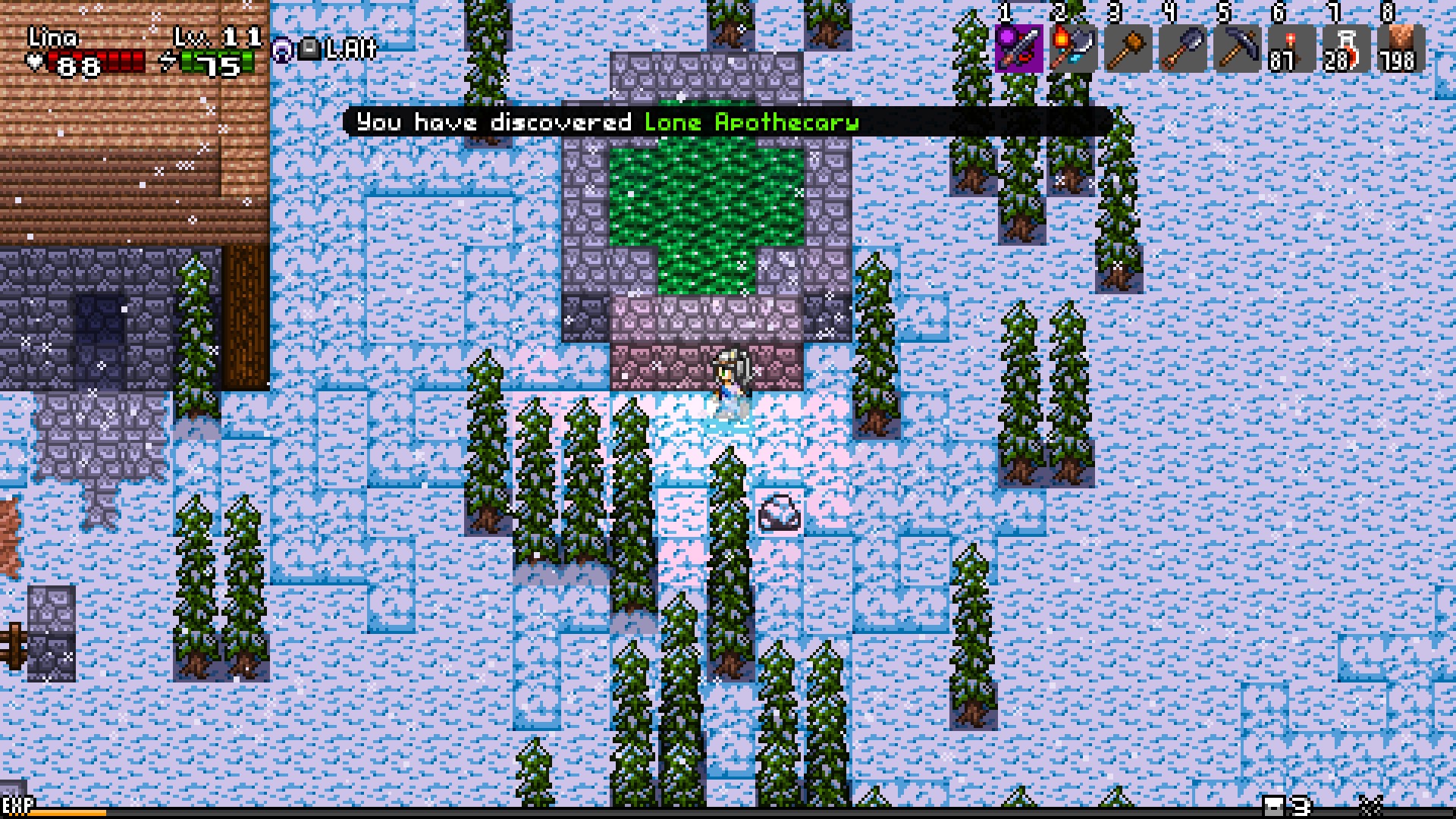
This can really suck the mystery out of repeat playthroughs. Because you probably want to play both a story mode and an explore mode game, if not also a multiplayer game, and each mode needs its own saves, seeing the exact same places in every game can wind up making every game but your first less about exploration and more about a looting checklist.
Combat Basics
While a top-down, vaguely Legend of Zelda-like game with Super Nintendo level graphics, LandTraveller doesn’t entirely play like Legend of Zelda, and is much slower in its pace compared to roguelites such as Binding of Isaac.
In this video, I show off the sword’s basic attacks and bow’s special attacks (which take no ammo), which are my main weapons in this part of the game. As a deer, this character’s skill lets me shoot specials through walls. My armor is the shell armor that mitigates projectile damage, so I can tank the needles the orb enemies fire. Also note the maze area makes judging heights of the walls quite difficult.
Unlike Legend of Zelda, where some monsters would “home in” on you, but most would simply bounce around the screen randomly, every monster in LandTraveller has a “chase” mode. Unlike the NES-era platformers where monsters just touch you to deal damage, melee enemies in LandTraveller tend to run up to you, then stop to attack. (Against the vulture-like flying enemies, note that my best method of fighting them in melee is to just wait until they run into me, then slash when I know they’re exactly on my elevation. Jumping to get at them can lead to jumping over the enemy, and getting hit because the flying enemies can hit you when directly below or above you. They only dive to give you an easier time to let you fight back.) You can tell whenever a monster is locking onto you because wandering monsters always travel in orthogonal directions (directly north/south/east/west), while monsters chasing you will move diagonally.
There are three basic styles of combat in LandTraveller: Melee, Ranged, and Special. “Special” here just means “magic”, and they’re similar to the three styles in Terraria (more on that later). There are technically four styles of weapon in LandTraveller, but in practical terms, light and heavy melee are almost exactly identical in playstyle terms, it’s just that heavy weapons are slower yet have more knockback.
Melee weapons are the best when facing crowds, especially crowds of melee monsters, because they have the ability to hit multiple enemies (whereas ranged projectiles and most specials disappear after hitting a target), and when they hit, they effectively let you stun-lock the enemy. Melee combat really does just come down to button mashing once you get close, unless you are fighting a boss, which are notably immune to your stun-locking nonsense.
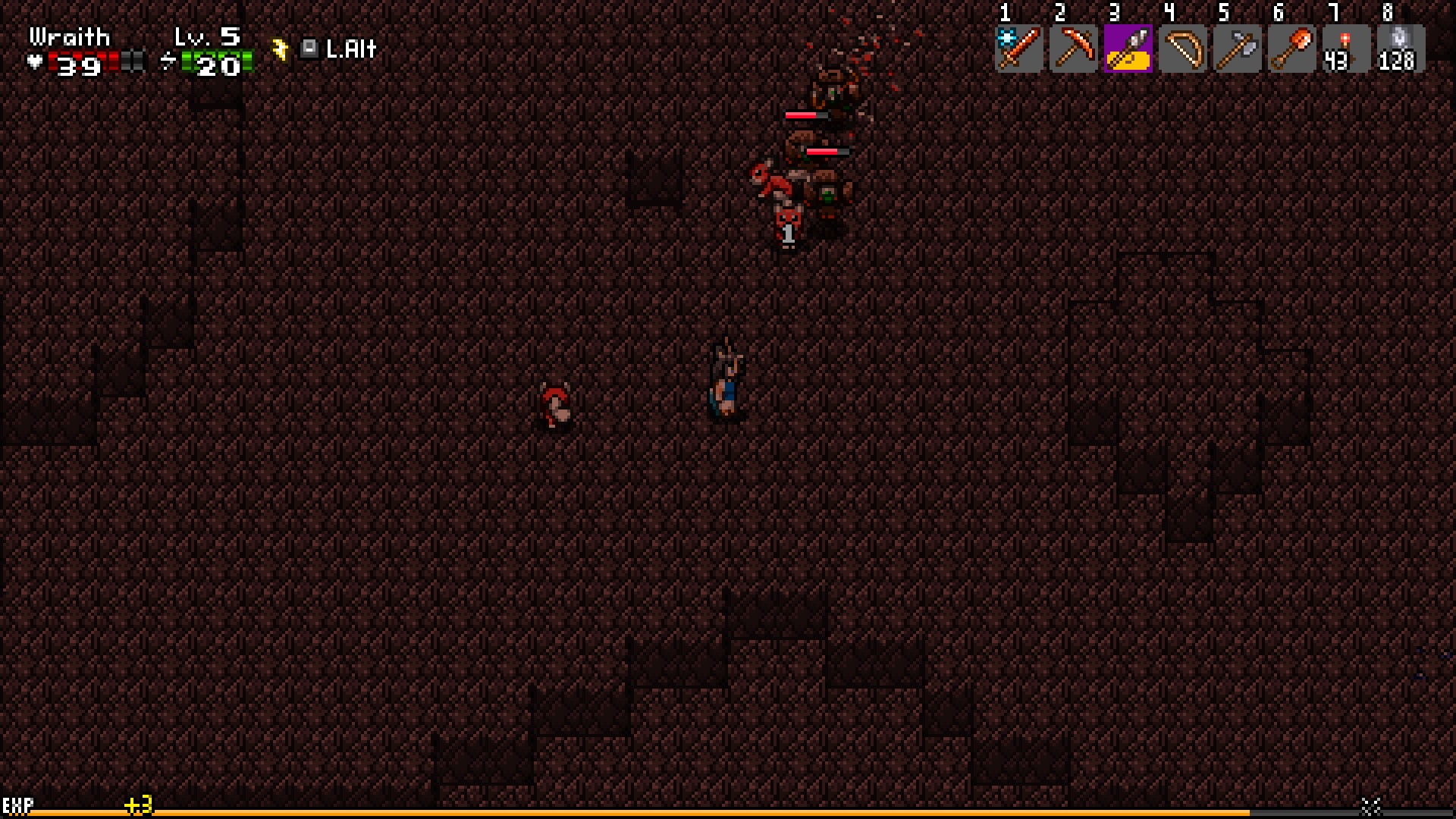
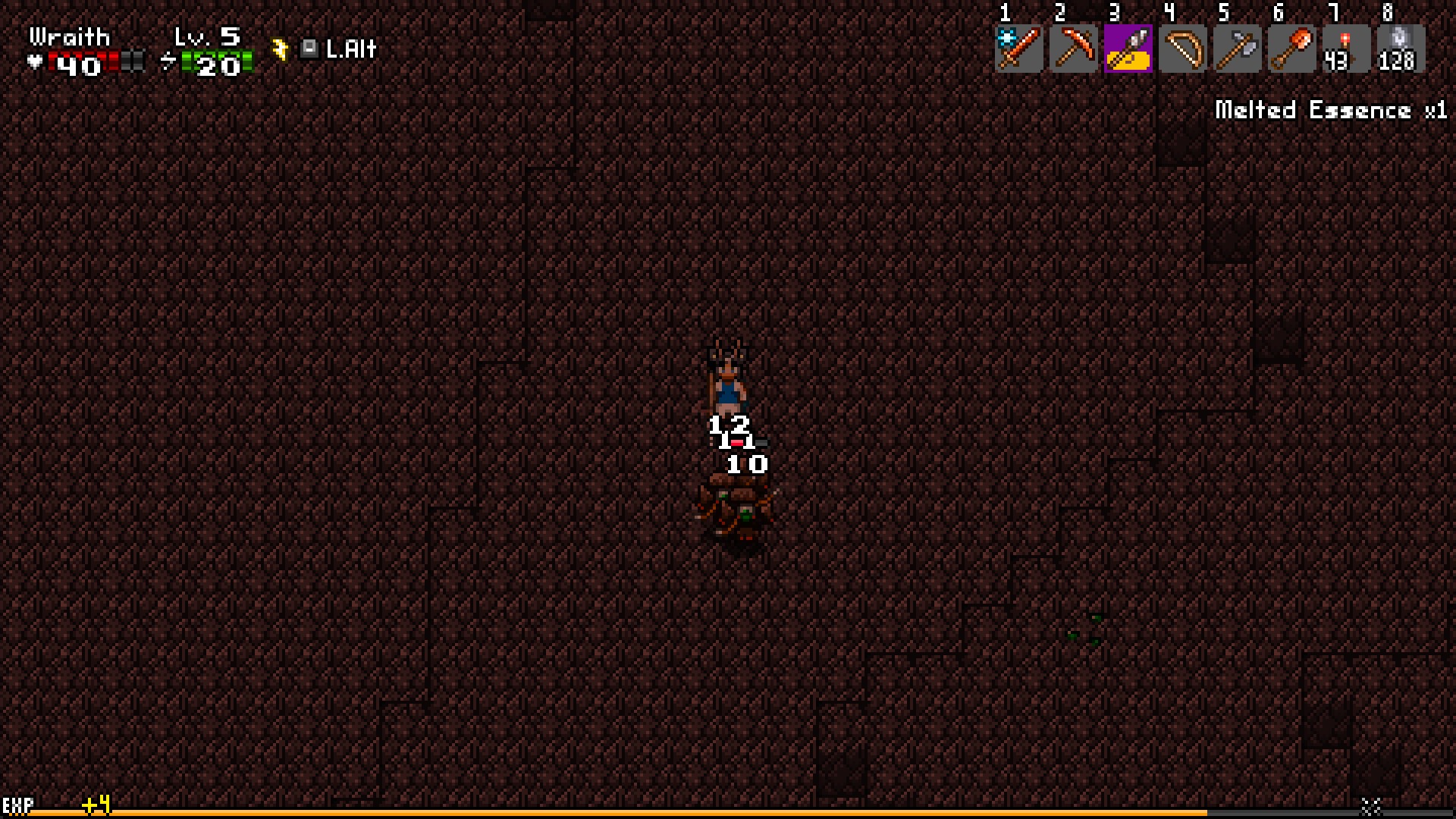
Ranged attackers for the most part can only fire orthogonally, so these enemies always try to move perpendicular to you so as to get onto an orthogonal line to fire.
You, for the most part, also need to fire ranged attacks orthogonally.
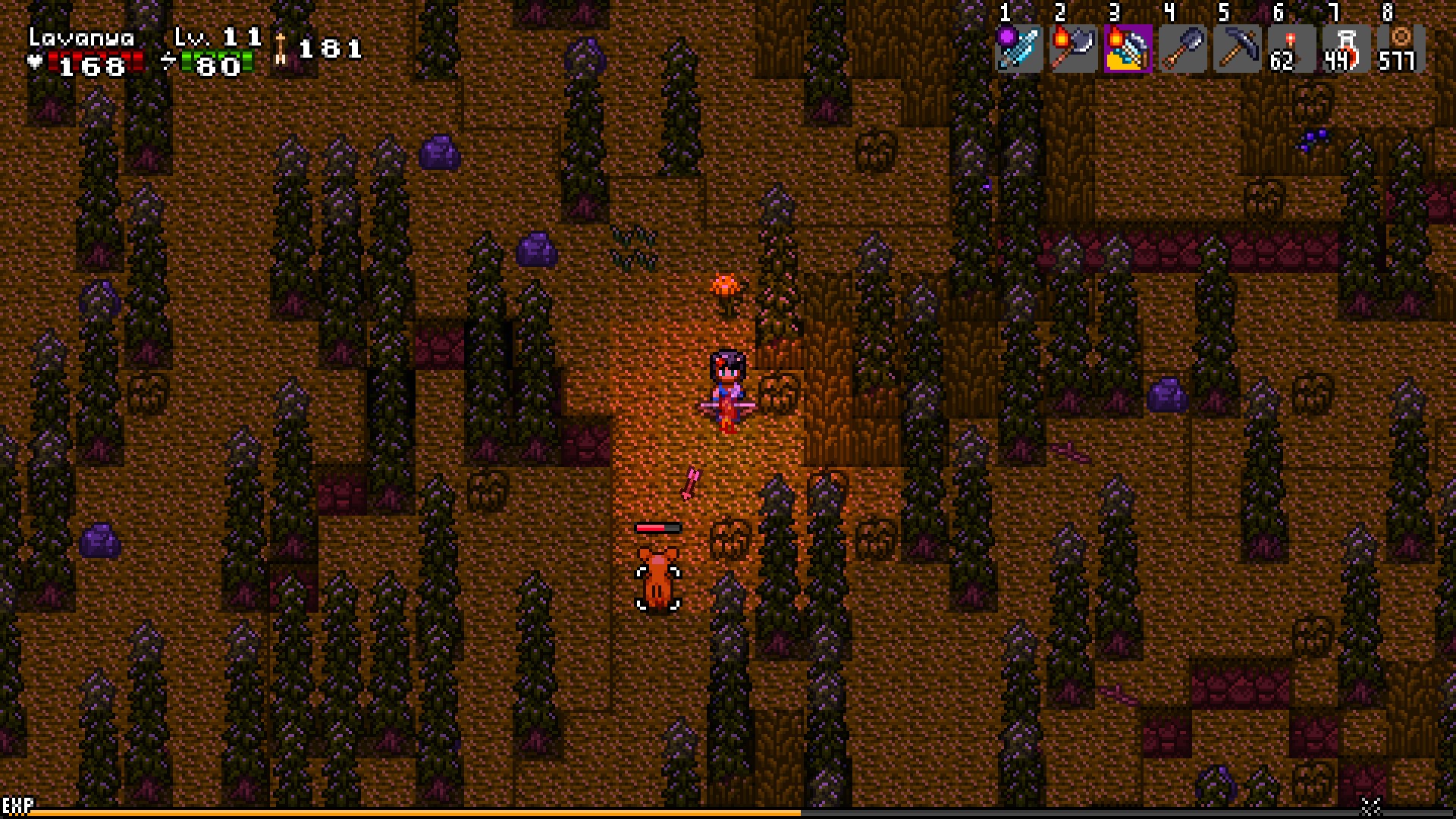
One thing to note is that ranged attacks require ammunition. Simple wooden arrows are easy to craft nearly anywhere out of materials that fall out of trees when you chop them, and you don’t even need a crafting station to craft these, making them a decent emergency ammunition… if it weren’t for the fact that bows do not really increase in power like swords and axes do. While melee weapons upgrade along with the metals from copper to bronze to iron to steel, bows are just wood or wood with silver risers to give extra special damage. You need metal arrowheads to match the damage a metal melee weapon does, and even after the developer expanded the amount of ammo you get per bar (and glue!) after I pointed this out, if you use ranged weapons as a primary weapon, you are going to be going through hundreds of thousands of arrows, taking thousands of bars of metal to feed your ammo dependency. Comparatively, you only need one or two bars to make a melee weapon that never goes dull or needs more metal to keep working. This is why I tended to only use ammo-based ranged weapons against bosses in Terraria, but there’s a problem with swapping out your gear just for a boss in this game because your animal race and skill picks specialize your character, and cannot be easily swapped out.
Specials (basically magic) are used through hitting a different button while equipping normal weapons. This hypothetically is what uses up your “green bar” of EP. Bows fire elemental arrows for free, making them the early default weapon of special-focused characters. Spears shoot a small cone of energy out for low amounts of EP, while hammers shoot bouncing fireballs or drop lightning for larger chunks of EP.
EP can be regained through food items or green orbs that enemies drop, but for the most part, you need to rely upon skills that either reduce or restore your EP because these items can in no way make up for the rate at which you’ll burn EP if you are using specials as a primary attack. The light melee specialization has a skill that lets you recover EP on critical hits and the flux elemental skill lets you reduce weapons with flux elemental attribute’s specials’ cost by 1 EP. On swords whose attacks cost 1 EP, this means swords have specials for free, just like bows, and this leads to my favorite weapon combo in the game so far, the quake orb (makes sword specials into shockwaves) with an propel flux sword.
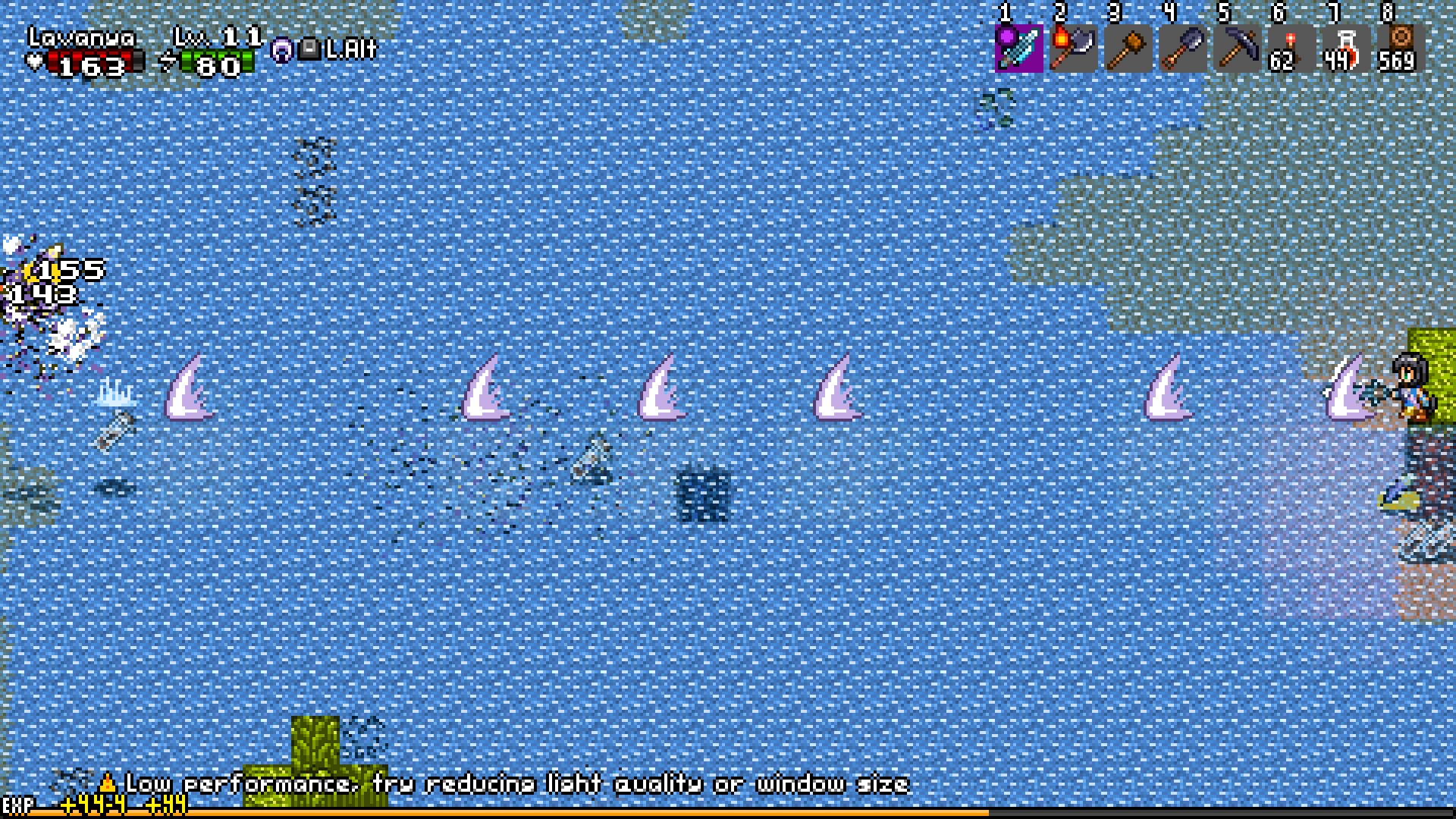
One final thing to note is that there is no blocking and there are no dodgerolls. “Parrying” only exists in the form of stun-locking enemies with melee attacks. To evade attacks, you need to have movement speed, and movement speed is based in large part on your animal race.
RPG Mechanics
One significant way that LandTraveller sets itself apart from other block-building sandbox games focused on combat like Terraria is the inclusion of RPG mechanics and a leveling system.
There are five stats in this game. The first one on the list, “Power”, would sound to most players like it refers to a melee attack stat, but in LandTraveller, it’s actually the “all damage increases” stat. It simply doesn’t increase damage as much as the other stats increase one particular type of combat’s attack power. This oddly makes it the stat it is most painless to sacrifice while also being the stat any character can gain benefit from increasing. Every other stat is focused on a specific form of combat. “Endurance” increases max HP, melee weapon damage, how long you can hold out against the elements (such as time you can hold your breath underwater or heat resistance), and total encumbrance. Encumbrance only applies to equipped armor and weapons (inventory is based on slots without weight), however because higher total encumbrance makes moving in heavy armor or attacking with heavy weapons faster, it’s still one of the most universally useful stats. “Will” increases the power of special attacks, max EP, ailment resistance, and amount of time you have in fog before fear overtakes you. “Agility” increases movement speed and light weapon attack speed. (Bows are also “light” and special speed is based on the base weapon.) “Skill” increases ranged damage, critical hit rate, and the rate at which you inflict ailments on enemies.
Speed is everything in this game. You spend easily four-fifths of this game just traveling from one place to another, so raw movement speed is of vital importance to your sanity, and movement speed is also the only method outside of stun-locking enemies with melee that you have of evading damage. (And against ranged enemies, you need to get to melee, first…) Attack speed is also often more vital than damage, as you are frozen in place while attacking. Because of this, no matter what build you are going for, you generally want to take Endurance and Agility.
Levels in LandTraveller are a bit odd. They don’t increase base stats, but increase the derived stats they affect. Leveling up not only gives you more HP and EP, but also multiplies the damage you deal and significantly reduces incoming damage at the same time. This leads to leveling up giving you large jumps in power where you can overwhelm most enemies even with bad equipment if you are leveled enough, and that can lead to a real problem with game balance when you’re overleveled for an area compared to another player.
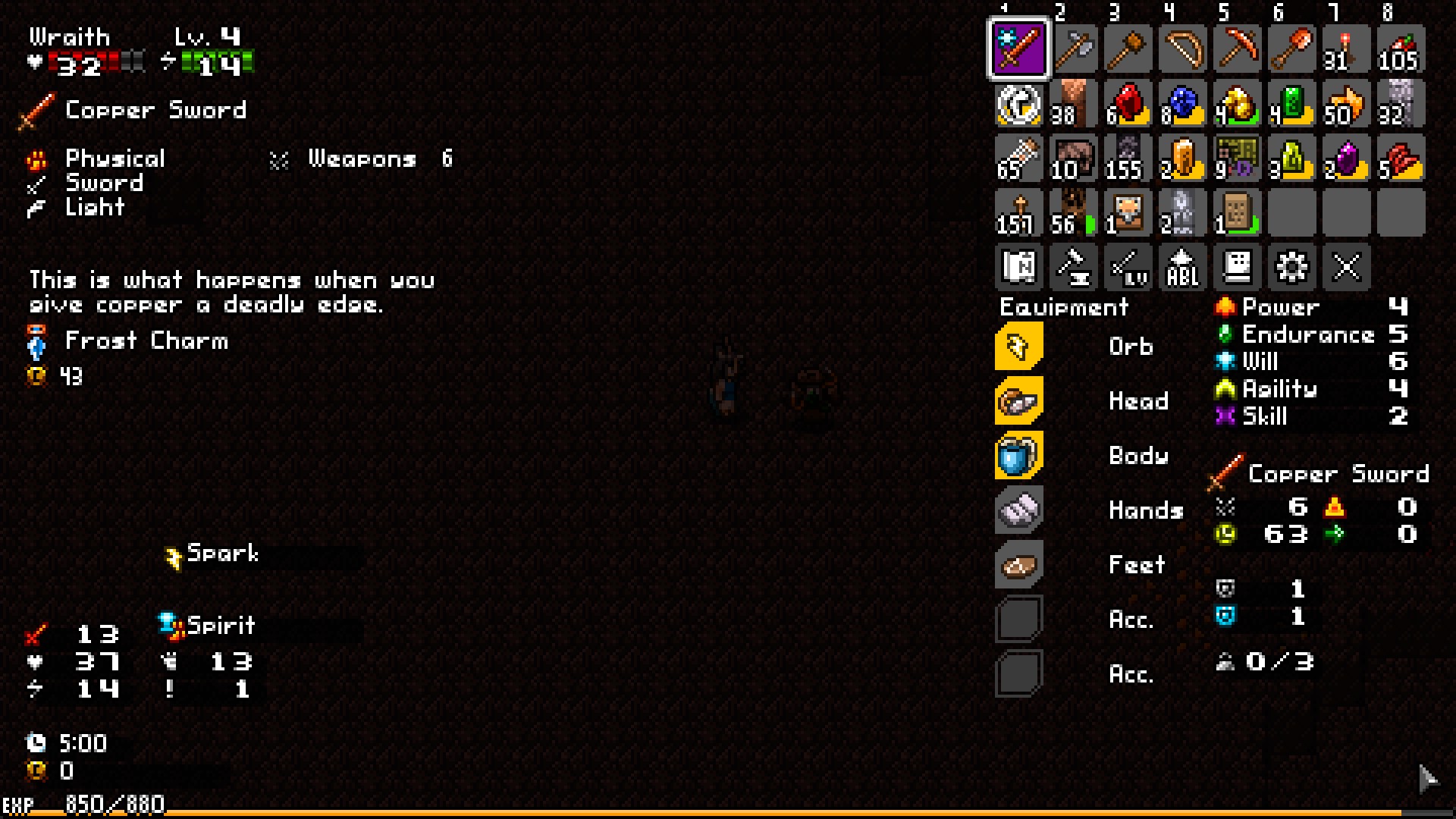
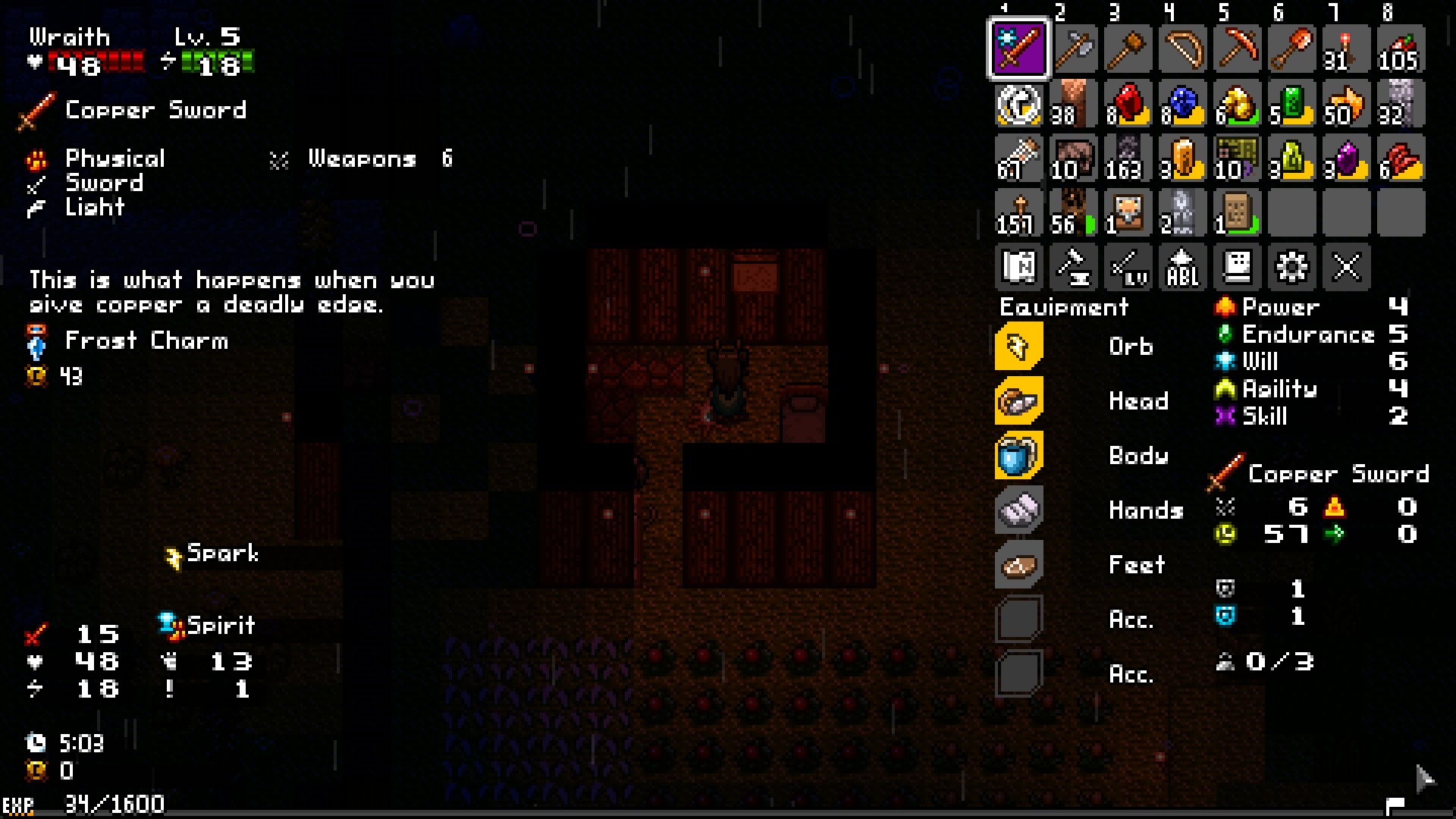
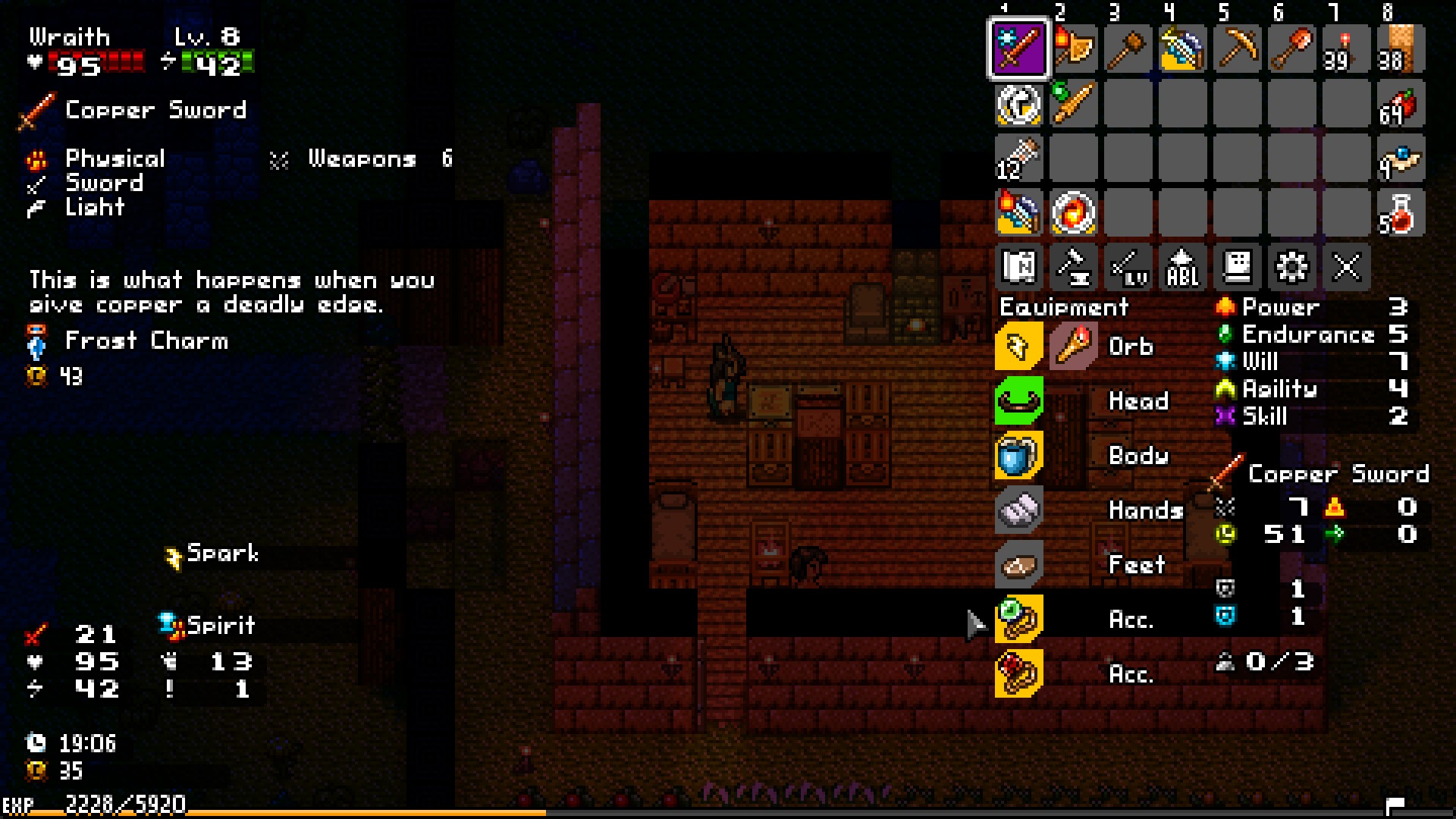
On the other hand, experience requirements for each level roughly double every level, while monsters in the chapter 1 give 1-4 exp, monsters in chapter 2 give 3-5 exp, and monsters in chapters 3 and 4 give 4-6 exp. Unlike most RPGs, this creates a situation where it can actually be easier to grind levels (although you really don’t need to, and this game can get grindy even without doing so deliberately) by going back a chapter or two and bullying the weak because it’s much faster than fighting monsters that take four times as much damage to kill for only 20% more exp.
LandTraveller also has a skill tree that further customizes a character. The first skills you get, for example, let you pick one of the base stats to upgrade by one. You get to pick three of the five stats to upgrade. Another layer of skills lets you pick two of the four combat types (treating heavy and light melee as different), and the two you pick allow for a choice of one of two further upgrades one branch further down the line. For example, the special-based branch starts with “Vigor” that lets you recover 1 EP if you kill an enemy with a 0 EP special attack. You then can “chose” between either “Zeal”, which increases special attack damage, or “Lively”, which just gives +4 max EP. (This, however, isn’t much of a choice, as if you are using a build that lets you kill enemies with specials that cost no EP, why switch to ones that do cost EP when you can just focus on killing enemies with the free ones?)
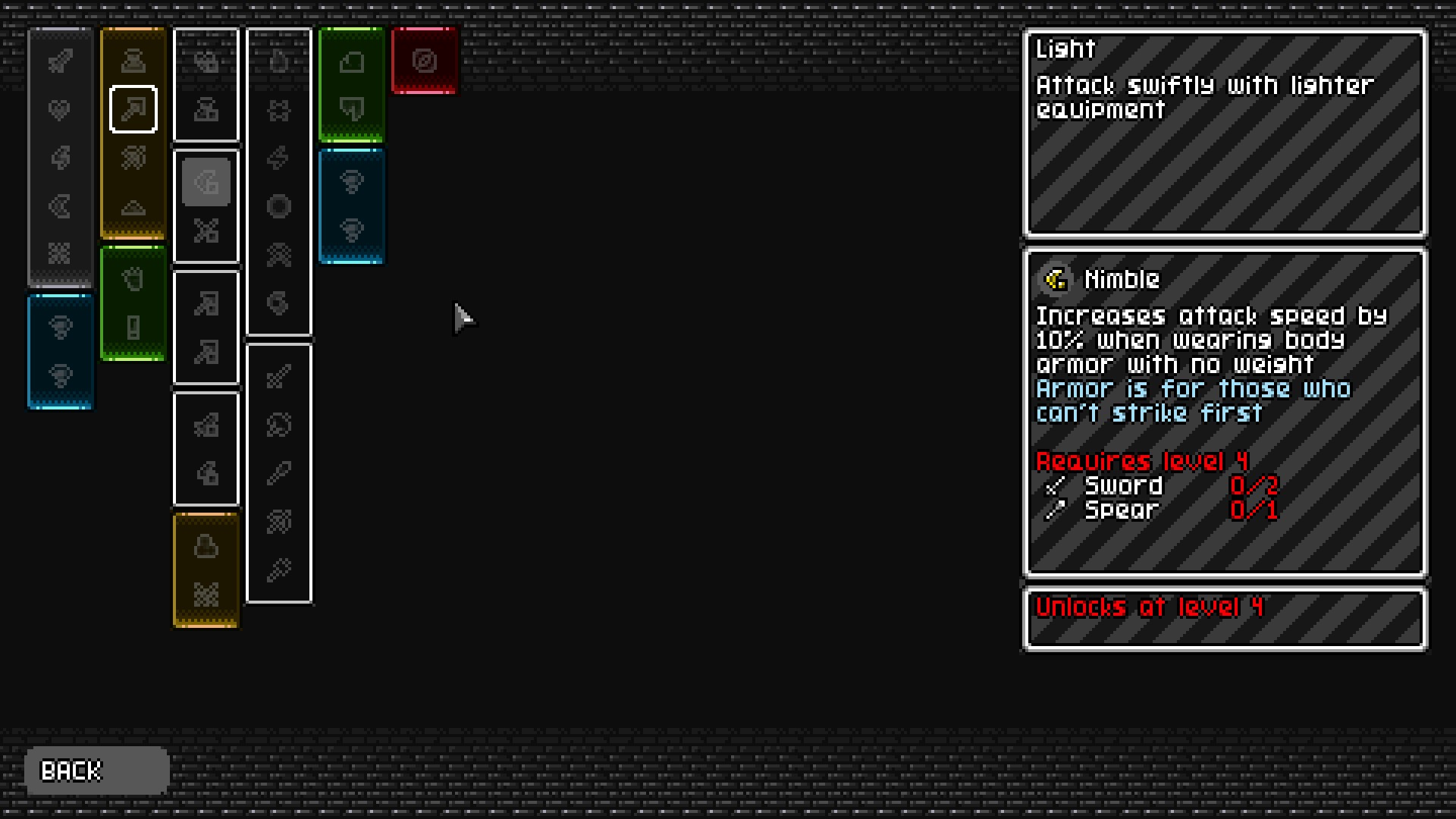
Something important to note is that skills are set in stone. The developer has talked about a respec feature somewhere down the line, but currently, if you have second thoughts about your skills, your only choice is to restart the game with a new character. This is particularly significant because there are several pieces of equipment that can radically alter how a player wants to build their character that only show up two or three chapters into the game, while you can get to level 7 and exhaust the skill tree by the end of chapter 1. My build based around using swords with 0 EP specials relies upon a flux skill and a flux charm that only becomes available in chapter 3, and up until then, I have to use bows. However, I don’t want to specialize my skills in bows, because I’ll never use them again after reaching chapter 3, so I’m going through the first 15 hours of the game using a weapon I’m not specialized in just so I’m not screwed later on.
There are also weapon, tool, and elemental levels that are trained through use. These, however, have no game impact except that they are used as prerequisites for skills. Even then, there are no skills that require more than level three in any category, so outside the earliest part of the game, this is little more than a record of how much you use each tool.
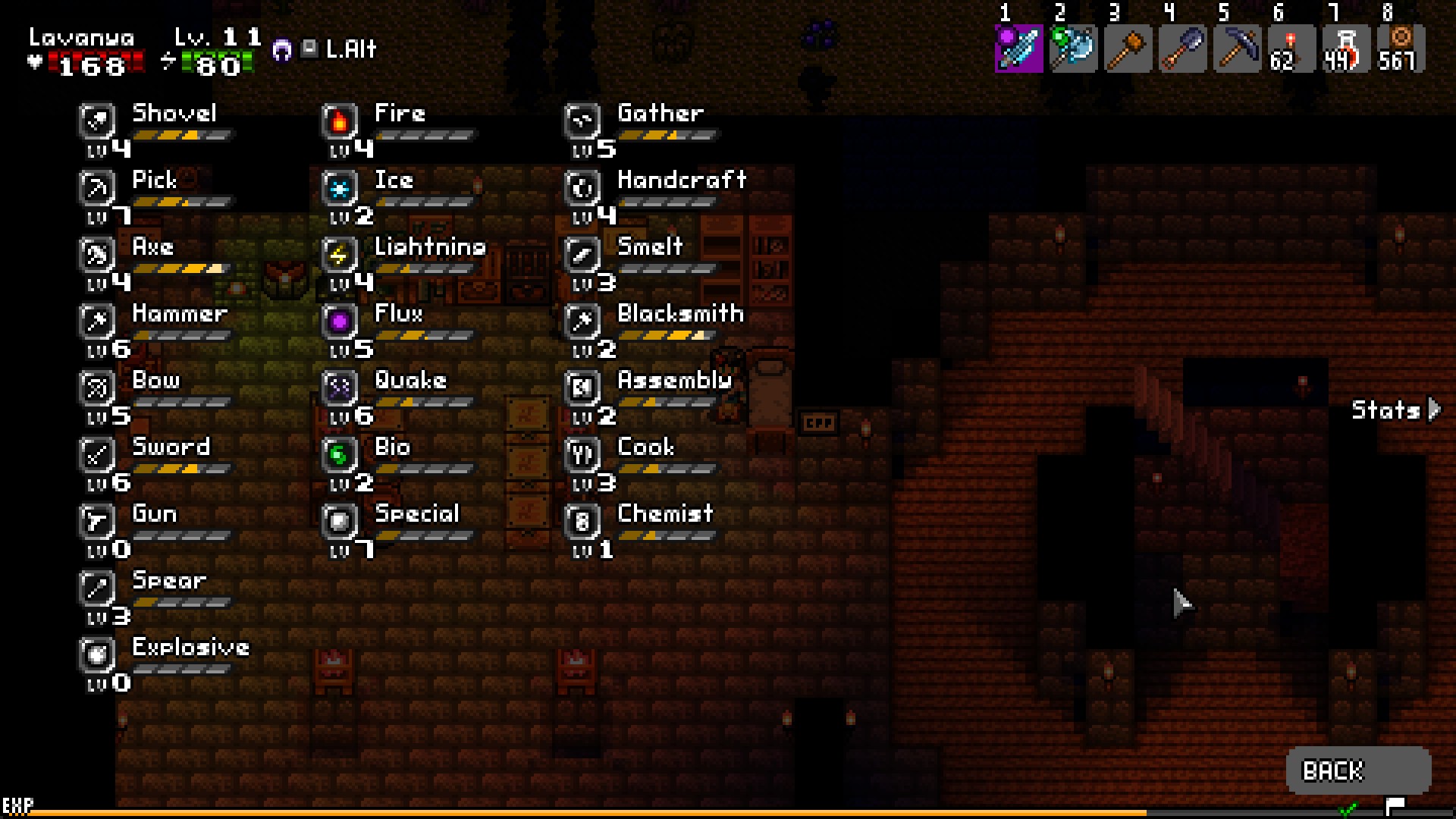
Animal Races – Some Are More Equal than Others
At the start of the game, you need to pick one of eight races to be your player character. Each race has one stat at a 5, one at a 4, two at 3, and one at 2. Each race also has four special racial skills (although you can only pick three, and there is some overlap in the “lower” racial skills, such as four races having the “Swift” skill).
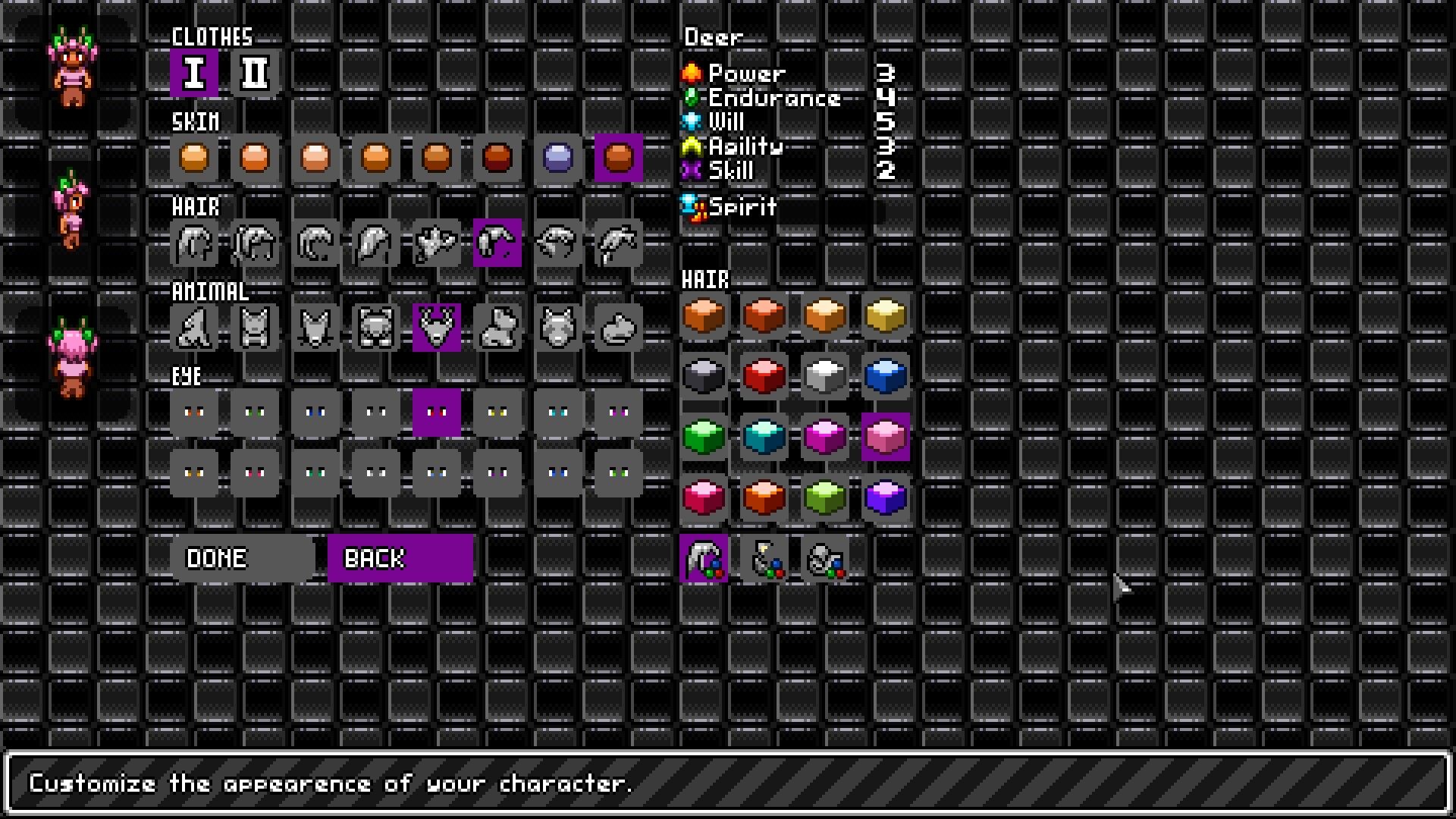
Of the eight base races, 6 are doubled up on which stat they give the 5. For example, rabbit and mouse both have 5 in agility, and both put their 2 in power. Where they differ is in their racial skills and where the rabbit has 4 in endurance (for melee damage), while the mouse has 4 in skill (for ranged damage). Wolves and cats are specialized in power then skill, differing in being weak in either endurance (wolves, strangely), or will (for cats). Fox and deer are specialized in will and have a non-elemental “foxfire” special even without needing to equip orbs to add elements. The fox has 4 in skill and 2 in endurance, while the deer has 4 in endurance and 2 in skill. The bear has a mighty 5 in endurance, but the only agility penalty of any race, making them miserably slow. In spite of being powerful, I cannot bear to be a bear. Racoons, finally, are focused in skill, making them the ranged weapon specialists.
For obvious reasons, your race, much like your skills, are set in stone once picked, although there is a way to become a hybrid with the benefits of two races at a certain point in the plot.
And this gets to one of the major problems with the race and RPG system – you’re locked into a specialization basically from the start of the game. If you take a racoon with a ranged weapon specialization, you either have to spend an obscene amount of time forging ammunition to feed your ammo needs, or you need to use weapons you are not built to use, and therefore fight at a disadvantage throughout most of the game when you aren’t consuming ammo.
Inversely, deer are special-specialists, and also get what is hands-down the best skill in the game, “Woods”, which allows you to fire specials through obstacles. The big weakness of a ranged build in this game is that obstacles might obstruct your line of effect to shoot enemies, allowing swarms of melee enemies to get in range, or that you might have to move to a spot where ranged enemies can shoot back. Or, you can just hide behind a tree and fire straight through! You can gain experience killing enemies off-screen by swinging specials around blindly! Fighting fair is for suckers!
Story Mode
The main menu in the game recommends that you play the story mode first. It isn’t kidding. Explore mode is probably the more enjoyable mode, but it dumps you into the world with zero guidance. Minecraft does this as well, but Minecraft has an absurd amount of wiki and YouTube video content to give you an idea what you’re doing. It also doesn’t make areas built around revealing some hidden truth about the world you’re living in that isn’t revealed in the main sandbox game mode, although that’s getting a little ahead of ourselves. The basic thrust is that while story mode is the story mode, it’s also tutorial mode, and is the only way to get any context within the game itself about what you should be doing and why.
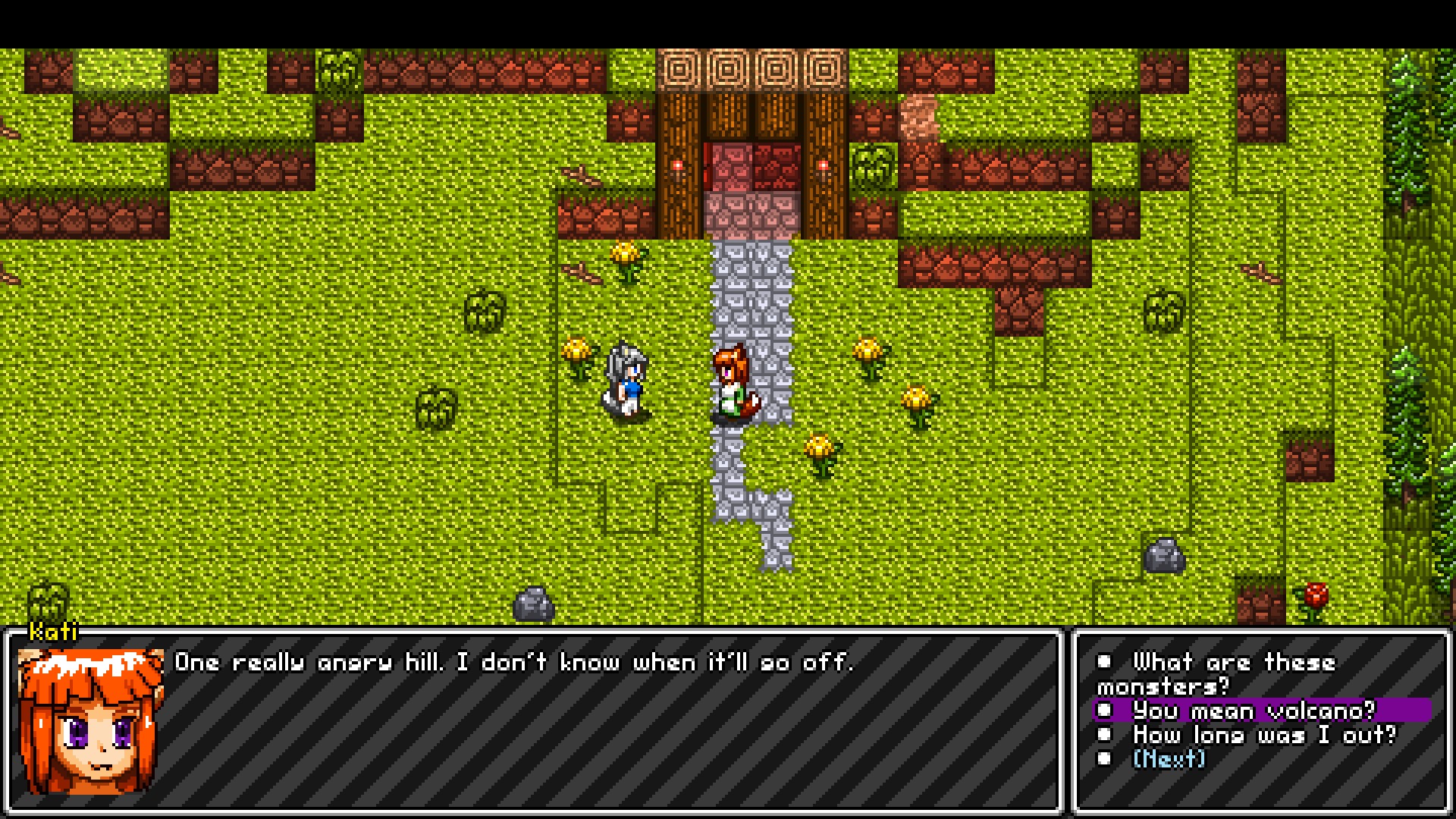
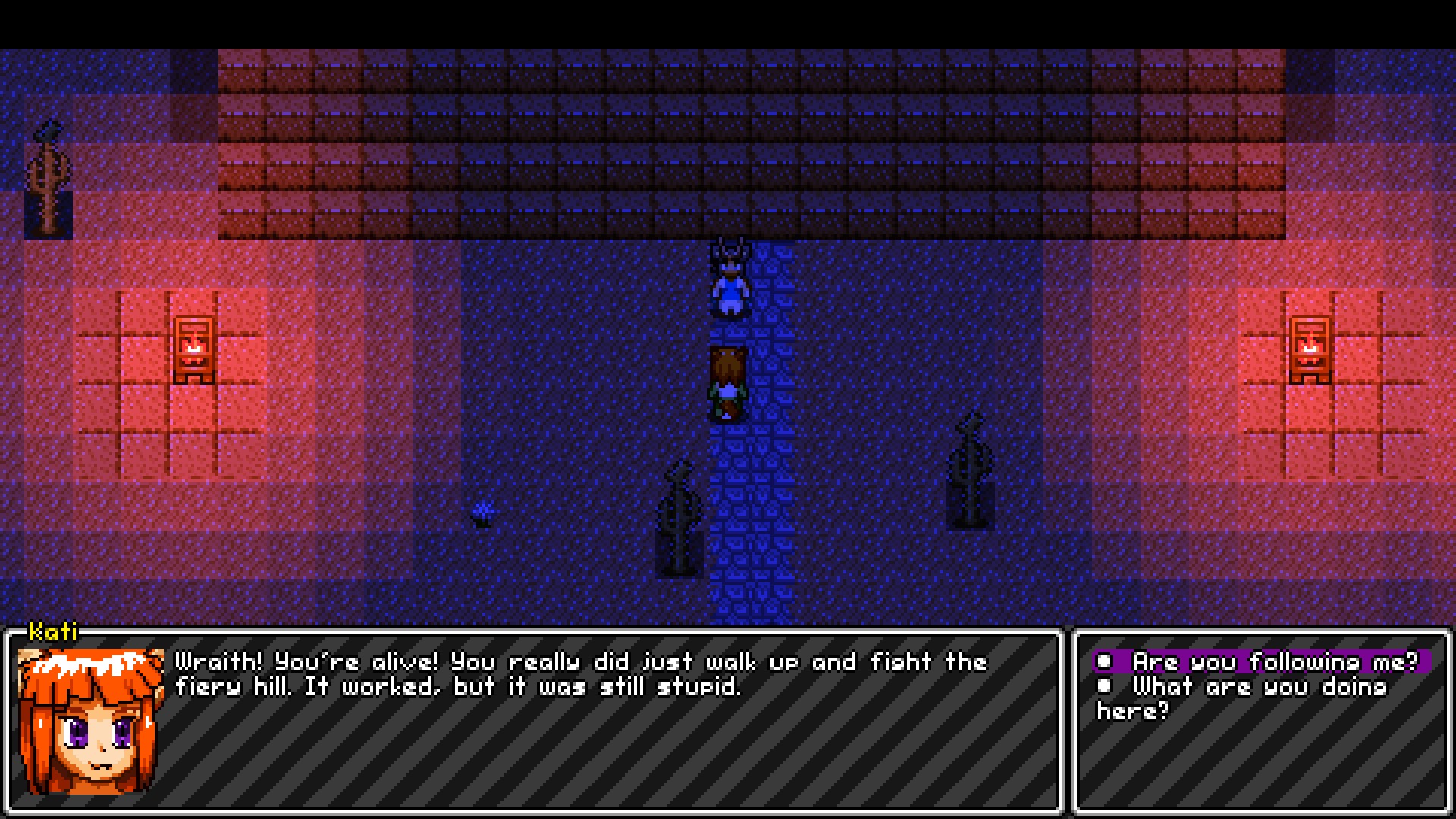
I haven’t mentioned this until now, but on their social media, the developer stated that they made this game that has everything, yet nothing to do with being a furry. (I figure the game stops at just being anime-style catgirls instead of full furries to keep it more mainstream, although I didn’t ask about that part.) In most of the game, it isn’t very relevant, but the way that the game tries to make jokes about being different animal types is a bit of a reveal.
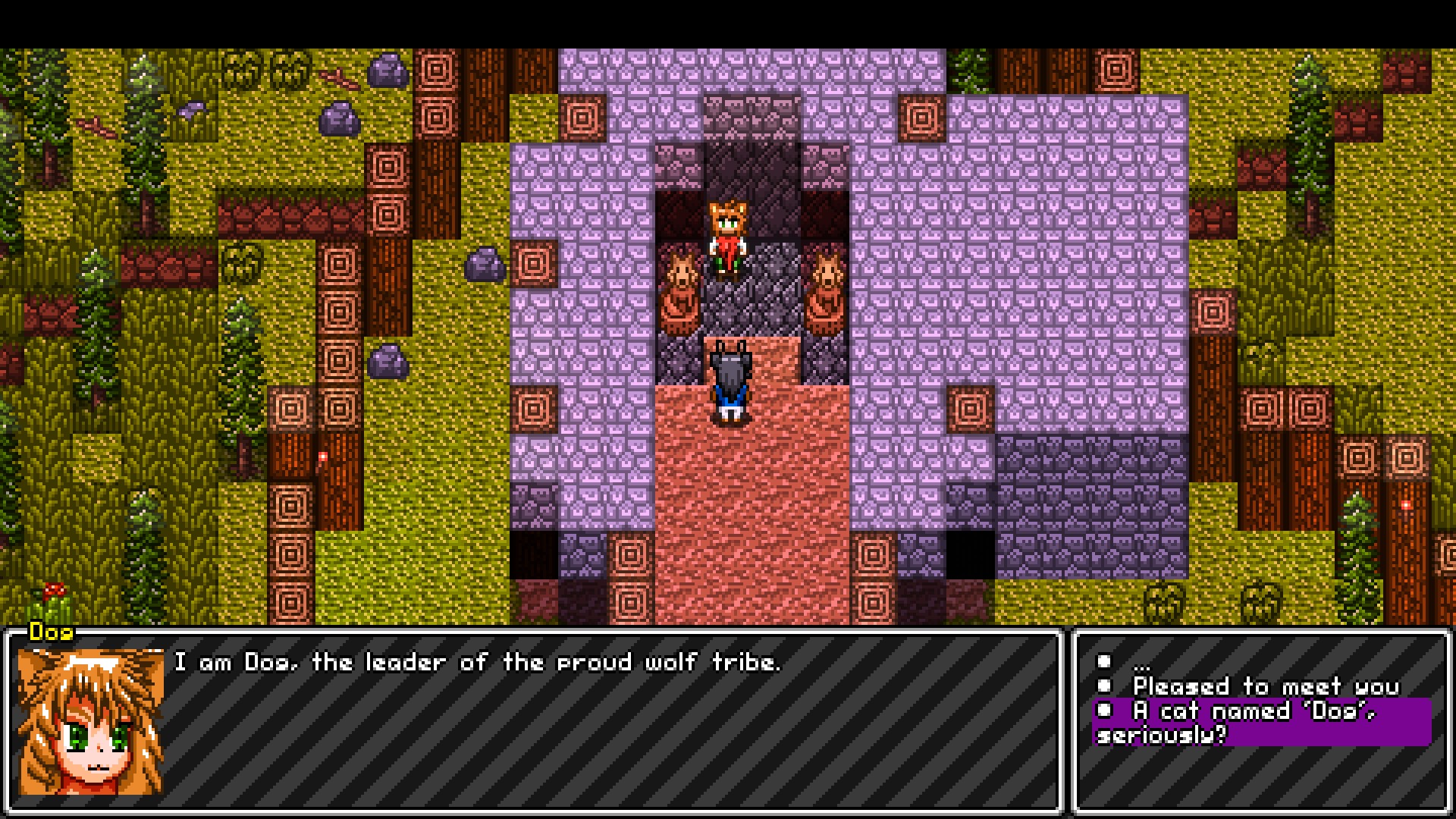
In any event, you start the game unconscious and brought back to health by Kati. Apparently, you’re a rando wanderer from nowhere whose whole tribe was killed by monsters, although you do get some light multiple choice on this. I think the multiple choice could use some expansion and some branching dialogue paths or callbacks, but in general, I do like that we’re literally a rando who is only special because we are the only beings not controlled by a simplistic attack script, and can therefore evade attacks. I’m rather tired of legendary destined heroes.
I won’t spoil the plot, but a large portion of story mode consists of being told to find out where the monsters are coming from, being sent to one location or another, and finding out they’re coming from someplace more technologically advanced than wherever you are at the moment. The source of your technology (besides killing bosses) are records found in ruins of much larger ancient civilizations. As you travel towards the source of the monsters, you find more and more high-tech civilizations. (The Bronze Age city is only about half an hour away from the Stone Age tribe, and the volcano only gained its boss that cut off travel just before the plot started, so I wonder why nobody noticed the blatantly more advanced civilizations so close by?)
At the same time, you come across evidence of cults, including the “Fanatics”, which are a pretty standard JRPG dig at religion… except their religion about worshiping the bosses as “gods” and monsters as “children” that want to scour the animal-people from the planet seems to be pretty right on the money…
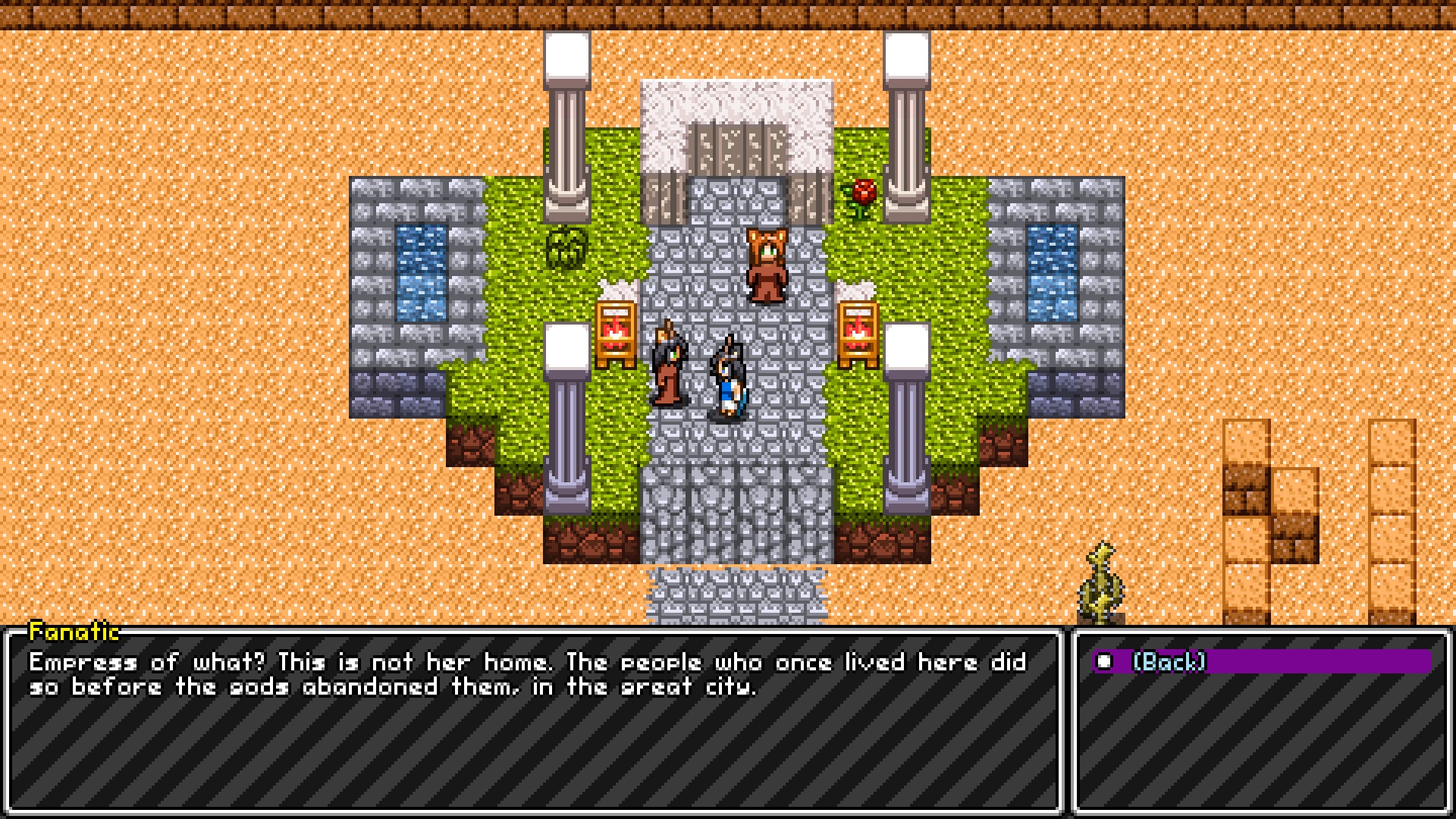
Story mode also disappoints me because this is a game that is at least hypothetically a block-based sandbox game, but there’s no reason to change the terrain except to mine in story mode. You have no reason to build bases because you cannot create safe zones that stop monsters from spawning inside any homes you build or any new fast travel points, except for one specific point at the very start of the game. (And the first time I came across that point, I didn’t even recognize it was one – thankfully, a new quest, Playing Mouse, has a mouse tell you where to build a house.) There are pre-built towns with pre-built crafting stations next to pre-built fast travel points and storage containers all throughout the story mode campaign in safe zones, while anything you build yourself can have monsters in it and lacks a fast-travel point. Why bother with the base-building sandbox stuff in this base-building sandbox game?
Farming
Well, one reason to bother is to make a farm. The only problem is that in story mode, your one safe location is very unlikely to be anywhere near any source of water.
With the exception of the sungrain that grows in the desert area, farming in LandTraveller requires water for every stage of growth that a plant goes through. Plants take water from adjacent blocks, and since people were taking advantage of underwater farming, plants now despawn if submerged in water, so the water needs to be in trenches.
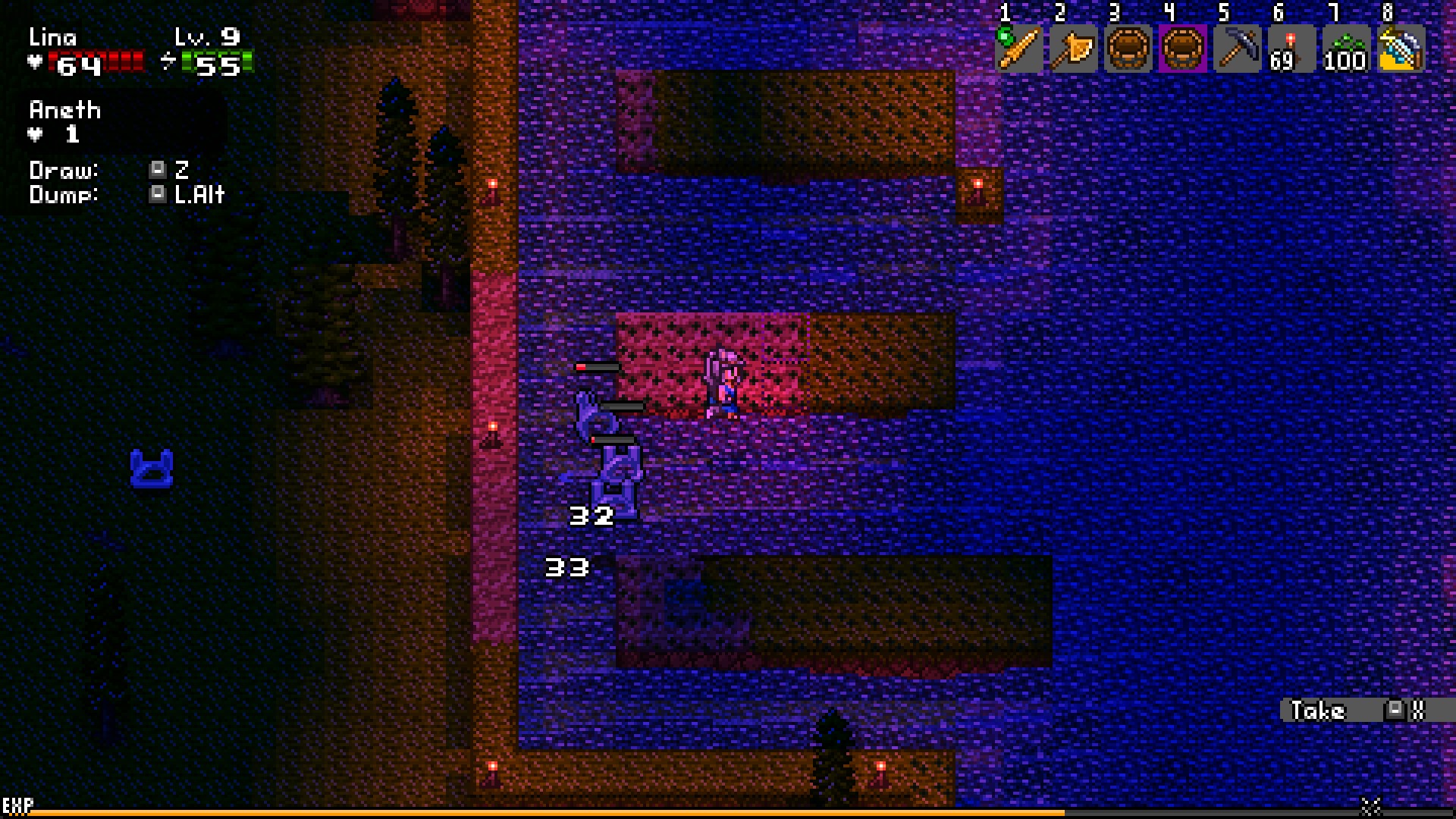
This butts up against the way that fluids flow in this game – water will respawn infinitely if drained from a deep enough depth, but water only flows to tiles more than one fraction of a tile below it. This creates a “water stairwell” effect, where water doesn’t flow in to refill areas that are uneven.
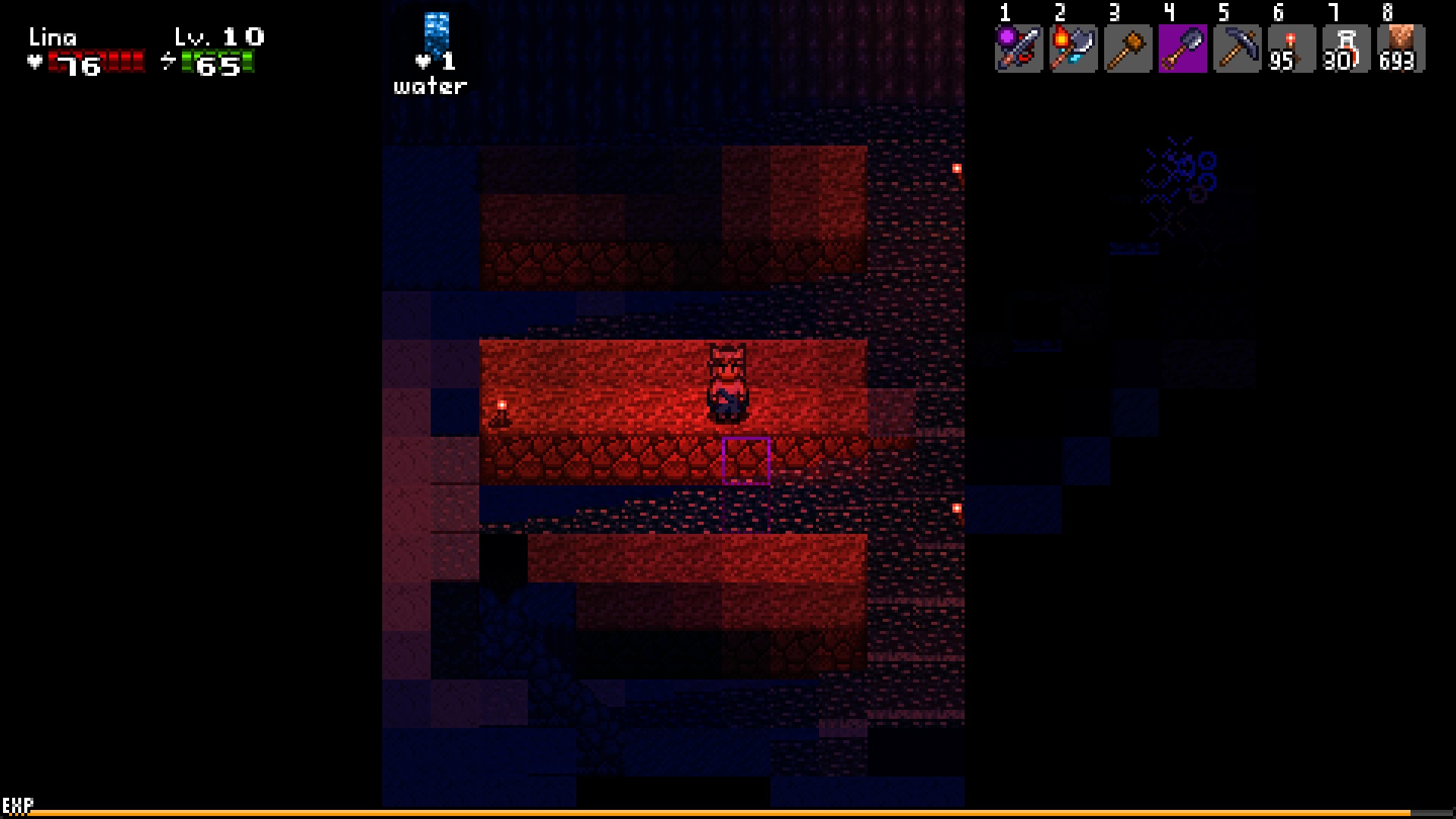
Farming is the only renewable source of food besides the chicken-like pikkens you can hunt, and the tinctures you make from farmed sungrain are one of the only reliable healing sources mid-combat. Further, one of the new crops in chapter 4 is a cotton-like plant that is used to make chapter 4 armors. Farm or fall behind on the arms race.
Explore Mode
Explore mode is the mode that has no explanation for what’s going on, but at the same time has all the interesting mechanics.
Unlike story mode, which features pre-built cities that negate the purpose of base-building, you can create new safe zones in areas that contain cleared landmarks.
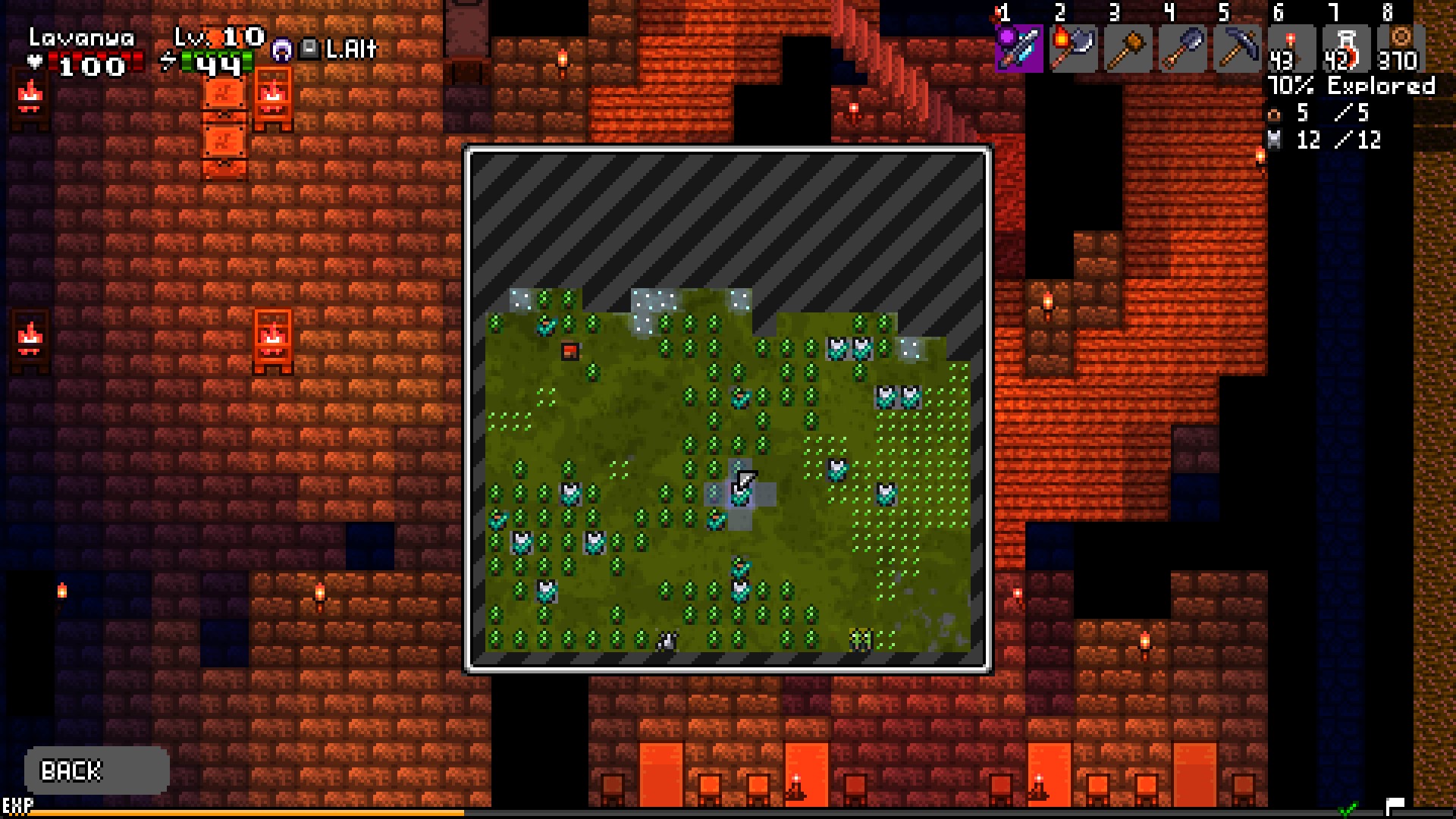
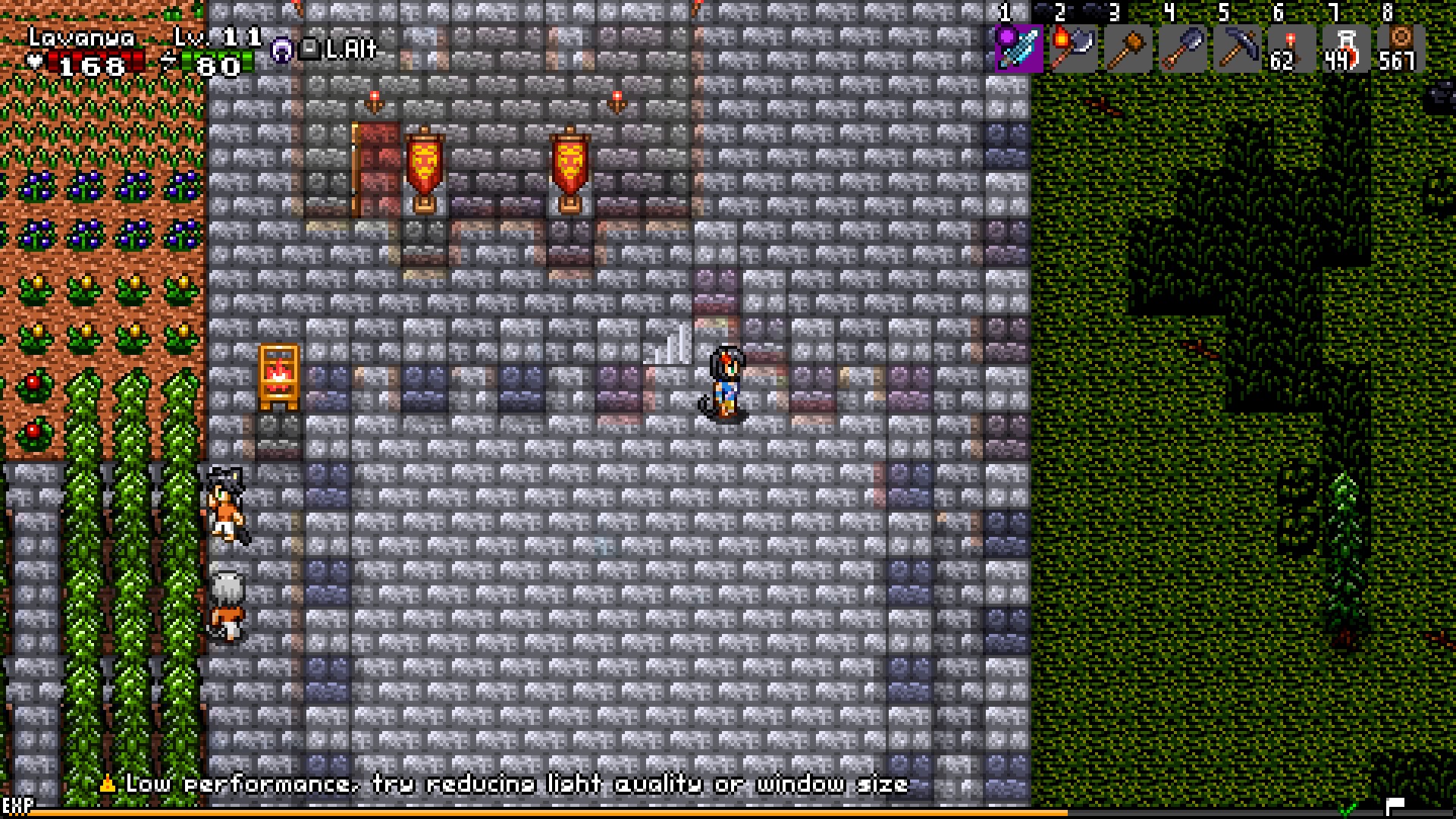
While the NPCs lack the scripted (and unchanging) dialogue of story mode, NPCs in explore mode can be spawned into the game by building an enclosed house area (with a light source and door) and laying down a bed for each NPC to be spawned. NPCs in this mode have one of a few behaviors randomly selected when they are spawned.
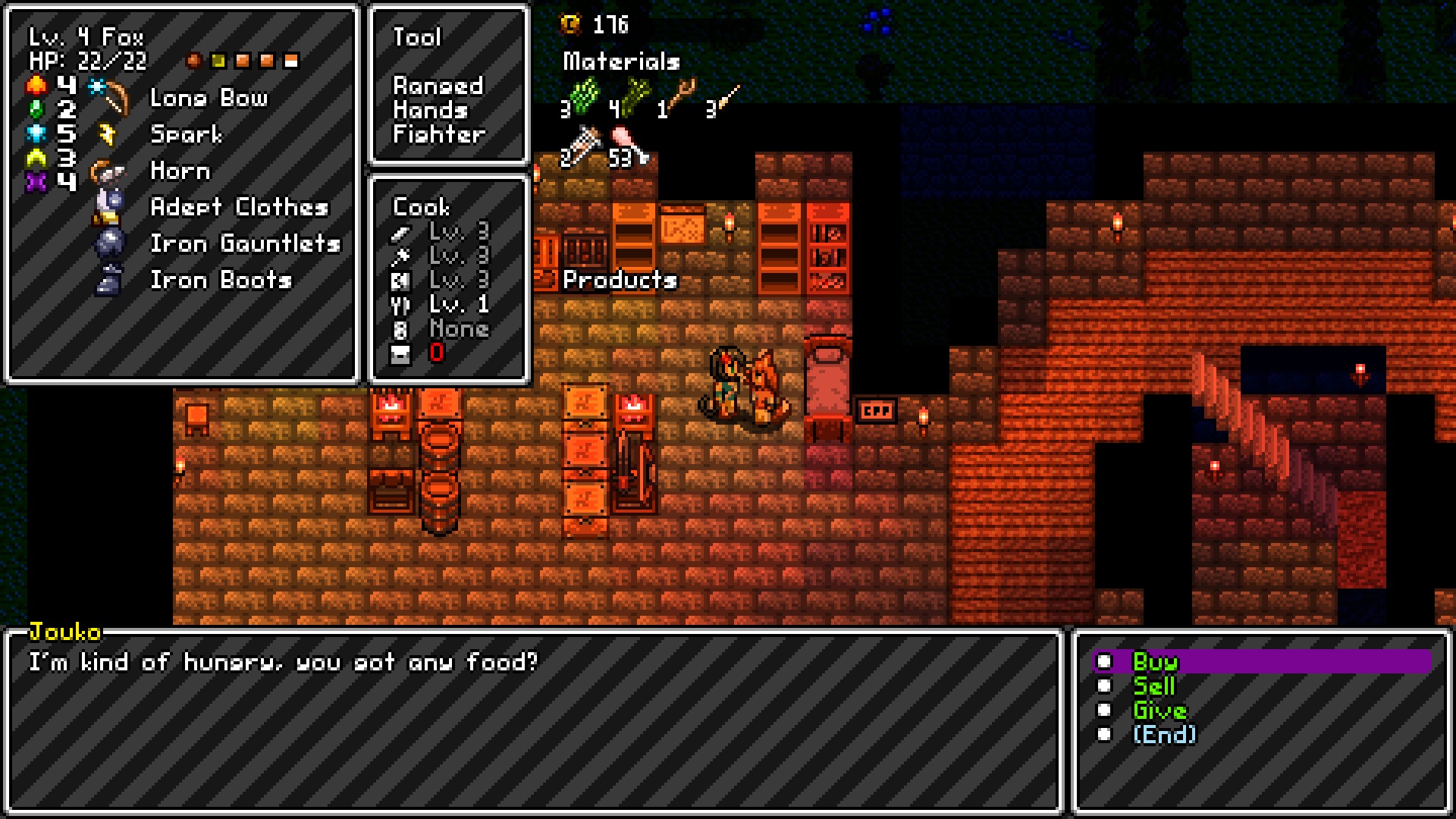
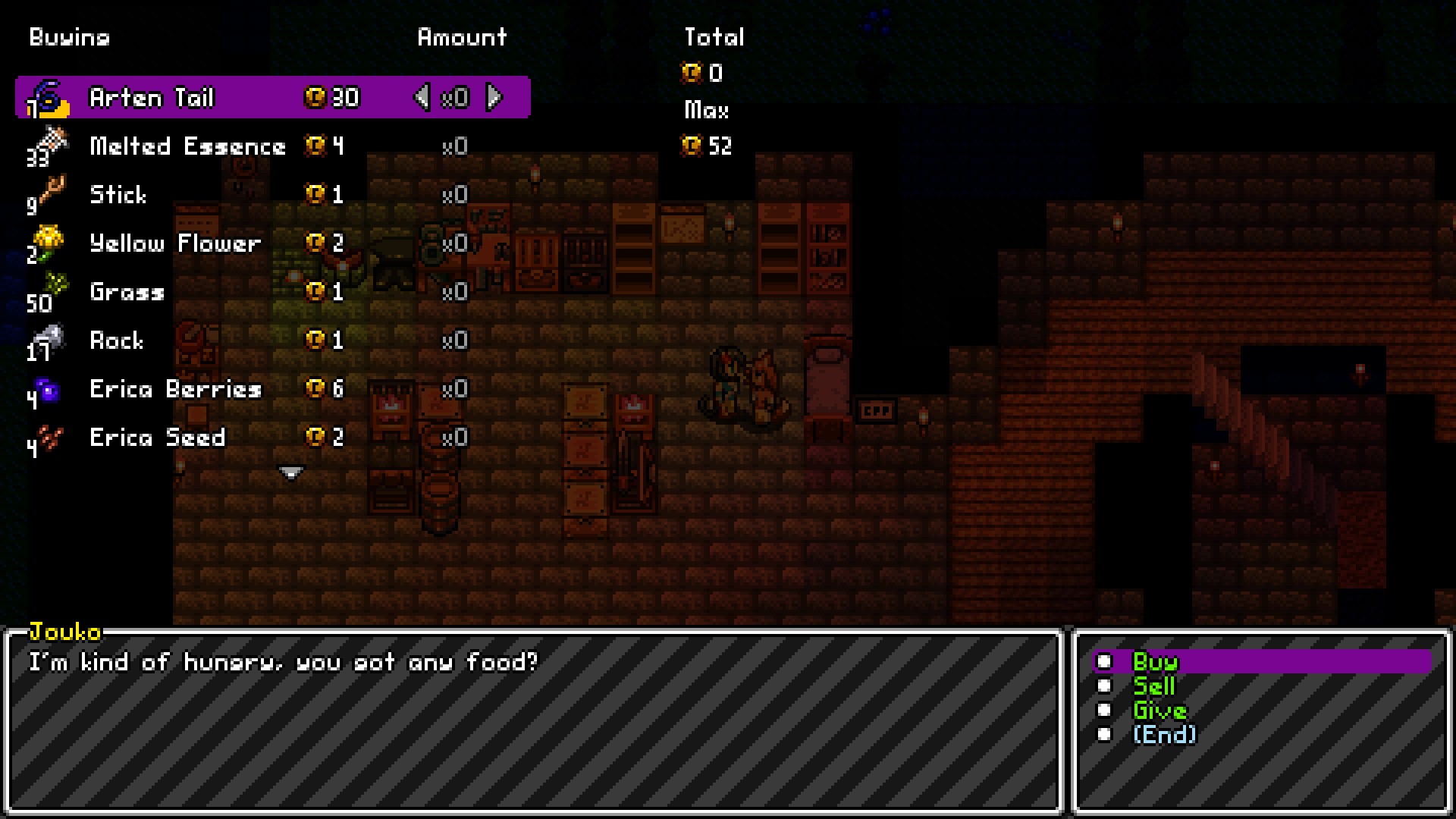
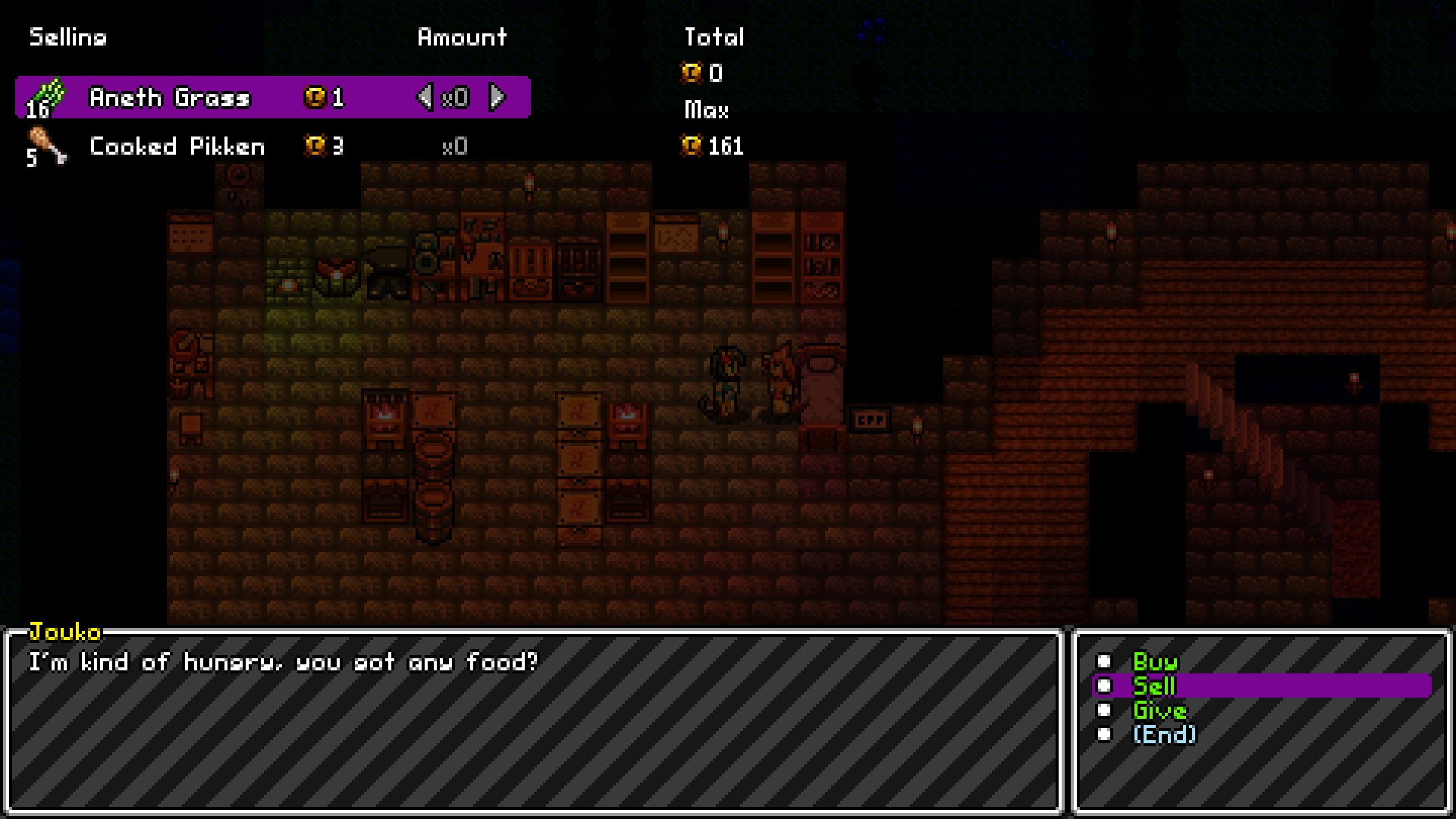
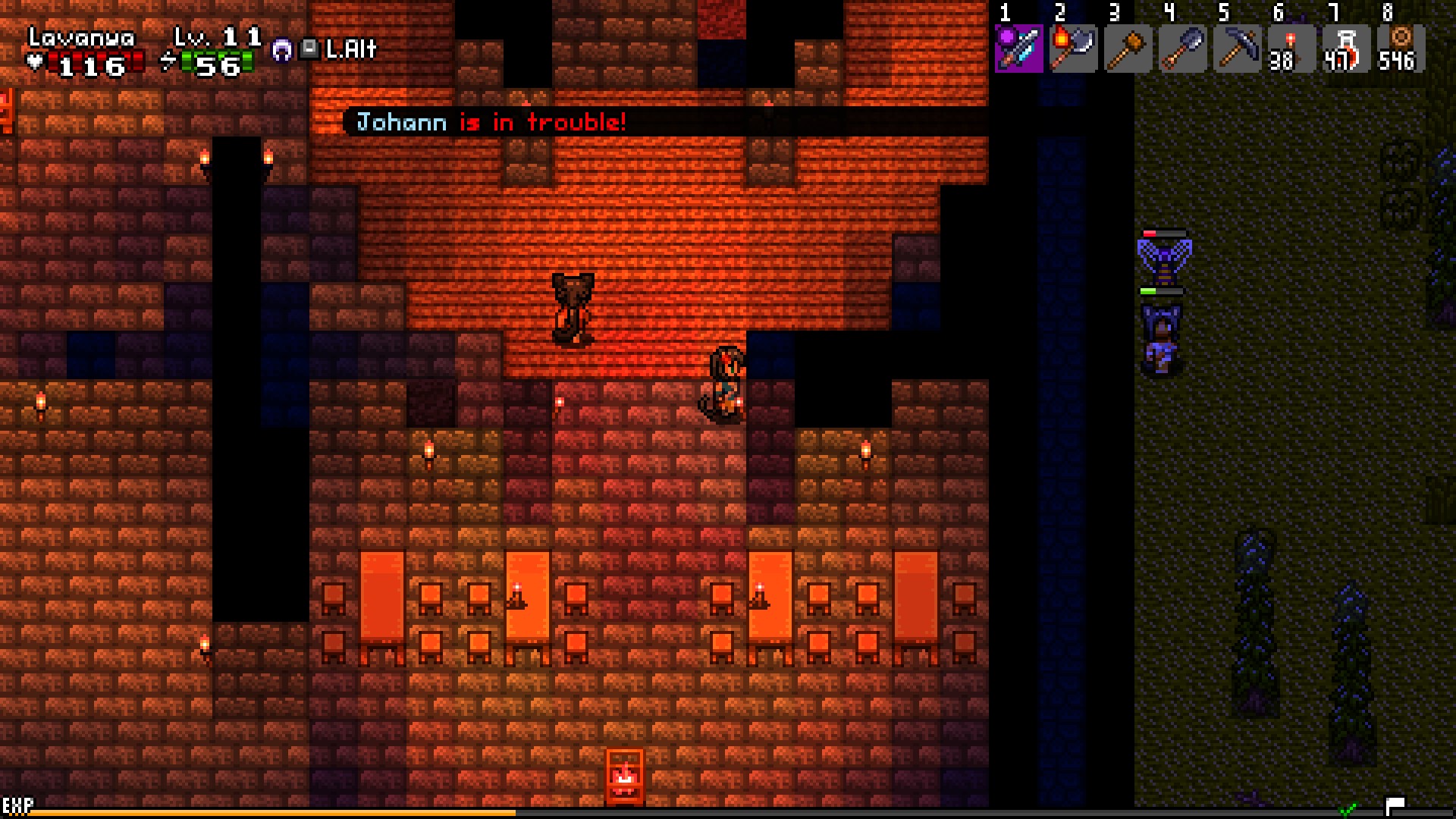
Explore mode lacks the scripted quests, including the scripted fights of story mode, but makes up for this by having actual base-building in our base-building sandbox and NPCs that have dynamic behaviors, such as going out to gather materials. (The NPCs do not actually remove objects from the map and can come back and sell you materials that are non-renewable, such as flowers, which for some reason you cannot farm in this game.)
One other important thing to note about explore mode (which is also a significant advantage over story mode, in my opinion), is that, similar to Terraria, explore mode characters are not tied to a specific world seed. Story mode character save files are tied to a specific world, and while you can start playing them in a different world, they start at level 1 with nothing. Explore mode characters can be sent off into other worlds to loot it for resources, then bring them back to a “home world”, and can also go back to the spawning point of new characters and leave behind a chest filled with late-game equipment, which makes restarting far less painful in explore mode.
Multiplayer
Multiplayer is essentially just co-op explore mode.
Sadly, I don’t have any screenshots of myself in multiplayer mode (except being alone in the public server) because people only use private servers, and I have no friends… ah, that own this game.
That said, multiplayer LandTraveller can be a bit mixed in concept. One notable feature in multiplayer is that players lay “claims” when building houses. This is a box that prevents other players from building or destroying anything in your claimed zone so that nobody can vandalize your place. You can build houses and even make them conjoined to other player’s houses, but the game still has a fundamental issue that base building is barely more than crafting stations and a place to stash your excess inventory.
Redecorating and Pretty Princess Dress-Up
One thing I’m saddened by is a pretty limited selection of cosmetic items and decorative blocks. There are exactly as many blocks or cosmetic items as are needed in story mode for houses and NPCs, but you’re basically limited to the styles that exist in Story Mode plus just living in a raw cave.
That is, you can make a building out of cobble or wood blocks like in the Stone Age area, sandstone blocks like in the Bronze Age area, or stone blocks like in the Iron Age area. Stone blocks and sandstone blocks are the same texture, it’s just that one is gray and the other is yellow, at that. There are bricks, but clay is seriously annoying to craft in this game. (You make clay from sand and water… somehow, or else use mud, but mud is rather rare and even more annoying to gather.) You can make columns from marble, but there are no marble blocks, and placing marble makes it raw and uncut again, so it winds up clashing with other blocks, like sandstone.
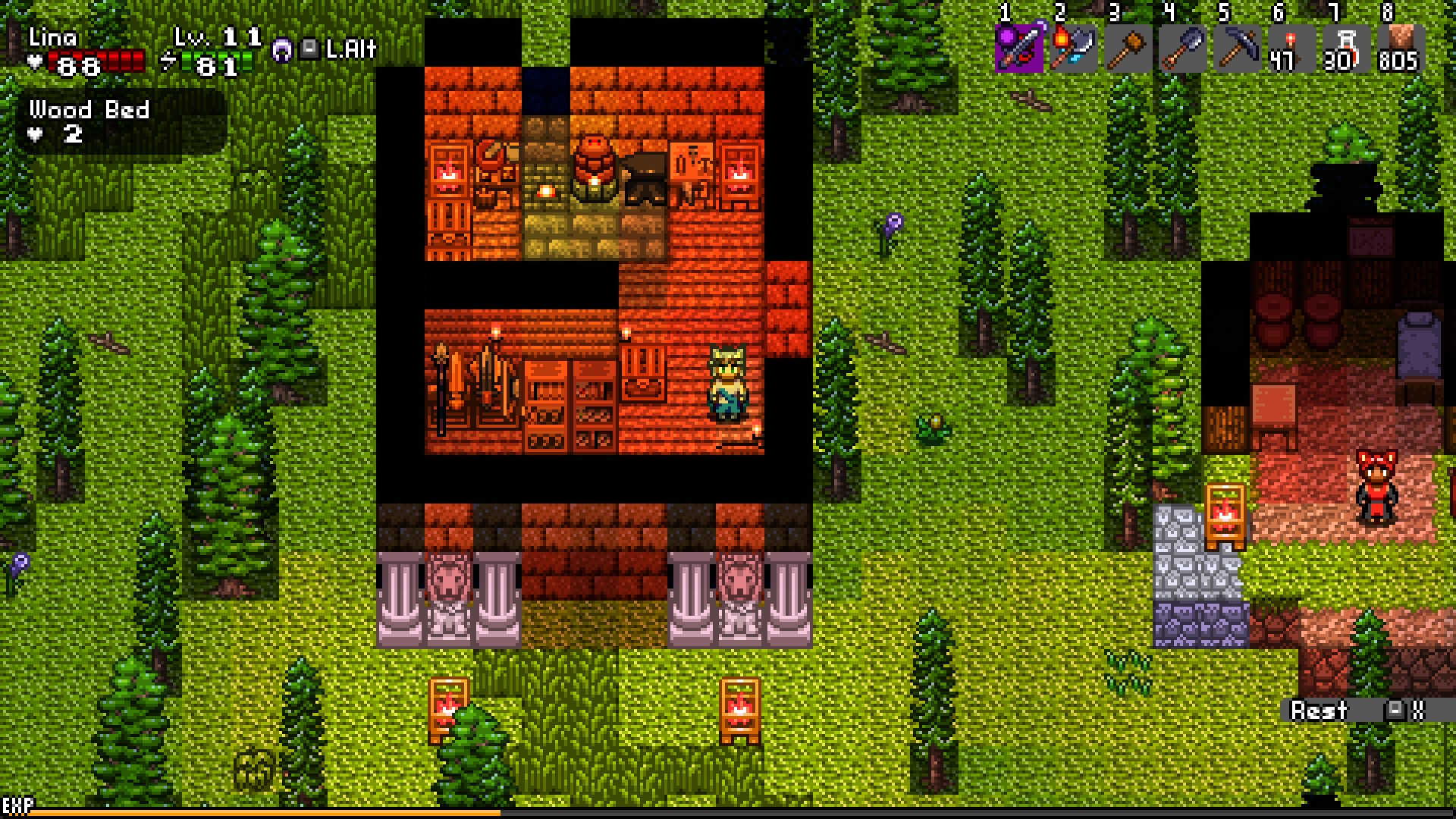
Minecraft has wool blocks that you can dye different colors specifically to allow players to erect constructions that are multi-colored. Terraria at this point is positively bursting at the seems with wall variety and the capacity to paint the walls. LandTraveller, at least in its current form, is sorely lacking this kind of purely aesthetic building material.
So far as cosmetic clothing goes, you can stick a flower in your hair, put on witch robes and a witch hat that the fanatics wear, or put on monster booties.
A Matter of Perspective
When I first saw LandTraveller, the first thing that stuck out to me was the single perspective where elevations were displayed as simply being one screen tile higher on the screen than a lower elevation. I was certain this had to be a 2d game that had some tricks to make it feel 3d, like classic Super Nintendo games such as The Legend of Zelda: Link to the Past, where you could jump “down” cliffs. I couldn’t imagine you could make a game that wouldn’t be impossibly confusing with its elevations if you tried to build a 3d world but forced a single 2d presentation. Well, I was right that it’s massively confusing, but LandTraveller went and has this perspective, anyway.
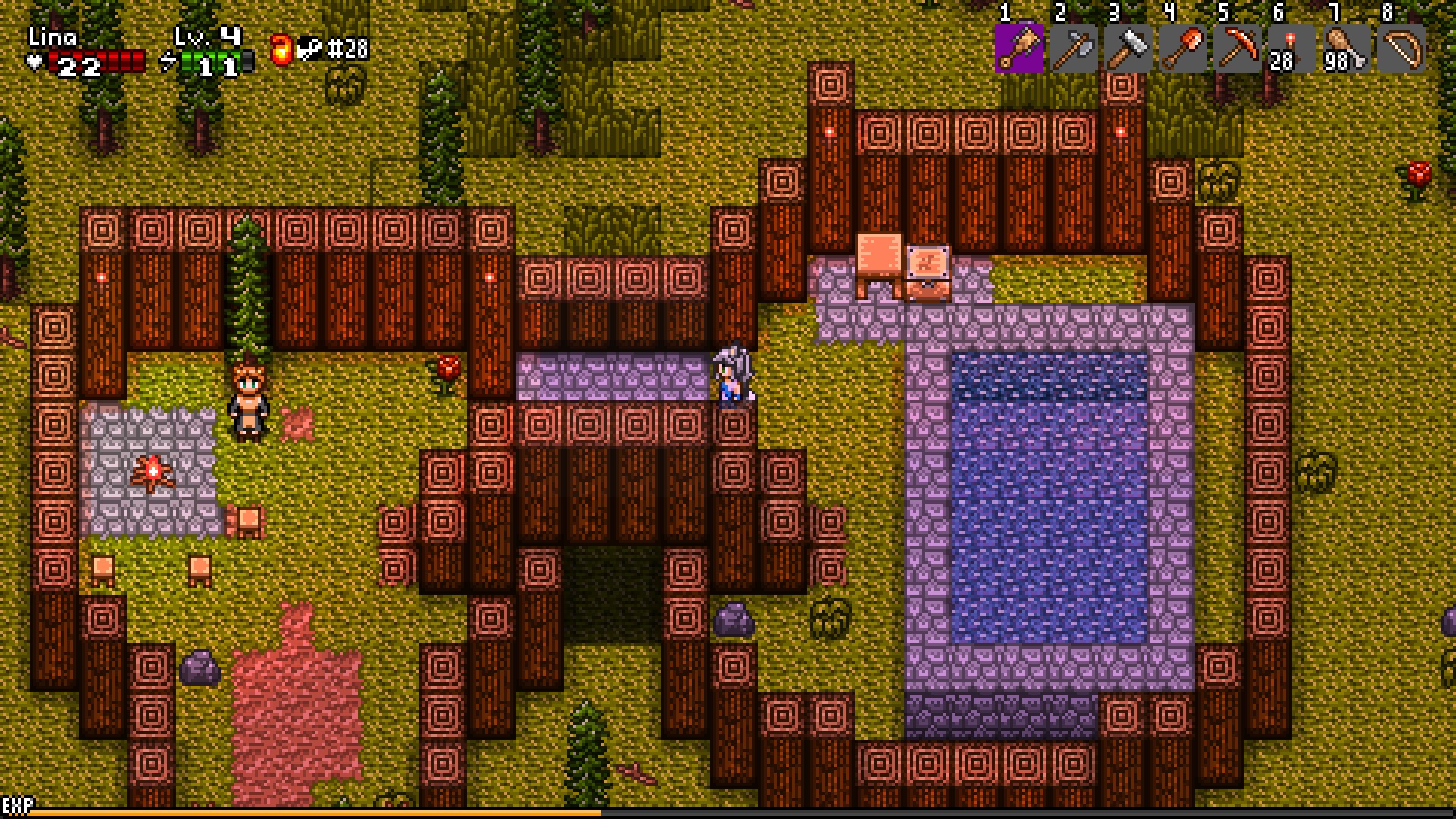
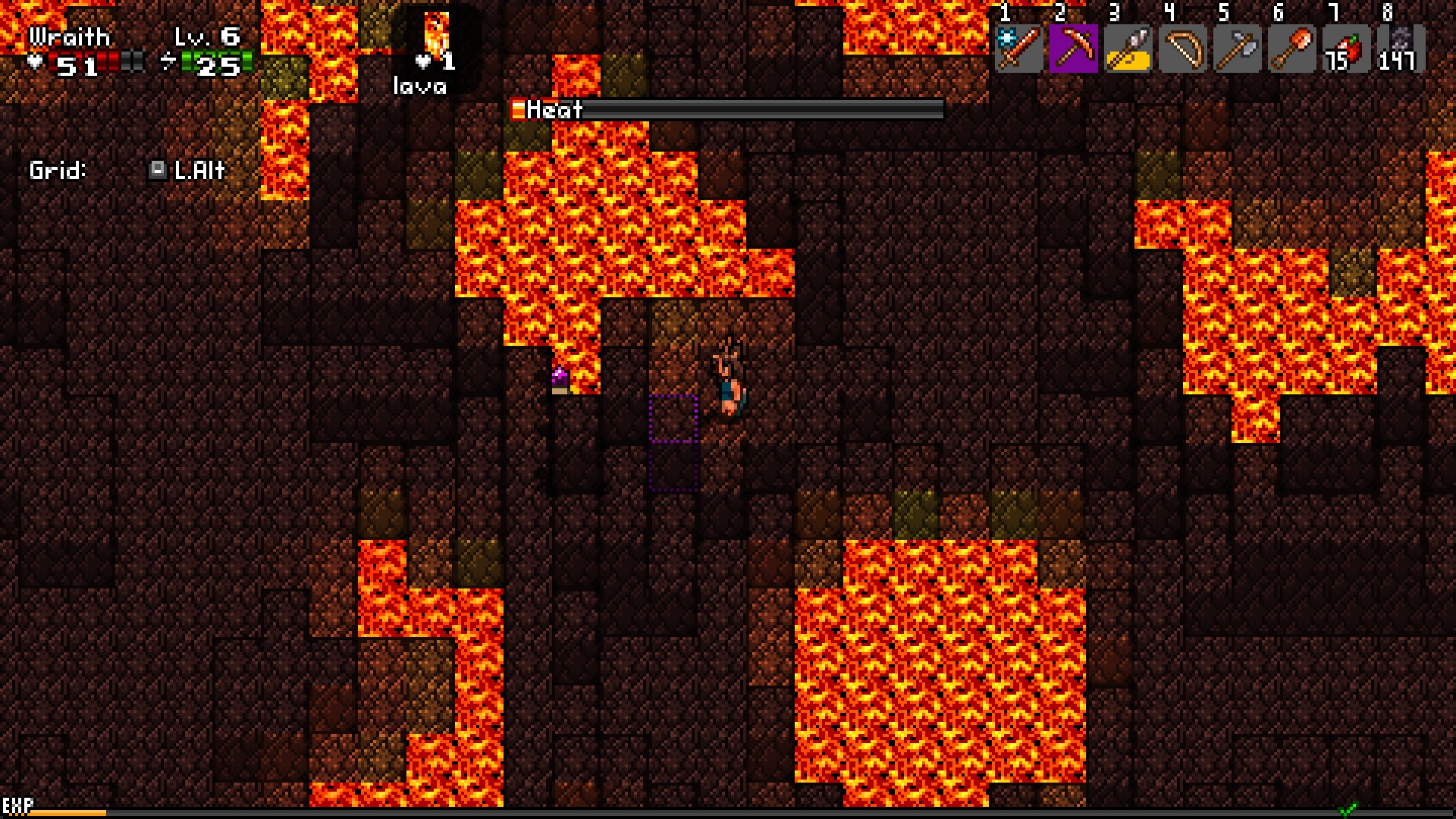
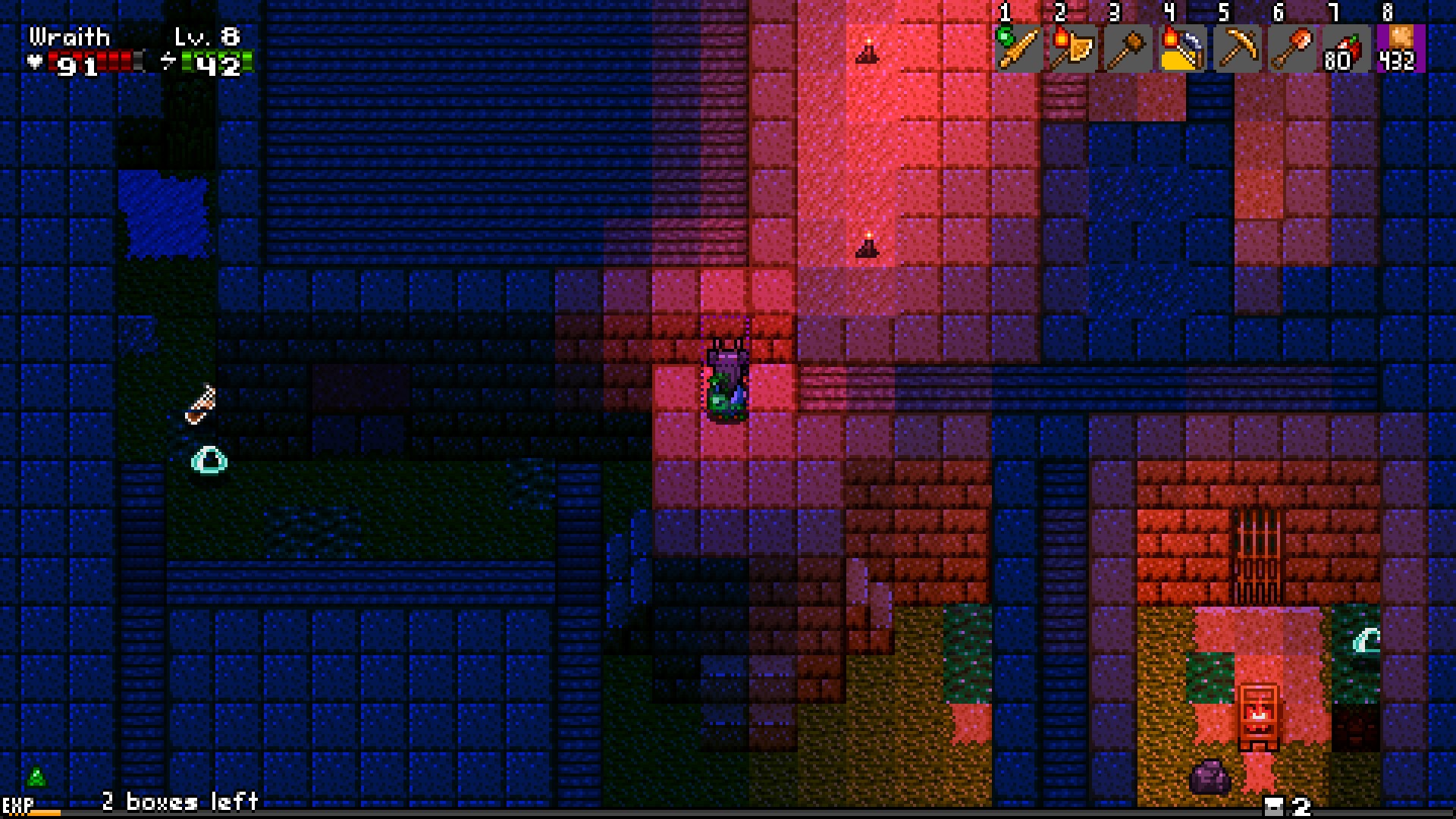
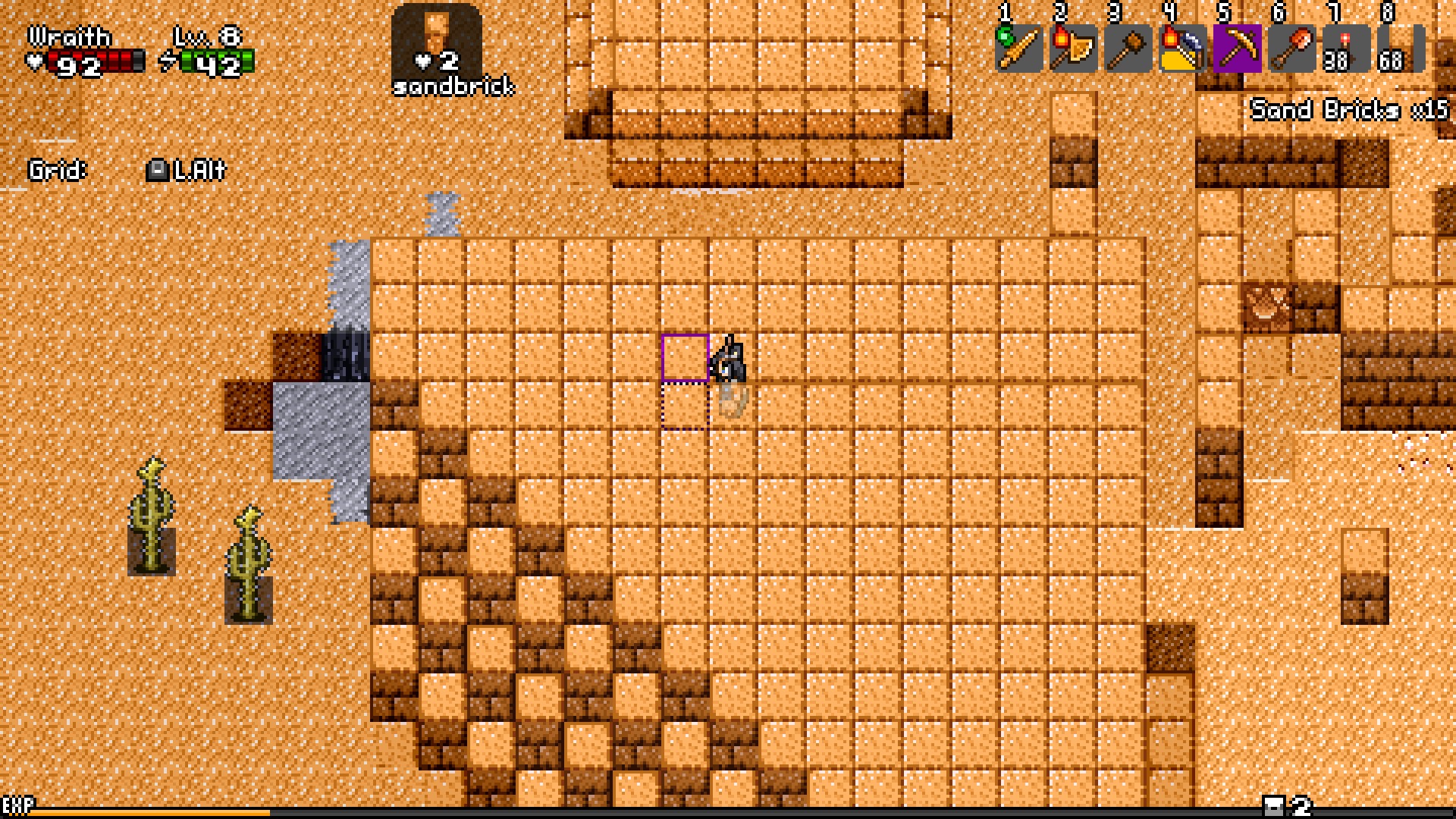
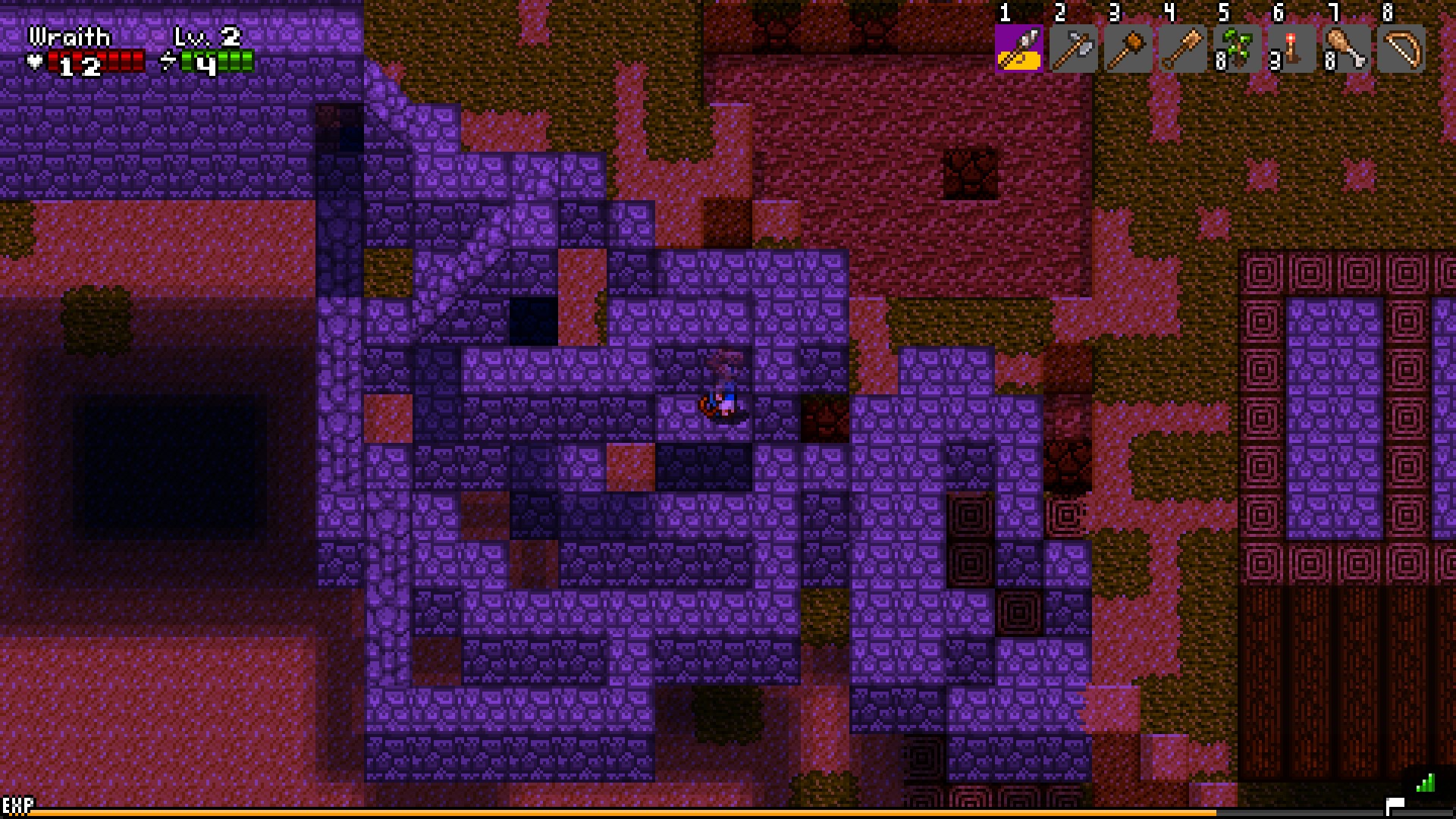
Most of the terrain in the game is just mostly flat ground with some occasional slopes on purpose – it’s basically the only terrain that this game engine handles well. Any time that the game has to show changes in elevation greater than one at a time for anything other than houses, however, the game has serious trouble with confusing players. One of the most common areas that this is a problem is in the “maze” sections of boss area maps, which I fully recommend you just do not enter at all, except to grab the chests for completion approaching from outside the maze and get back out.
It is possible to blindly stumble around and “feel” out the area by aiming blocks around to see where empty spaces are, but remember, this is a game primarily focused upon unrelenting combat where enemies spawn constantly. You just can’t take the time to figure out complex terrain while having to also dodge monster attacks.
I also have to point out that lava especially causes problems because it is opaque. This means it’s very difficult to determine what elevation the lava is on, especially since it glows so the shading of different elevations doesn’t apply as much to lava.
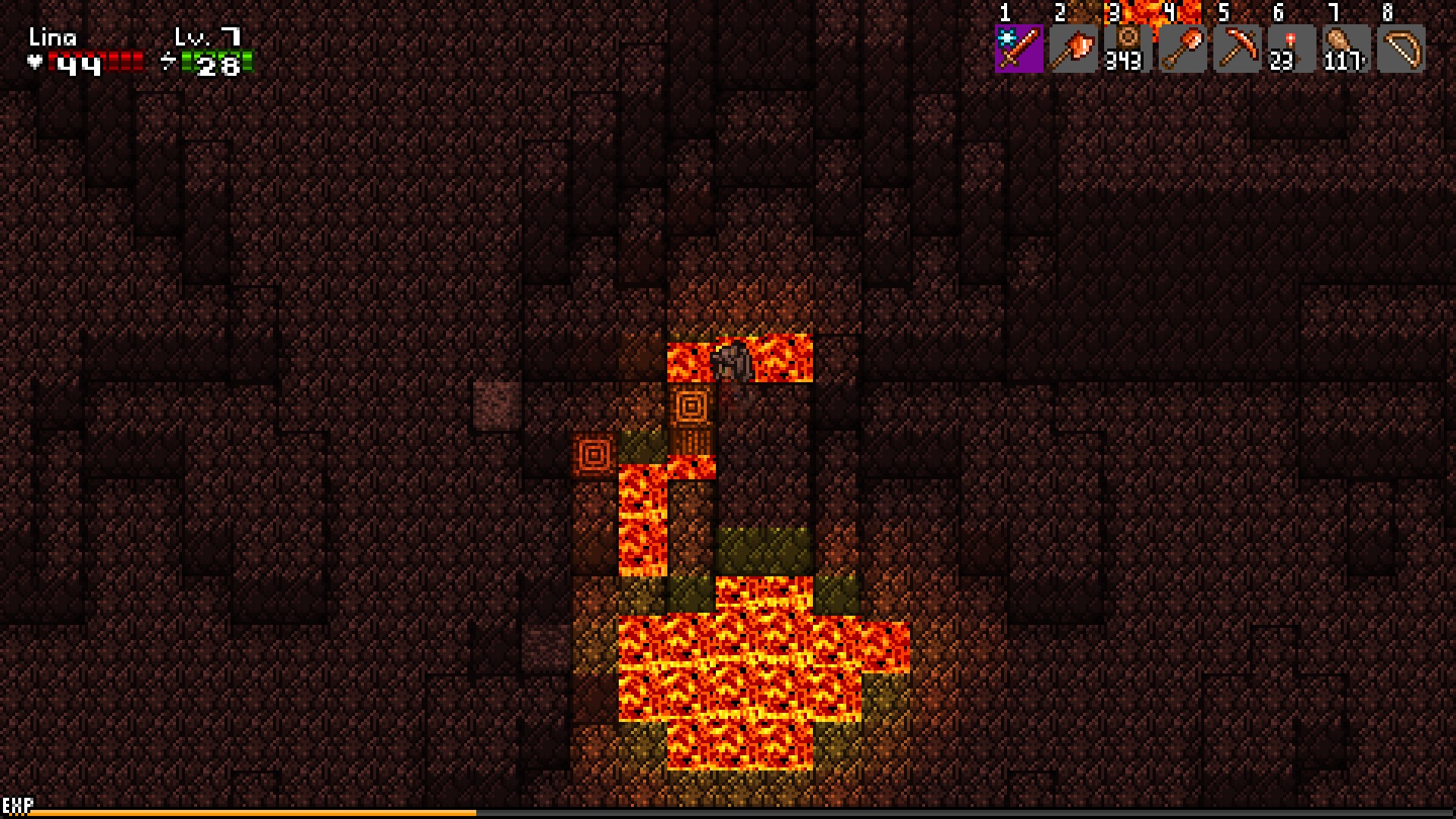
The game engine is apparently optimized for displaying the game like this, and so there’s no changing this, even to do something like just set the amount of offset a single block of elevation does by something other than a single tile. The result is a 3d game that cannot really use its full capacity to be 3d without being incomprehensible to the player. It’s almost like other games never did this kind of perspective for very good reason!
Difficulty
I managed to get in contact with the developer of LandTraveller since this project has low enough traffic as of this writing that people commenting on the game have a reasonable chance of hearing a response. One of the things I tried to talk about was the uneven difficulty that the game presented.
I’ve complained at length about the volcano area, which is the first boss monster area, for example. It really is the worst part of the game. It is the only area of the game I will consistently get killed, and it’s not because the monsters there are hard – they’re fairly toothless when it comes to direct attacks, in fact, and they tend to jump into lava and die more often than threaten me – but because I keep falling into lava I didn’t see because of the perspective problems described above.
The first boss, Thermophile, is also the hardest boss in the game. It comes at a time when you cannot craft healing potions, and you can only have gained two through a non-repeatable quest, and if you lost them through death or just plain used them at some point, you have no way of getting more. As the first boss, it’s also the one players face when least familiar with the game or how to judge boss patterns. One upvoted image on the community board shows one player in multiplayer saying to another “we die in like 2 seconds lol” about the Thermophile.
Meanwhile, after having faced Thermophile, I prepared very carefully for the second boss in the game… and defeated it in one try without taking damage. The second playthrough, I was much more relaxed and didn’t bother preparing for the second boss, accidentally bringing only lightning orbs so my special attack on my special-focused character did electric damage to the electric-elemental boss and did no damage. I was forced to use the spear that was my backup weapon I wasn’t specialized in. I took damage once because I wasn’t quick enough in hopping away from a bite.
The chapter 3 boss was somewhat more of a challenge/endurance match, and I took damage, but I was never dropped to below half health because by this point in time, I had a massive stack of healing potions thanks to farming, and I could easily take my time wearing the boss down. Whereas Terraria has a “potion sickness” debuff that prevents chain-chugging potions by refusing to allow you to drink another healing potion within a set timeframe of drinking the last one, LandTraveller makes tinctures and other healing items you can take while in combat alcoholic, so you can drink several in short order, but they create an unsteady effect if you drink too many in too short a timeframe. Unlike Terraria, the exact times are not shown to you.
The game, in no small part because of how leveling and specialization works, becomes easier the further you go into the game so long as you are playing to your specialization. There are players who find their builds fall behind and struggle, but if you are min-maxing, by mid-chapter 3, you can start one-shotting any enemy that isn’t specifically resistant to your attacks.
As previously mentioned, LandTraveller is fundamentally a much slower-paced game than pure roguelites such as Binding of Isaac. Not just the enemies move slower, but you move slower, and you freeze in place while acting. The developer mentioned that the combat was made like this because they have poor reflexes, so they made a game based around predicting enemy patterns and acting before enemies do, not reacting and dodging.
I talk about all this because when I was talking to the developer about how the game seems to just get easier after one really annoying stage, they said that they wanted to make this a “hard game”. One where “only 5% of players will see the ending.”
The thing is, this is not a good hard game. Good hard games are “tough but fair”, and the only times I’ve had trouble in LandTraveller have not come at the hands of enemies, who are largely pushovers besides the bosses, but from bad camera angles leading to walking into lava in the first chapter, or a couple of other situations that feel more like bugs than legitimate challenges.
For example, in chapter 3, there are purple lion-like monsters that can call down lightning on a spot, although it has a charge-up time where the enemy has a specific pose that gives you time to move. The problem only time I really get hit by this, however, is when the enemy isn’t on the screen. If I’m down in a cave, the monster can be standing above me, off-camera, and call lightning from the sky that goes through the ground to strike me inside a cave when I have basically no notification the monster exists.
Add to this the fact that you have no invincibility frames after taking damage, and after getting hit and knocked back by an enemy, you can be thrown into another enemy (or worse, lava in the volcano), which can lead to your character getting pummeled to death in short order. Those lightning monsters mentioned above, for example, can come in trios that zap you all at once, hitting you seemingly from nowhere three times in a fraction of a second. While your character cannot be entirely stun-locked like enemies can be, enemies can also jump on your head and attack from there, and there’s no really good way to deal with an enemy above you without just taking damage.
The game is certainly fairly stingy with healing, especially early in the game. This means that the game basically is very lenient on combat, allowing for a low skill floor to avoid damage, but it punishes mistakes harshly because you have to either eat consumables out of combat to recover unless you have a healing potion. (And there are long-term bugs still being addressed where monsters can keep you “in combat” even when they can’t reach you.) Similar to how Legend of Zelda enemies can drop hearts, LandTraveller enemies can drop red orbs for 32 HP, but they do so at a vastly lower rate (seemingly a ~2% drop rate) than Legend of Zelda. The only way you can survive on red orb drops is if you are taking so little damage from monsters that you basically don’t need the health at all. (That said, red orbs only disappear when chunks are despawned, not based upon time, so it’s possible to “stock” red orbs on the ground if you avoid picking them up for when you are in trouble. Red orbs only drop if you are at less than full HP, however.)
Further, some enemies have some alternate ways of damaging you. The fire imps in the volcano, for example, generate heat out to a range of two tiles. Lava, meanwhile, generates heat out to a range of one tile, so apparently, imps are hotter than lava. Heat sources in this game stack, so being near three heat sources at a time results in filling up the heat bar three times as fast. Additionally, fire imps spawn very close to the player such that moving at all in close quarters can spawn more of them every second. Fire imps additionally keep generating heat even after death. It creates a Catch-22 situation, where you want to move away from a dead imp to evade their heat, but moving just spawns more imps to generate more heat.
The imps themselves deal 1 damage when they attack, but their heat hits for 7 damage about 3 times per second, plus sets you on fire, dealing 6 damage every three seconds for somewhere around 30 seconds. Also, at this point in the game, you probably have about 40-80 HP, there is no way to cure being on fire but waiting it out, and your best healing item at this point in the game gives you 7 HP per second and cannot be eaten with enemies around – which means imps spawning interrupts your eating. Are the monsters or their side effect the threat? On a basic level, the fact that imps can spawn so continuously and the amount that heat can stack needs to be clamped down so that unlucky spawns doesn’t cause a character to instantly combust.
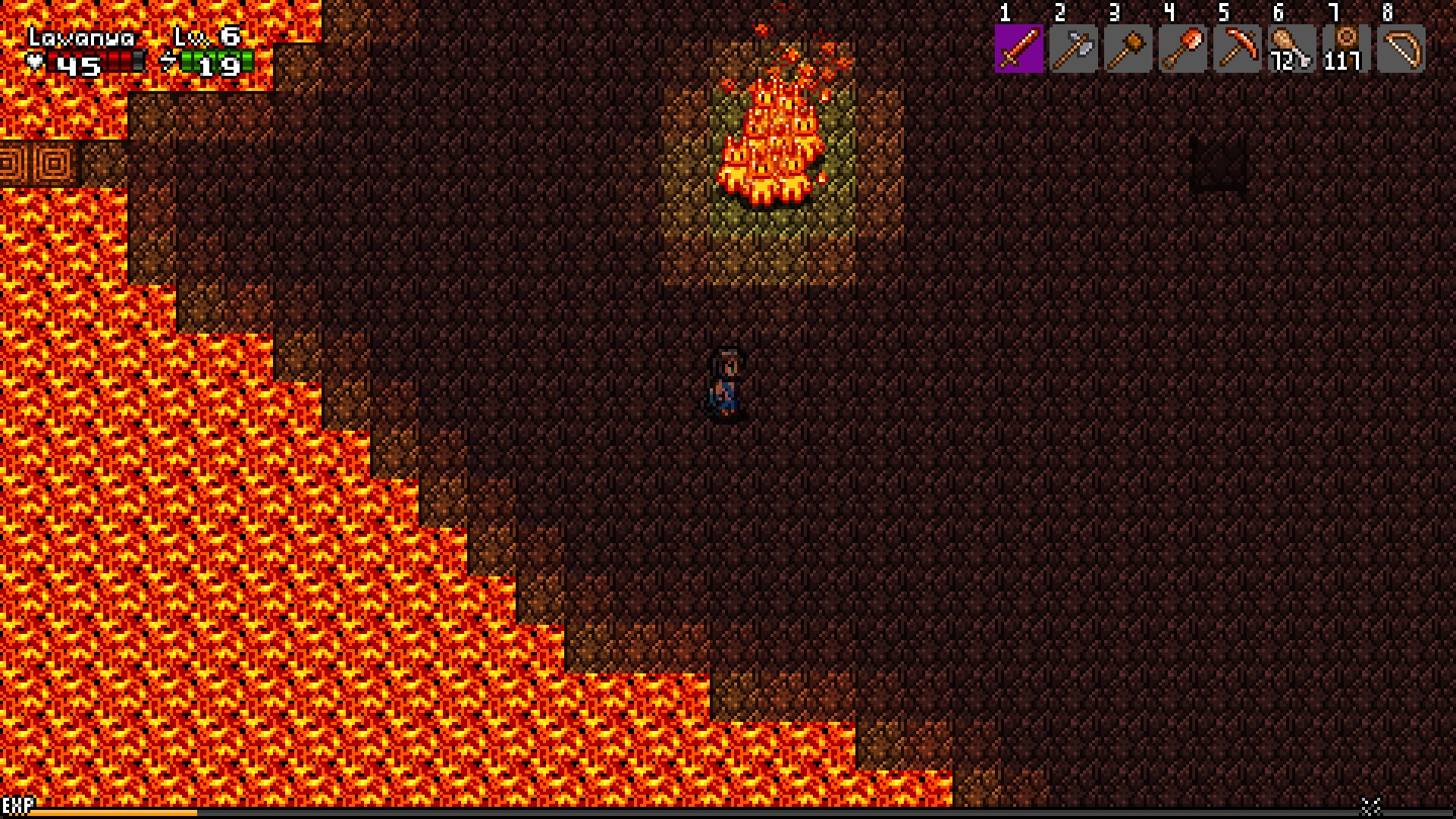
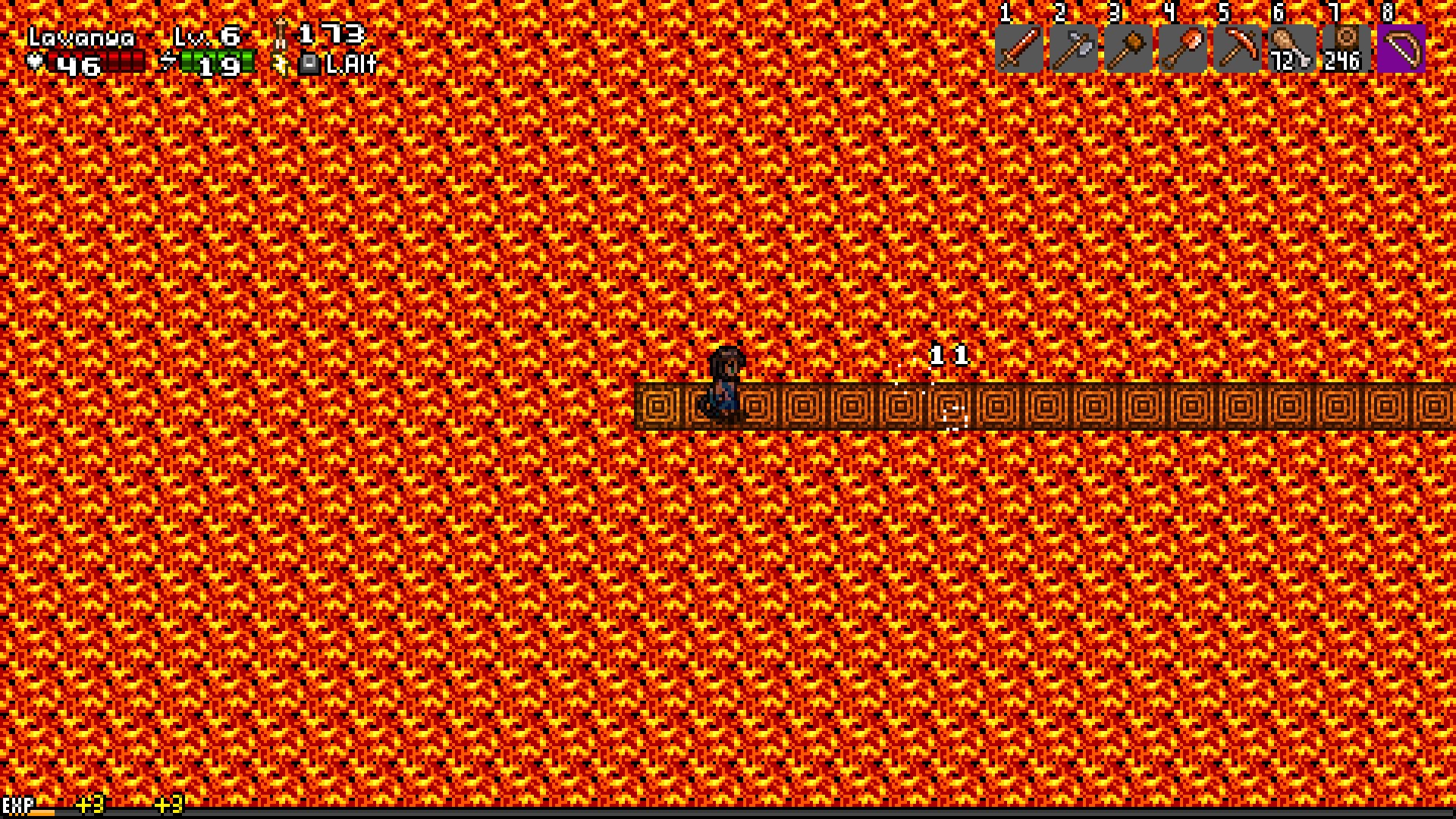
The fact that the monsters themselves deal trivial damage is also a result of the RPG-style leveling mechanics. Again, levels multiply everything about your character, and this seems to include armor, so if you’re leveled up, you take single-digit damage from monsters while dealing triple-digit damage. With abilities like “Woods” on a deer character, I can shoot enemies I can’t even see for more experience, trivializing the combat. The parts that are supposed to be hard are trivial, while the edge cases and arguable bugs are the only things that still threaten the player due to the way that the combat system and leveling system are constructed.
Now, being easy wouldn’t be a problem if it were trying to be a more relaxed game where combat isn’t a primary focus like Minecraft or Rune Factory. However, the developer wants LandTraveller to be a hard game, and pushes very high spawn rates so that monsters are wandering next to you nearly by the second, making it difficult to get anything besides combat done unless you deliberately wall yourself off to prevent monsters from getting close. The problem is that the style of combat, and the absurdly unbalancing effects of leveling tend to make the game swing wildly from trivially easy to insurmountably hard from one player to the next.
This is best exemplified in Fog Forest, a forest between the main chapter 2 map and the main chapter 3 map. Its main feature, besides a rapidly flowing river, is the fog that starts a fear bar when you go past a certain point. This is basically a countdown to death, as filling the fear bar makes your character uncontrollable, and once uncontrolled, you basically might as well force quit because you cannot regain control without leaving the fog zone, which is something impossible to do while not controlling your character. The only way to drain your fear gauge, besides leaving the fog, is to kill ghost-like enemies that are often hidden behind a maze of trees that are difficult to see in the fog. Additionally, they have fast and powerful ranged magic projectiles that shred physical-focused characters.
However, if you play as a mouse, you can be immune to fear entirely, while a deer can shoot through the trees to easily snipe the ghosts from long range when the ghosts cannot get line of sight to shoot back.
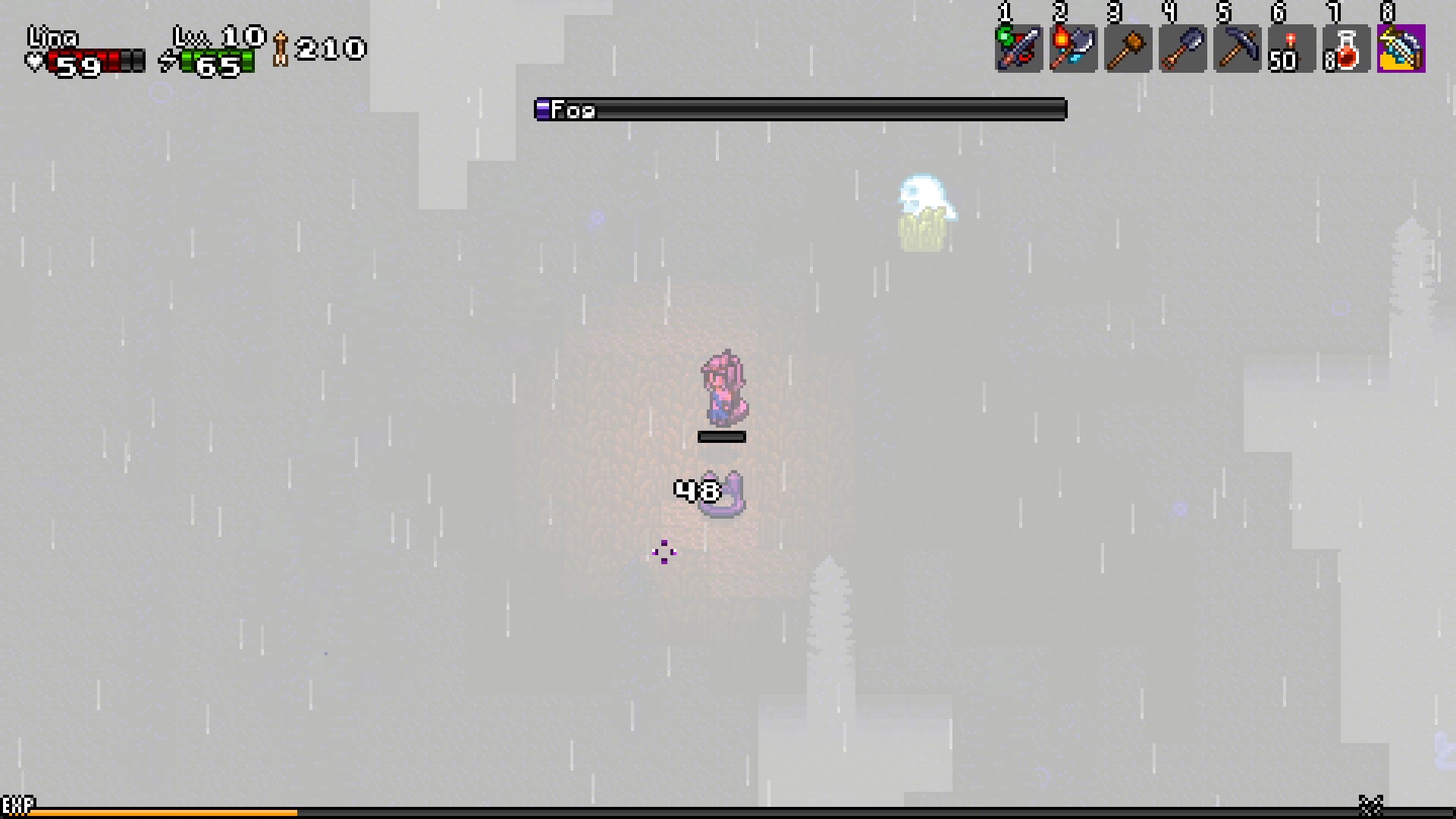
The developer says that they don’t consider things problems if they “can think of three ways to solve any problem” players have, but two of these are always races and skills that are tied to races, which are unchangeable without restarting the game after hitting a wall 30 hours in. Plus, the “right” race changes based upon chapter. The last way to solve a problem is a specific piece of equipment, however oftentimes, these pieces of equipment are far less useful a solution than presented. The fire imp video above, for example, is with my character wearing the gear that grants fire resistance. This only doubles the size of the bar, which at best just doubles the amount of fire imps that can spawn at once before you’re screwed faster than you can react, but it’s still a number within the range of how many fire imps can and will spawn on top of you.
In any event, my specials-based characters could all trivialize Fog Forest because I both have the stats and skills that are most beneficial to that area and ranged attacks allow me to snipe the ghost monsters much faster than a melee character would have to wade up to them, sparing me valuable time.
Finally, the style of slow combat with overly predictable enemy attacks, yet overly harsh punishment of the slightest mistake just cannot create a smooth difficulty curve that would create tension in a hard game like a Dark Souls, or even Terraria. Difficulty is just far too inconsistent, and dependent upon being in an awkward situation caused by tighter quarters or rushes of enemy spawns that the current way procedural spawning works isn’t built to support. The game just isn’t built to deliver “tough but fair” in its current form.
The Terraria Comparison
I’ve compared many points about LandTraveller to other games, especially Terraria. Well, there’s a reason for this, and it comes from something else I read from the developer. The developer said that being into Minecraft and Terraria a few years ago is what got them to make LandTraveller, especially the things about Terraria that annoyed them, making them want to make their own “answer” to Terraria. This statement really made things about LandTraveller click into place for me.
Terraria, for example, is a block-building sandbox that has a focus upon combat. It features many boss battles, but in order to make its block-building core gameplay relevant to boss battles, Terraria lets you build “arenas” to fight bosses within. You can fight the Eye of Cthulhu just anywhere, but at the time you first face it, you are limited in mobility, and to dodge its charges, you need to build a location with many floors of wooden platforms to give you vertical jumping space to evade a charge, and if you want to evade horizontally, you need to clear away obstructions so you have a smooth runway. The Eater of Worlds is vastly more difficult to fight in the tight underground caves where it spawns, but if you evacuate back to a smooth flat runway of wood platforms on the surface, you can force the giant worm out of the ground where it is less maneuverable. This is a system that reinforces how block-building is a core mechanic of the game by allowing it to directly assist you in fighting bosses, provided you are patient enough to use it.
LandTraveller’s developer, however, said that being able to build boss arenas was “cheesing the boss”, so boss fights in LandTraveller take place in pre-built arenas where you’re not allowed to alter the terrain (even if it’s being flooded with lava). Together with the story mode having pre-built cities, this leaves the game feeling like it only tacked on the block-based building as an afterthought because the game gives you so little reason to use what is supposed to be a core element of its genre.
Terraria also has no leveling system. This is because Terraria expects you to play any individual world for a hundred hours or so, and it wants to be sure that it is balancing its challenge for players that can be expected to always be at around the same power level when they are reaching certain challenges for the first time. It also means that if a player finds that a certain set of equipment is not suited for a given challenge, players can swap out their builds on the fly, as builds are entirely a matter of equipment. Terraria is a game about questing for more stuff you need to beat the next challenge that you want to overcome to get the next stuff.
LandTraveller, however, has a leveling system that not only significantly imbalances the game, but it makes it so that when players find they are up against challenges their builds aren’t made to handle, they basically have no solutions besides restarting the game or arguing for a rebalance in the forums. If a player has problems with Fog Forest, the only equipment that will help in the current version of the game is the meteor circlet that gives a +1 to will, which is hardly overwhelming, and beyond that, there’s just level grinding. This equipment-based solution also runs up against the innate specialization players are made to chose – characters can have specializations in heavy armor, but the only elemental resistance equipment in the game are light armors. If, when I brought up how quickly overlapping fire imps can raise heat and sustain it through repeated spawns, the response was to just wear the otherwise nearly useless fire-resistance armor, then it’s telling heavy armor specialists to go against their specialization they sank their skills into.
The way that LandTraveller has move-to-aim controls and no mouse aiming is based upon the developer’s disdain for the mouse aiming and “clumsy combat hitboxes” in Terraria.
Although didn’t ask on this front, thinking back, the lack of invincibility frames that can lead to instant death is likely a direct response to the very generous invincibility frames in Terraria, as well.
Even the top-down perspective is apparently based upon just building prototypes and going for the one the developer found was “most fun” in the combat.
When talking about those Four Horsemen games back at the very start of this article, I mentioned that one of their core failings is that they don’t have a clear idea of what they actually want to do with their game, they just want to make something similar to a game they liked before, but then add in elements of other games without considering the context of the mechanics they were supposed to play off of. This gives you things like thirst meters stuck in because it’s a survival game without considering how thirst meters are supposed to impact gameplay, or how players are supposed to respond to the mechanics.
LandTraveller is seemingly built with a similar “can’t find the forest for the trees getting in the way” approach. The developer says that most developers on YouTube that talk about game design are being “armchair”, and only talking about abstract things that have no real relevance to actual games, but it feels like spending a little more time thinking through how to make the various elements of the game more cohesive would fix a lot of LandTraveller’s recurring problems, or at least curb some of the wasted potential when major elements of the game like base-building have no outlet, or new content being introduced that would make a player want to change builds without having any method of doing that besides starting over. Many of the major decisions that cause issues in LandTraveller are things done differently from Terraria because they were outside a more typical RPG mold, but without taking into full account that these things were different in Terraria for important gameplay impact.
As it stands, it feels like a small miracle that LandTraveller manages to be as good a game as it is. I think its best attributable to the fact that the developer plays through the game with different races very frequently, so they tend to be tweaking the challenge often. That said, the developer is also heavily experienced in the game, so they often don’t understand when players have trouble in certain parts of the game.
Again, if it’s meant to be a hard game, it only manages to be a threat to the player when they have been lulled into a false sense of security by the 98% of the game that is either totally safe (being in safe zones crafting/mucking about), functionally safe (pure traversal), or fairly safe and distracted (mining or other looting) that they aren’t paying attention when that one edge case that can screw them over, like a continuous swarm of fire imps suddenly keeps spawning on top of them. I don’t think Terraria, outside of the explicitly labeled difficulty modes, really tries to be a hard game, but in terms of the tension that certain environments can cause in me, I was much more tense in the underground jungle in Terraria than in even the volcano in LandTraveller. I didn’t even realize Fog Forest was supposed to be tense until I saw it was one of the areas that a lot of players were complaining about having difficulty with on the forums. (Oh, and speaking of difficulty modes, this is another thing LandTraveller’s developer has strong feelings about, and insists on a dynamic difficulty scaling as a better solution. It has yet to be implemented, however, so I cannot speak to its effectiveness.)
Controls and Interface
Happily, this developer understands the importance of having a fully customizable control scheme on PC. You can rebind all the keys used during the game to any keyboard keys, although note that shift, control, and alt are used as keys, so no “shift+1” keybinds are allowed.
LandTraveller also supports controllers, including having a default profile on Steam Controller, although I personally rebound mine, anyway.
Some of the choices for controls makes it clear being able to play with controllers was in mind when bindings were chosen, because the developer is reluctant to add more buttons to the game. For example, the “blueprint mode” mentioned in the Perspective section was added as the “alt fire” button function when having blocks equipped. Recently, a “lock-on aim” function was added to bows to allow for firing diagonally in a recent update, however, it uses the “look up” key to do so. The button to select one item at a time from a stack in your inventory is also the same “look up” button (left shift by default). Depending upon how many more functions are added to the game as it goes on, this could lead to awkward overloading of functions on the same keys.
Mouse functions are fairly limited. You can use the mouse during menus, and use left click/right click as your primary attack and alt fire buttons, but you can also control everything from the keyboard, and the store page system requirements even directly recommends keyboard only or controller.
This can lead to some problems in-game that other games like Minecraft lack. You can only “turn” your character by moving in that direction. One major recurring problem for a block-placing sandbox is that you cannot place a block when your character partially stands inside that block. The problem is that your “reach” doesn’t extend past a block, so if you tap/flick right to place a block to the right of you, you might stick a toe into the block to your right, and suddenly, you’re blocking off your ability to place that block. This is annoying normally, as facing in a direction without moving into a tile is finicky and very annoying when sitting in a two-block-wide area trying to face right without occupying the tile to the right to fill in a wall. This gets potentially deadly for your character in situations where poison or magma pools are spreading, and you need to place a barricade quickly, and it feels like a cheap shot to get killed by a fiddly interface rather than any lack of skill on your part.
Navigating the menus by controller stick alone is generally fine, although you’ll have lots of flicking to go through inventory slots in your future since there is a lot of inventory management in the game. The one thing that actually requires you use the mouse is the crafting menu sorting function.
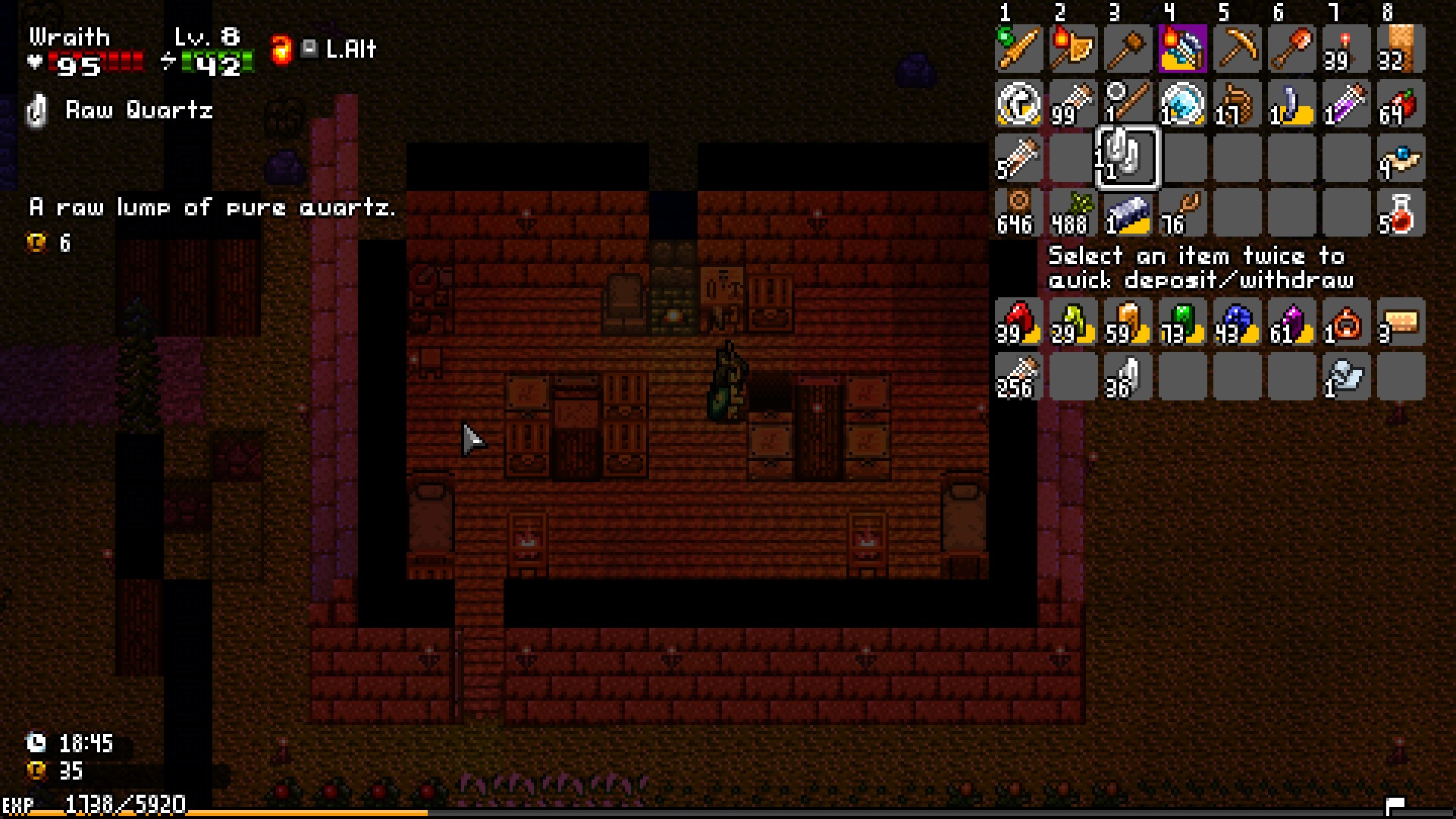
Graphics
Graphics-wise, outside of the issues with perspective, the game looks good and very much like a Super Nintendo game.
One issue I have is that, in an attempt to make the perspective problem somewhat easier, blocks higher in elevation than the character get tinted whiter and whiter, while blocks of lower elevations are shaded. At extremes, such as elevations more than 12 above or below the character, this just becomes solid white or black.
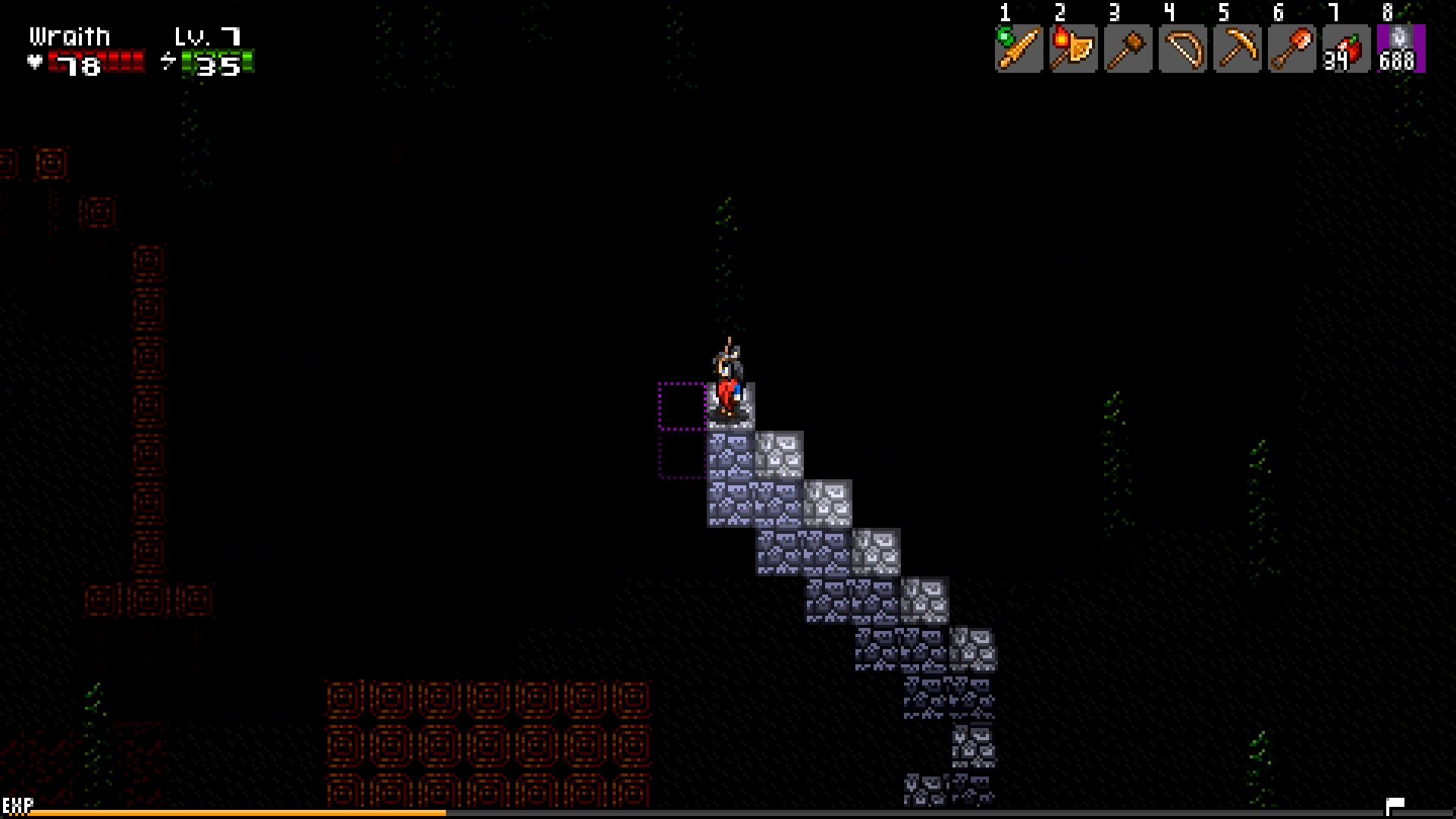
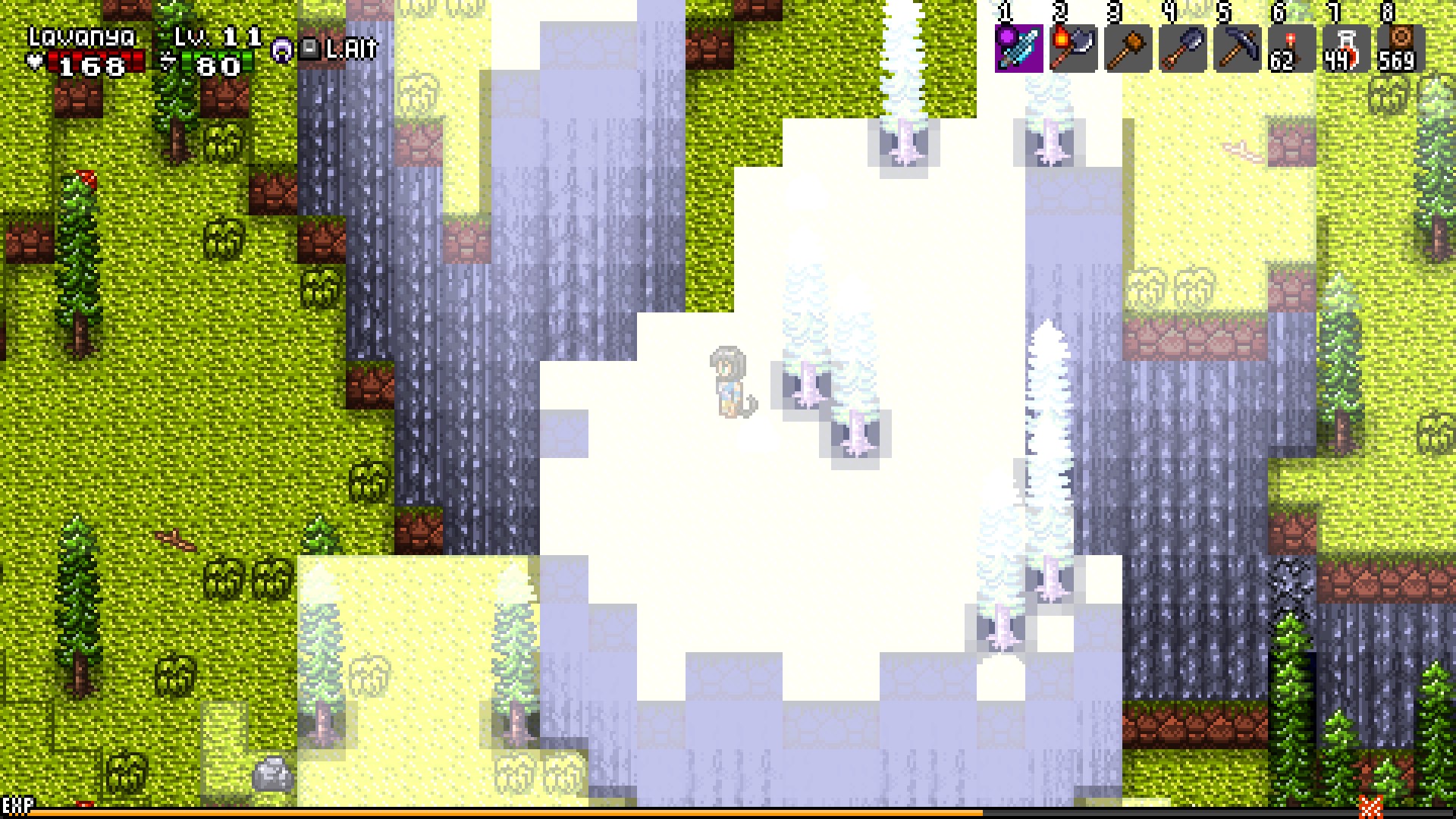
Sound
The game runs on chiptunes and deliberately synthetic-sounding sound effects.
Chiptunes can be hit-or-miss with some people, and some people seem to really appreciate the music in the game, but I have over 100 hours in this game, and no game’s soundtrack lasts long enough to still sound fresh after playing that much.
Bugs and Development
As previously stated, my experience has been that most bugs have been addressed soon after I raised them, so although I did manage to find quite a few, there isn’t much point in listing the bugs that don’t exist any longer by the time someone reads this.
That said, there are a few issues that I consider bugs, but which the developer gives the “they’re not bugs, they’re features” treatment. (Even pushing bug reports over into the “Suggestions” forum.)
One of which is the way that landmark “setpieces” are designed in a way where they do not respect boundaries to nearby bodies of fluids. Meaning that landmarks in many maps can be flooded, and in the volcano, they can be flooded with lava. This results in a very long, slow, and boring process of having to clear tiles of fluid away through placing blocks. (Placing blocks into fluid annihilates the fluid.) Also, to prevent players from draining oceans by just digging down (… Terraria), large enough areas of fluids will automatically refill if they are being drained, creating infinite fluid generation when they are flooding setpieces. This often means that the repeated “bloop” sound of water shifting is the only warning to hurry to a nearby landmark and create a dam before the whole area becomes an hour-long project to drain the area of water.
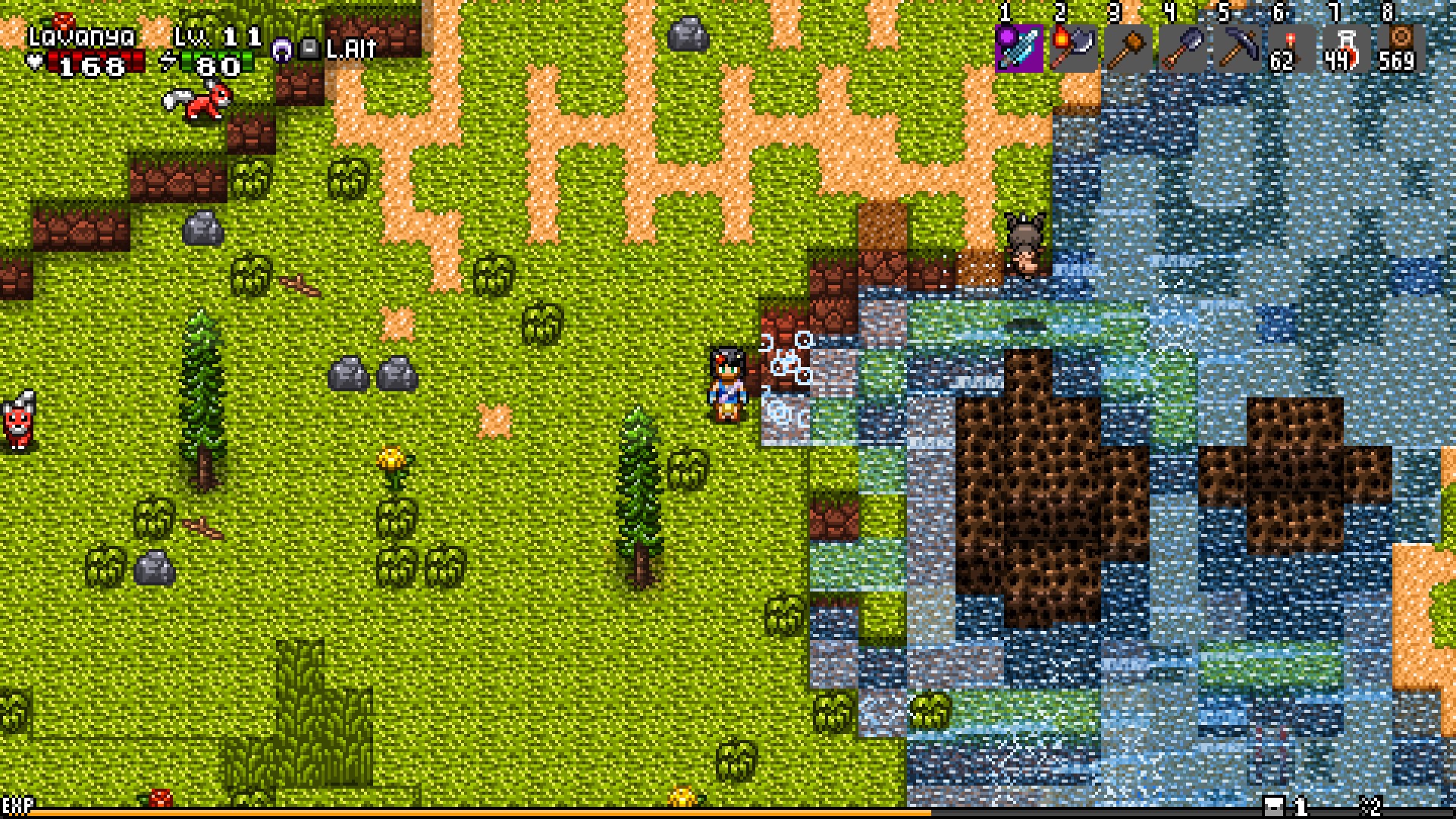
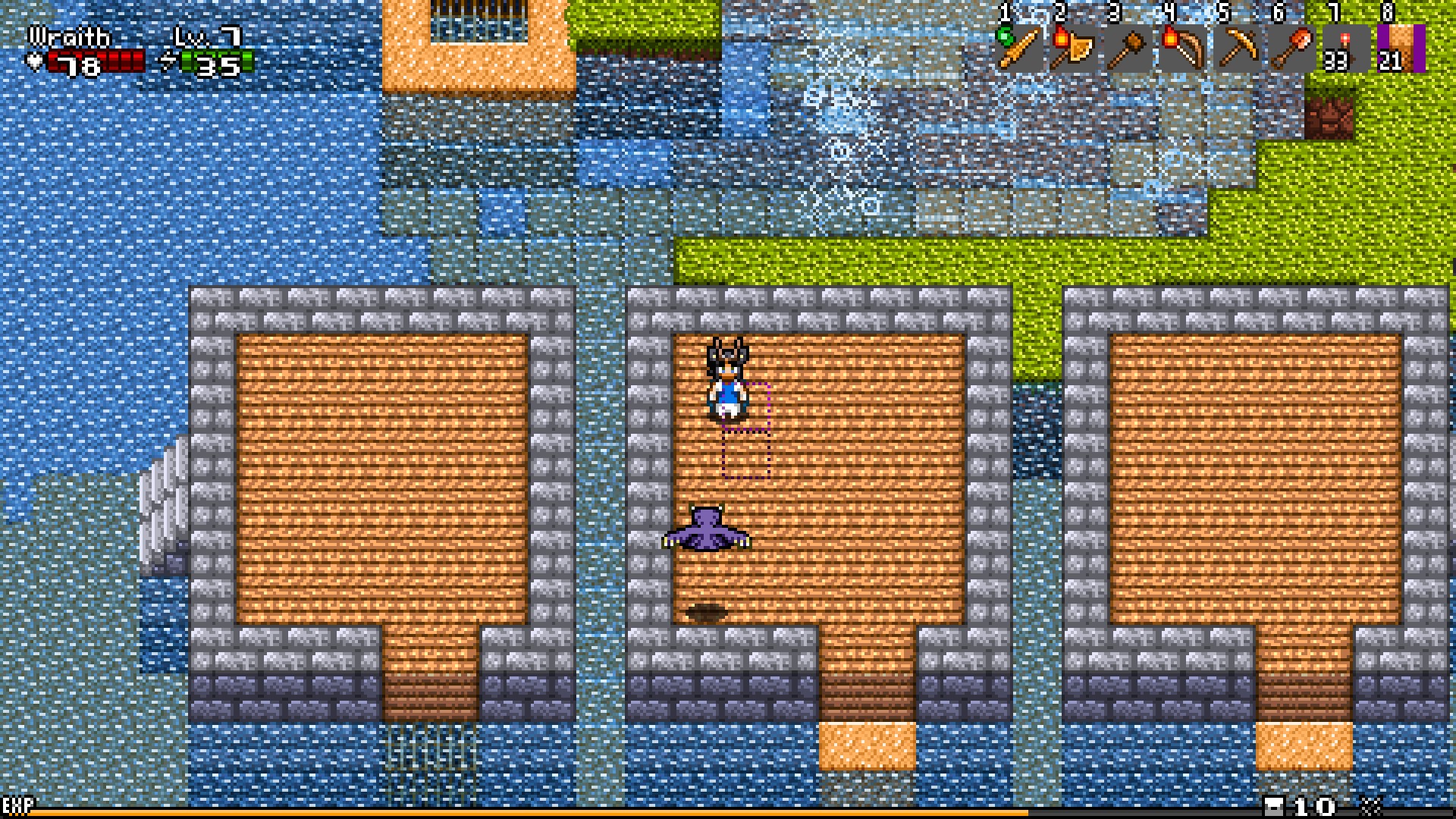
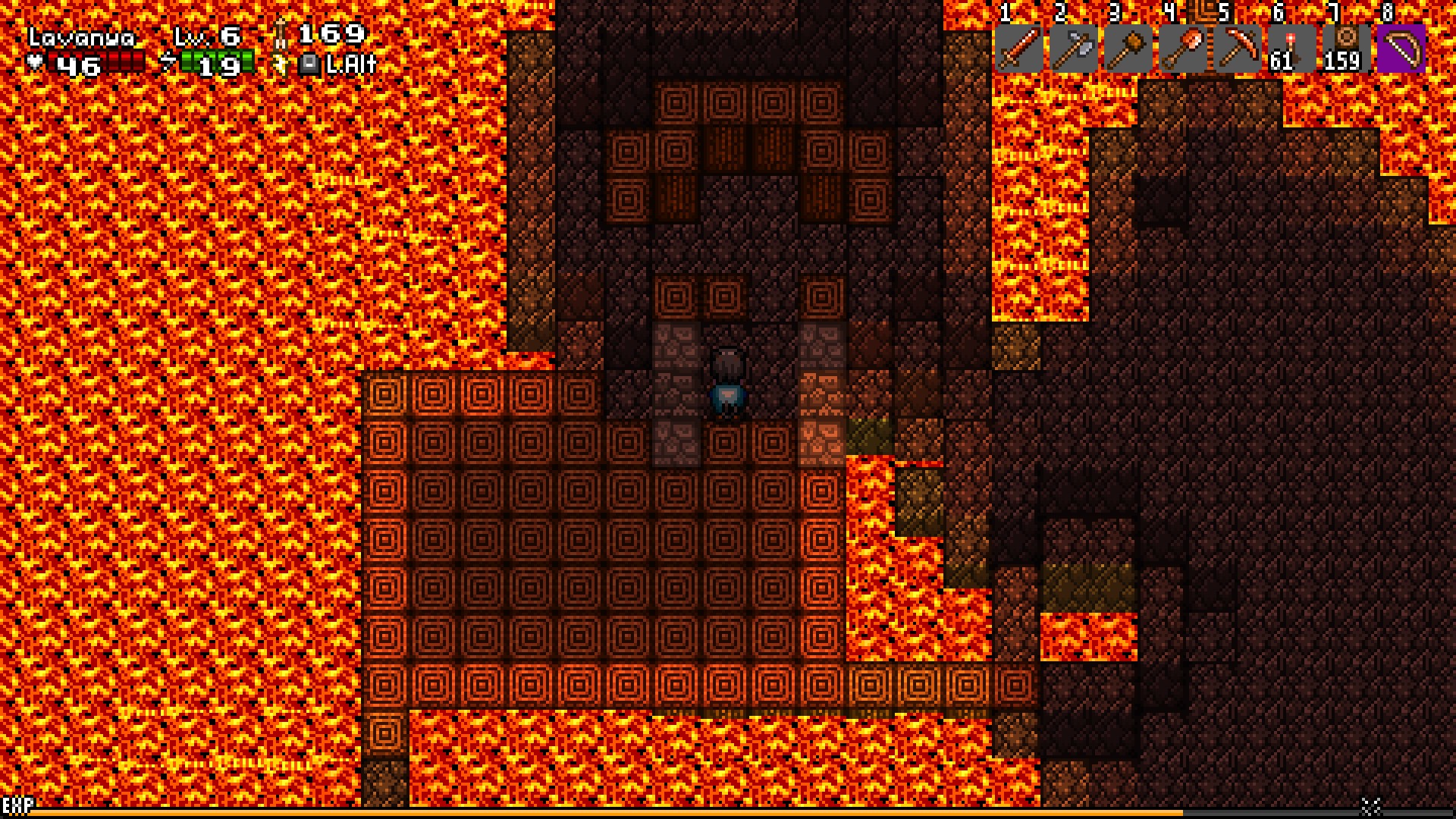
This even applies to whole landmarks being buried underground if the procedural terrain just happens to make a rise in elevation overlapping where the setpiece was meant to be placed.
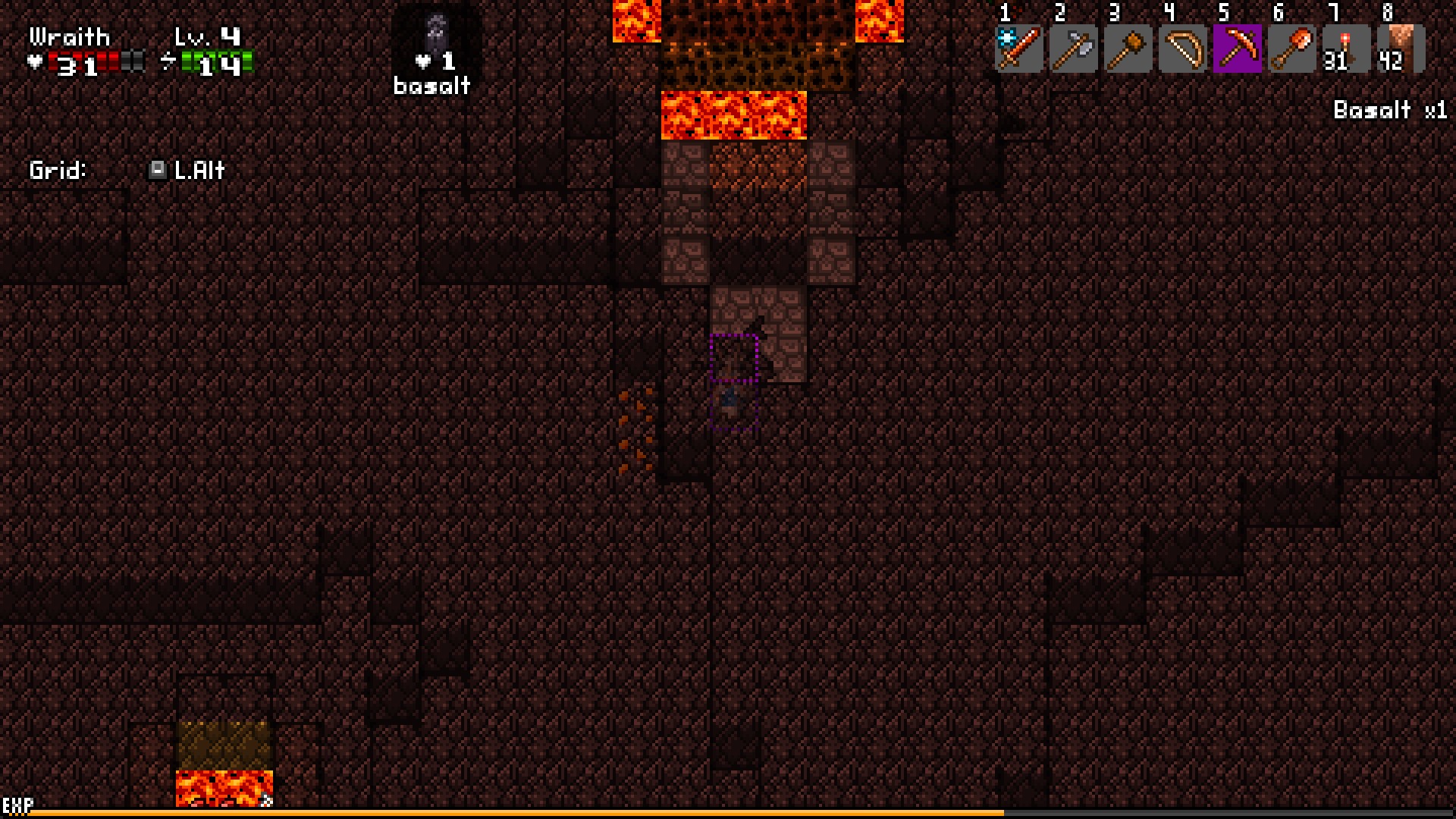
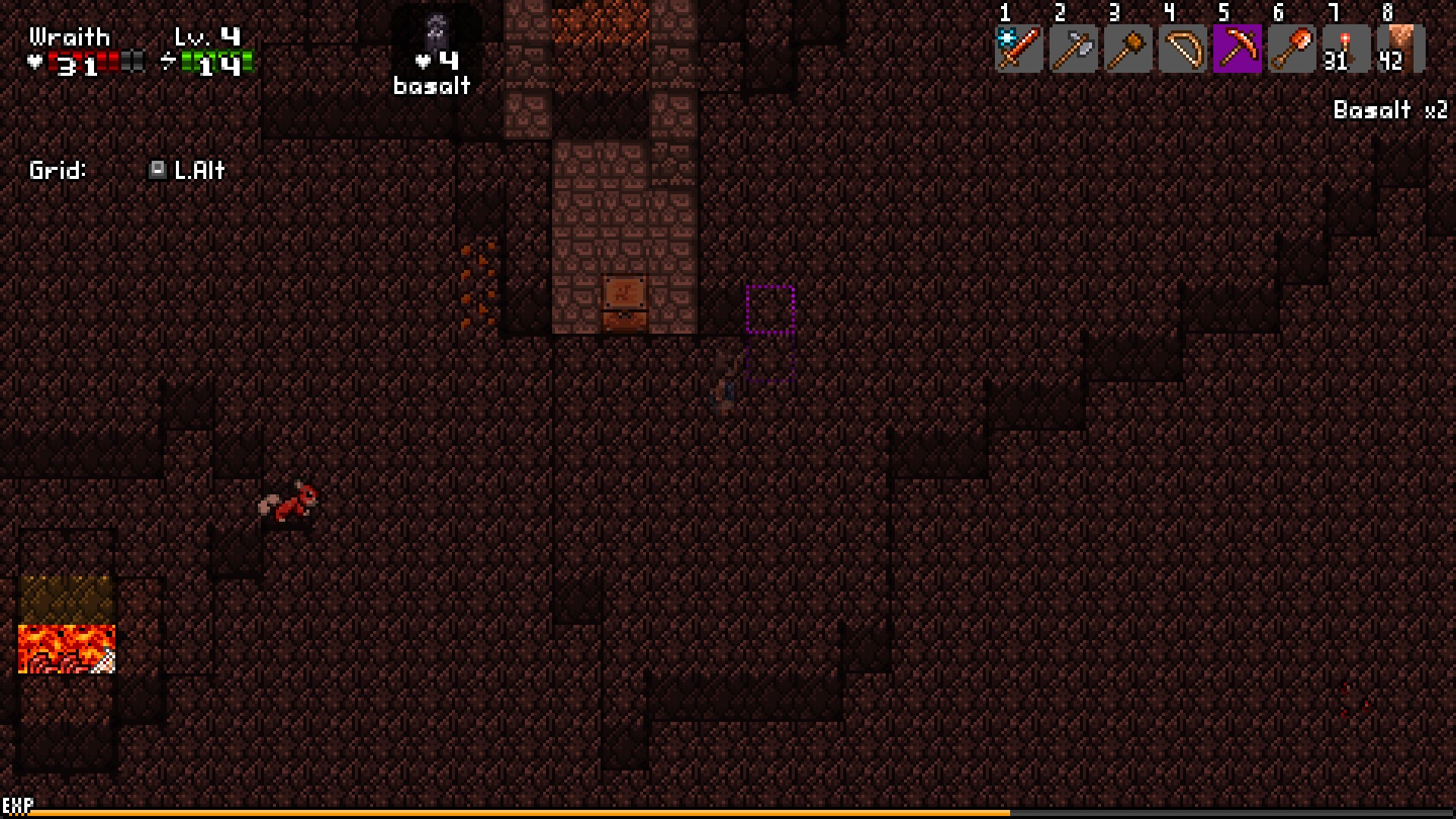
As previously mentioned, every setpiece tends to be the same, so a player who has seen this landmark before can guess where the missing content is, but it’s a serious problem for new players to come across a sea of lava, and be told to find the chest they cannot see because it’s buried in the lava or underneath one of the hundreds of indistinct slopes of basalt in the volcano.
Every game with procedural content has some sort of issue where the procedural content can clash with the scripted content (“setpiece” locations, in this case), but LandTraveller constantly has problems with them. More aggressive sanity checks are needed to stop the edge cases from outright ruining specific worlds. The volcano, as always, is the worst about this. In fact, there has been improvement on this front. In earlier versions, it was entirely possible for the volcano to be entirely flooded in lava, and entering the map put you inside a lava pool!
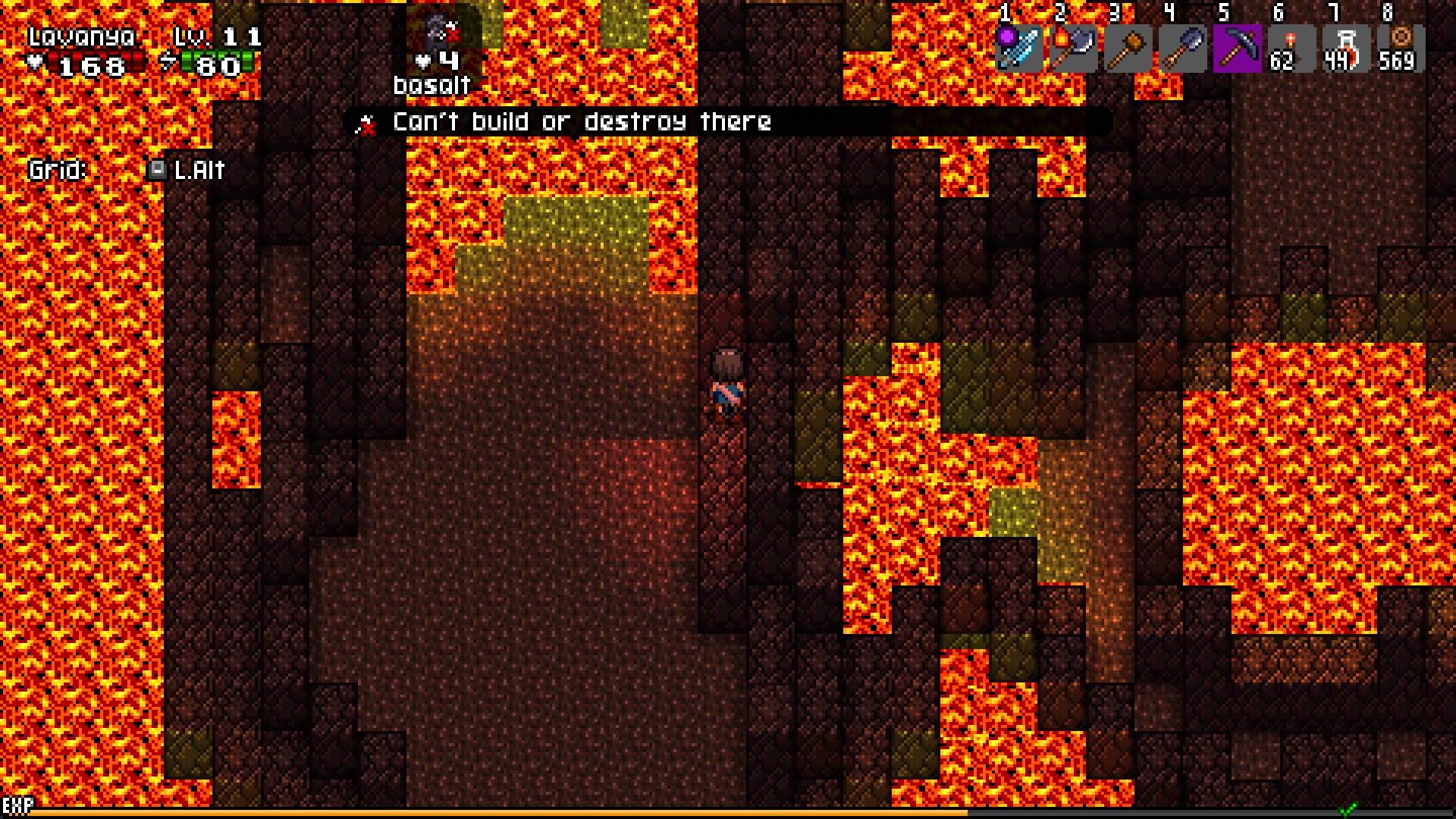
The procedural content generation needs more thorough sanity checks that don’t just plop a setpiece down on a random chunk of the map, but have the ability to alter nearby chunks to shore up any bodies of water, or at least recognize when something is a potential flood hazard and just raise the setpiece above sea level. (Likewise, there needs to be a check to raise the setpiece above the floor, so it isn’t buried, as well as force correct the terrain around the setpiece so as not to be a sudden pit or plateau.)
Finally, in explore mode, if one character consumes one of the limited records to learn a forgotten knowledge, all characters gain access to those crafting recipes. However, any character that wasn’t online at the time (such as any character you weren’t playing as in single-player explore mode) does not learn those recipes until they learn another recipe to update what they have, and they cannot learn an already unlocked technology, meaning that there’s a finite number of “updates” you can perform. This can significantly hinder how much a single world is reusable between explore mode runs.
Verdict
At its low starting price, and the amount of content it already provides, even if development stopped today, I could say that this is a game that is, at the very least, unique enough to be worth the asking price. Considering the potential length if the game is fully completed, it might be a real steal to keep in your library. (Perhaps the price will go up as it nears completion.)
LandTraveller is far from a perfect game, but it is an interesting one. It is a round peg modern sandbox game crammed into the square hole of a 16-bit console action RPG game. Where these manage to work together, it makes for a very good game, and even where they fail, they make at least an interesting argument about why genre conventions are the way they are.

